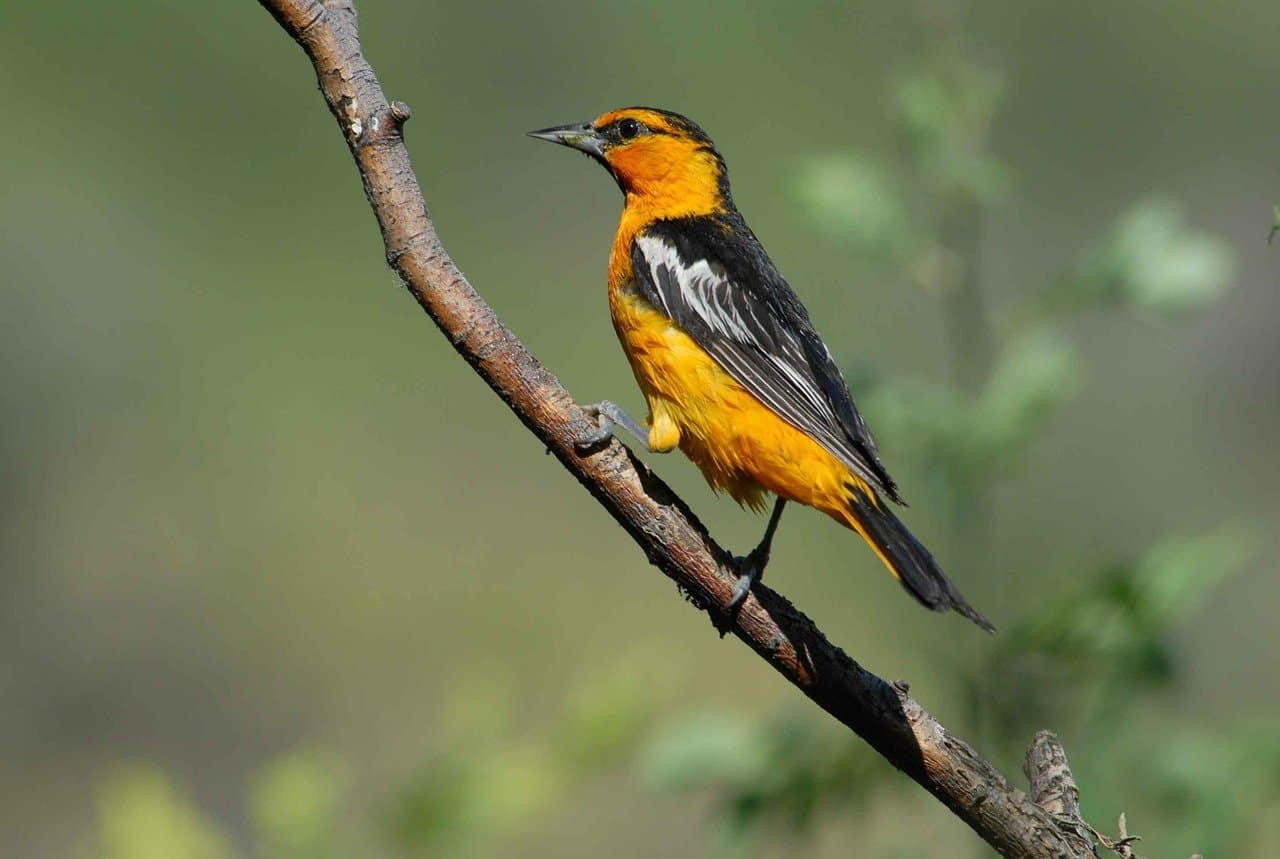You spotted a bird in Montana – but what type is it? There are more than 80 species of birds in Montana to enjoy and I’ve included them all in this complete list.
With more than 20 years of experience attracting backyard birds to my yard in Wisconsin, I’ve studied many of the birds in my area, many of which can also be found in Montana, so I have the information you’re looking for. For the remaining species, I rely on my field guides and friends at The Cornell Lab of Ornithology to guide me.
This article includes the species of wild birds you might find in and around a Montana backyard. They could be red, blue, brown or some other color. They could be tiny, small, medium, large, or enormous – all size variations are here!
Some wild birds live in Montana year-round, others are here to breed, and others are just migrating through. The range maps are color-coded so you know if it’s a year-round bird, there to breed, migrating through, or there during a nonbreeding time.

I also included a beautiful closeup photo to help you identify your new feathered friends along with detail such as:
- Size + appearance description
- Diet in the wild and at the feeder
- Habitat
- Nest & eggs description
- Range map
My hope is that this article will help you easily identify the bird you saw or plan to see one day.
American Kestrel
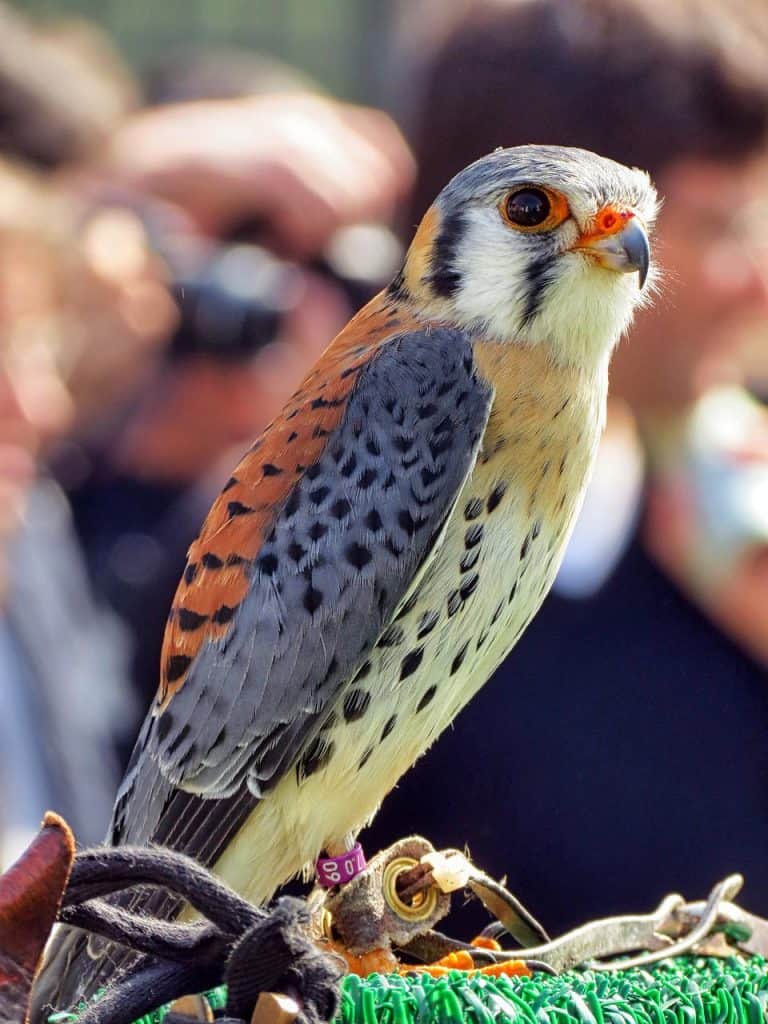
Appearance: The American kestrel is a small raptor at about 10 1/2″ in length. They have blue/gray wings, cinnamon back with black bars, cinnamon tail with a black bar near the tip, and tan underneath with dark spots. The female is the same except she has reddish-brown underparts and a tail with dark bars. And, her underparts have reddish streaks.
Diet: Large insects, lizards, rodents, and small birds.
Feeder food: They don’t visit feeders.
Habitat: Open areas especially rural and suburban fields.
Nesting: American kestrels nest in an old woodpecker hole or some other natural cavity. They have 1-2 broods/season and 4-5 eggs/brood. Eggs are white-yellow or light brown with spots. Incubation is for 29-30 days and fledglings leave the nest at 28-31 days.
Migration: American kestrels are migrators.
Year-round range: All US states except Montana, Wyoming, North Dakota, South Dakota, Minnesota, Wisconsin, Michigan, and Maine.
Breeding range: Canada and Alaska.
Winter range: While some American kestrels migrate south to southern Texas, Louisiana, and Mexico, many remain in their year-round range when the snow flies.
Range Map
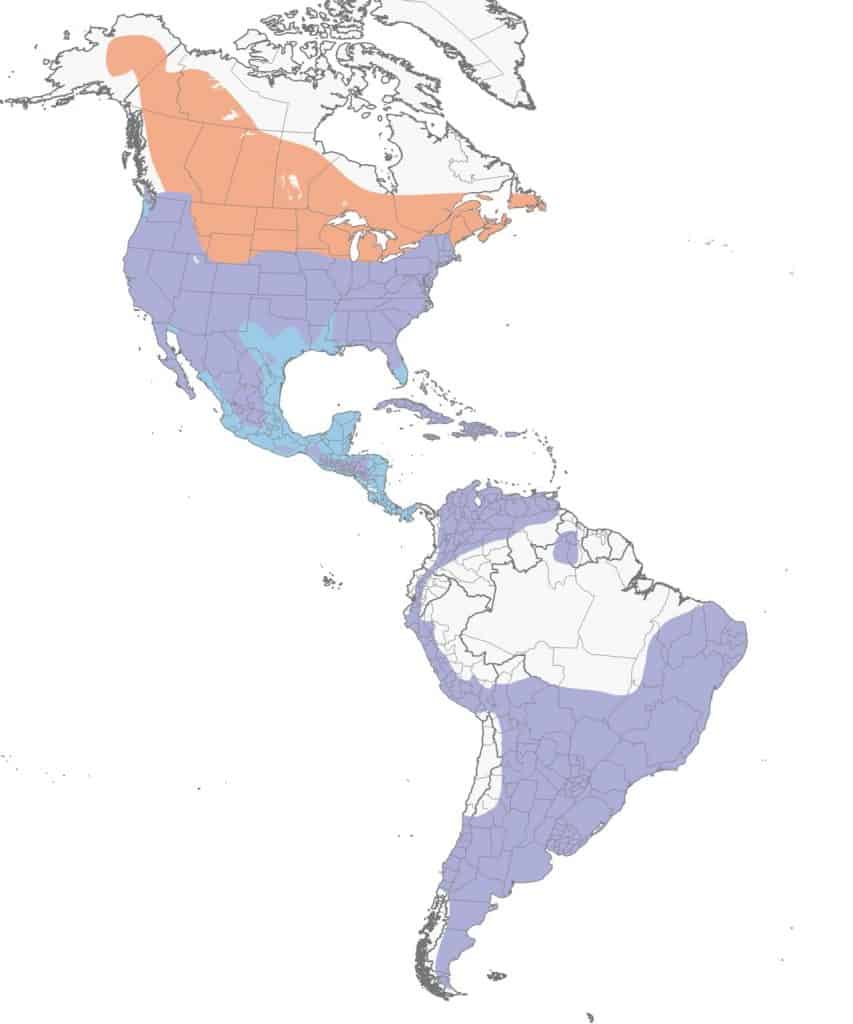
American Three-Toed Woodpecker
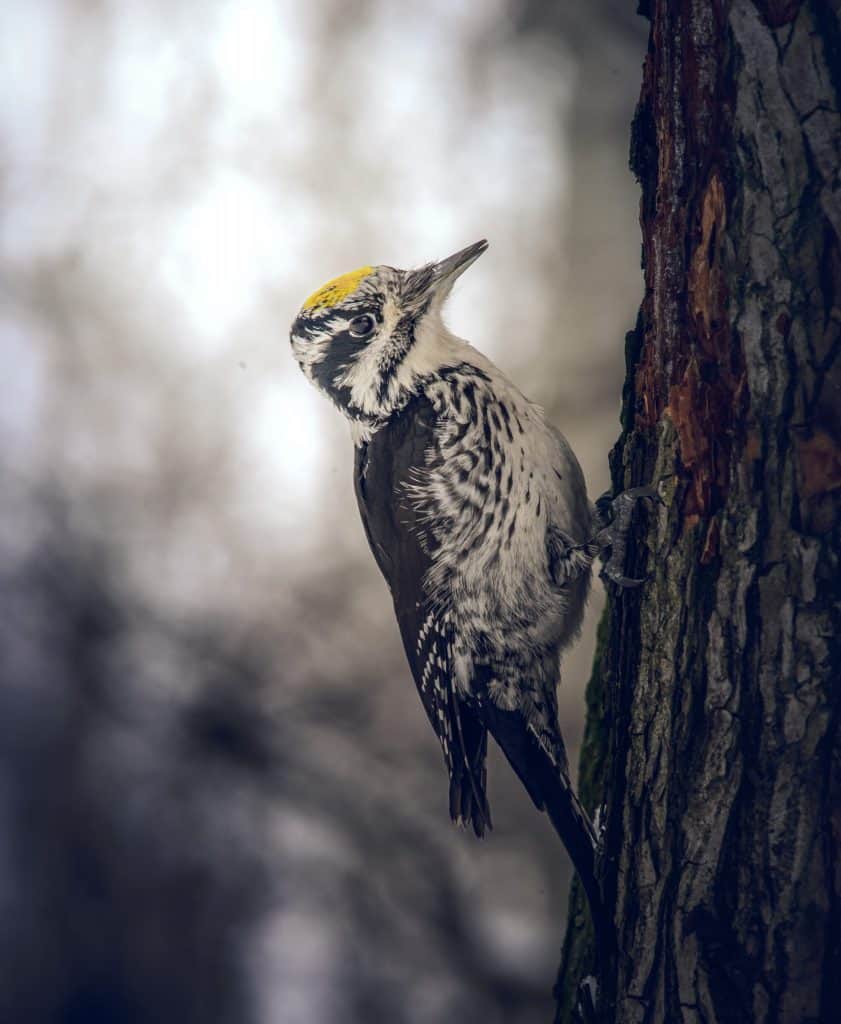
Appearance: The American three-toed woodpecker is a medium-sized bird about 8-9″ long. They’re mostly black with white spots on their wings and belly. The throat is white, white stripe behind each eye and across the bill from one side of the head to the other, and an unmistakable yellow patch on the crown. And of course, they’re equipped with three toes instead of the typical 4 toes. The bill is relatively long and pointed, although sometimes feather tuffs near the base of the bill give the appearance of a shorter bill.
Females are similar except instead of a yellow crown theirs is black and white specked. Also, her belly is more white than black and the females are about 10% smaller than males.
Juveniles look a lot like females but have shorter bills and a bit duller plumage overall.
Diet: Insects (especially beetle larvae and ants), cambium (layer of the tree beneath the bark), and tree sap.
Feeder Food: Very rarely will visit a feeder for suet.
Habitat: Coniferous forests (spruces and pines), as well as mature hardwood forests, and swamps. Fond of burn areas (3+ years after the burn), and flooded forests which are abundant in insects.
Nesting: American three-toed woodpeckers are cavity nesters. They prefer to excavate their own hole in coniferous and deciduous snags (dead) rather than live threes – especially the rotted ones. They have 1 brood/season, 3-7 white & rounded eggs/brood, and incubation is 12-14 days.
Migration: American three-toed woodpeckers are not migrators. They make their year-round home in non-coastal areas throughout Canada, as well as Alaska, Washington, Oregon, Idaho, Montana, Wyoming, Utah, and Colorado. Although they’re scarcely found in the following states, you still have a chance of spotting one: Minnesota, Arizona, and New Mexico.
Range Map
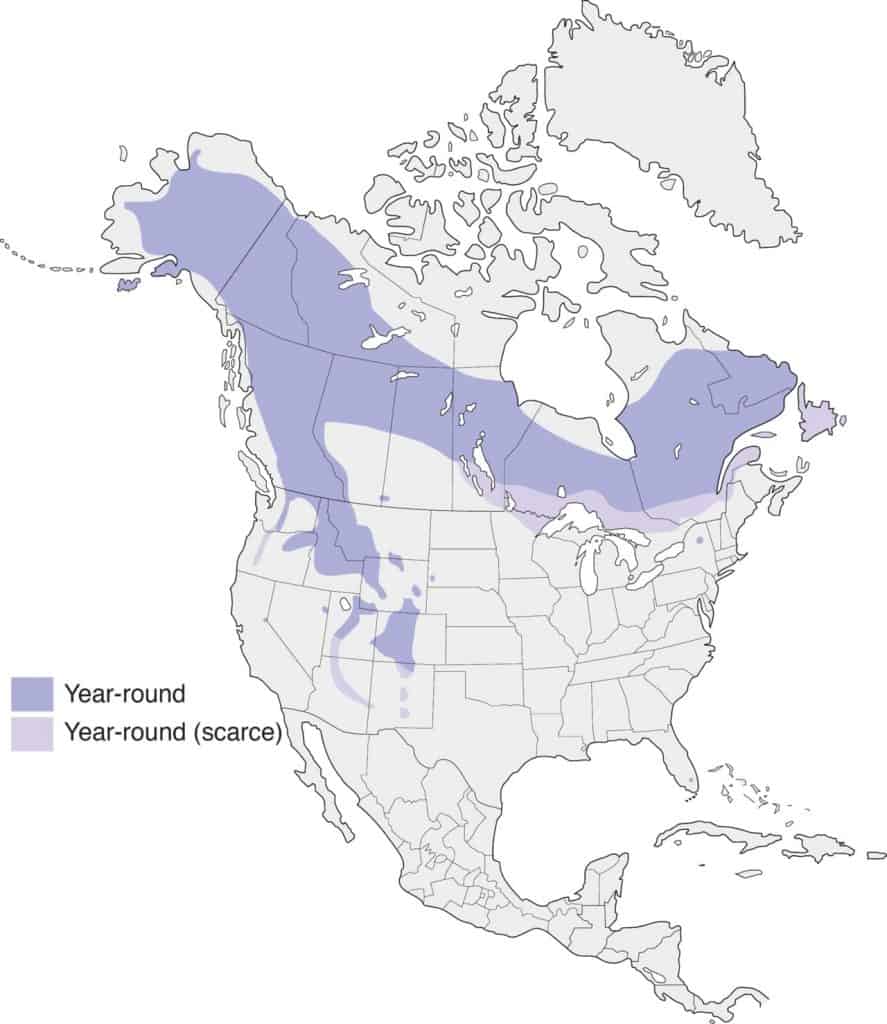
Barn Swallow
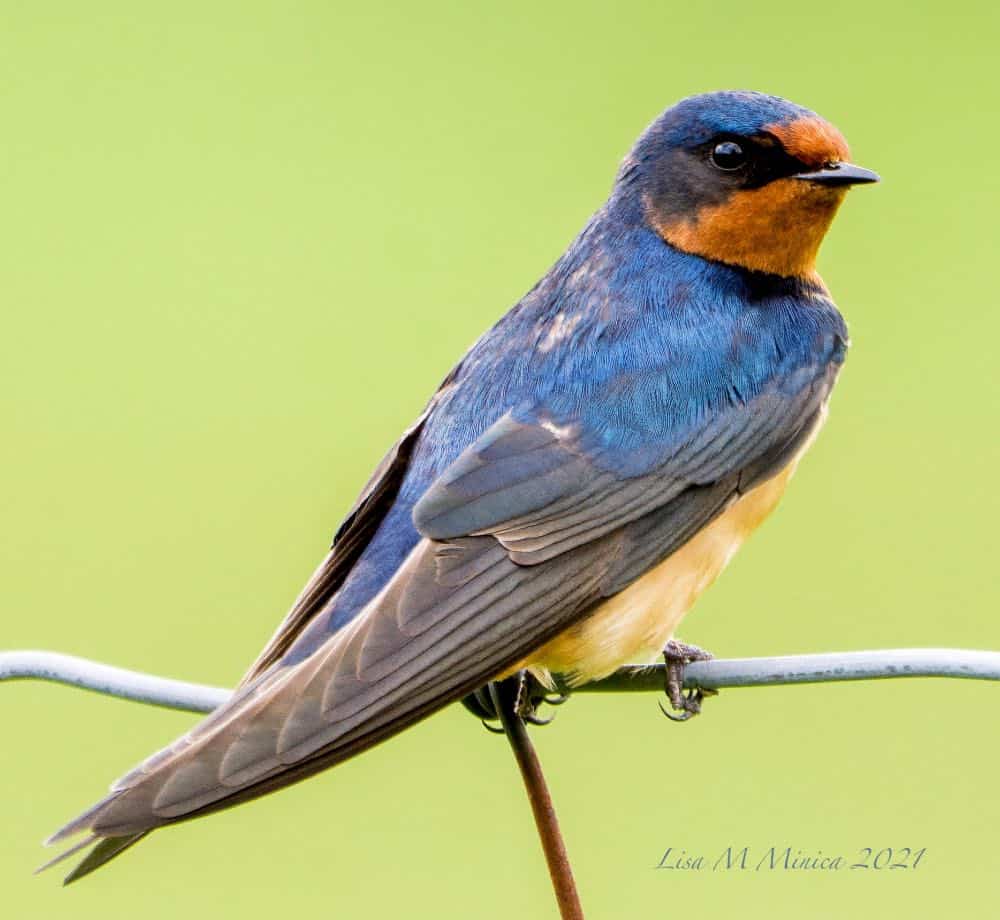
Appearance: 7″ long, steel blue glossy on top, chestnut forehead and throat, and rust-orange underparts. Long forked tail with a white base. The female’s coloring is lighter and the tail shorter.
Diet: Insects, preferably beetles, wasps, and flies. Drinks by skimming the surface of the water.
Feeder food: Not likely to visit a feeder.
Habitat: Open fields and pastures.
Nesting: A barn swallow typically nests in or on a manmade structure such as a barn. Builds nests of mud. 2 broods/season, 4-5 eggs per brood, eggs are white with brown markings, incubation from 13-17 days.
Migration: Barn swallows are migrators. In spring, they’ll migrate north into the US and Canada for breeding and to raise their young. When fall comes, they’ll head south to Mexico’s southern states. That said, they do maintain a year-round range in central Mexico where they remain for every season.
Range Map
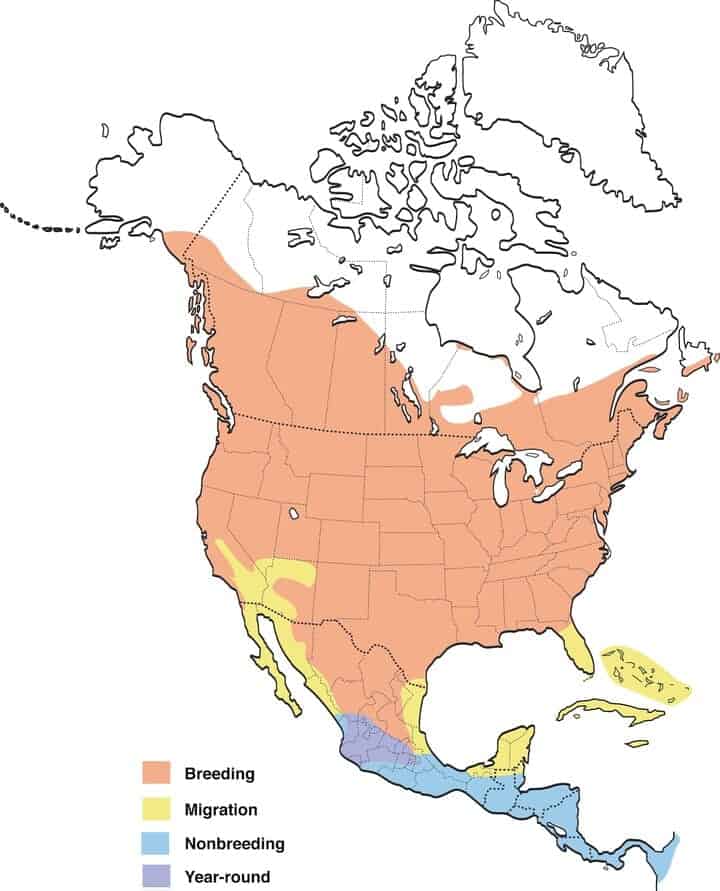
Belted Kingfisher
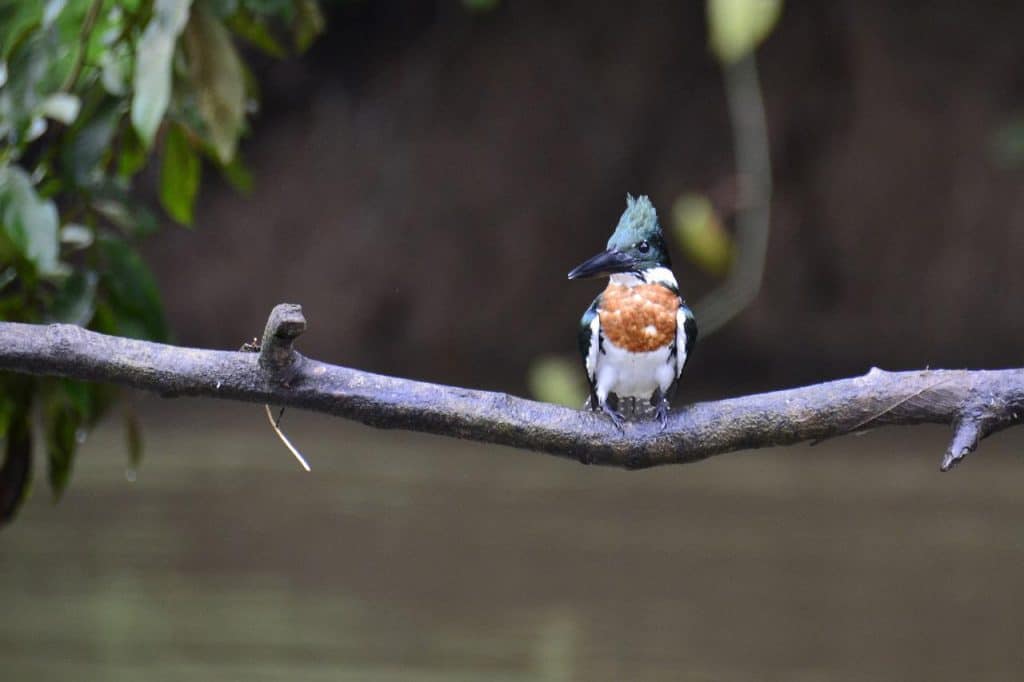
Appearance: The belted kingfisher is a large 13″ long bird with a large head, long bill, and stocky body. Blue/gray throughout with white ring around neck and white chest. The Female is the same but with an additional chestnut band on her chest.
Diet: Large 13″ long bird with a large head, long bill, and stocky body. Blue/gray throughout with white ring around neck and white chest. The Female is the same but with the additional chestnut band on the chest.
Feeder food: Unlikely to come to the feeder but often attracted to yards with streams or ponds.
Habitat: Near streams, rivers, ponds, lakes, and calm marine waters – especially unclouded water with little vegetation.
Nesting: Belted kingfishers dig burrows along the water’s edge for their nest. 1-2 broods/season, 5-8 eggs/brood – large white glossy eggs (1.5″ long), 22-24 days incubation.
Migration: Many but not all belted kingfishers are migrators. In spring, the migrators will head north into Montana, North Dakota, northern Minnesota, Canada, and Alaska to breed and raise their young. When fall comes the migrators head back south – as far south as Arizona, New Mexico, southern California, and Mexico.
Year-round range: All US states (except North Dakota and Arizona) and the pacific coast of Canada’s British Columbia.
Breeding range: While some stay in their year-round range, many others migrate north into Montana, North Dakota, northern Minnesota, Canada, and Alaska to breed and raise their young. When fall comes the migrators head back south – as far south as Arizona, New Mexico, and southern California.
Winter range: While many belted kingfishers migrate south for winter, just as many remain in their year-round range when the temperatures dip.
Range Map
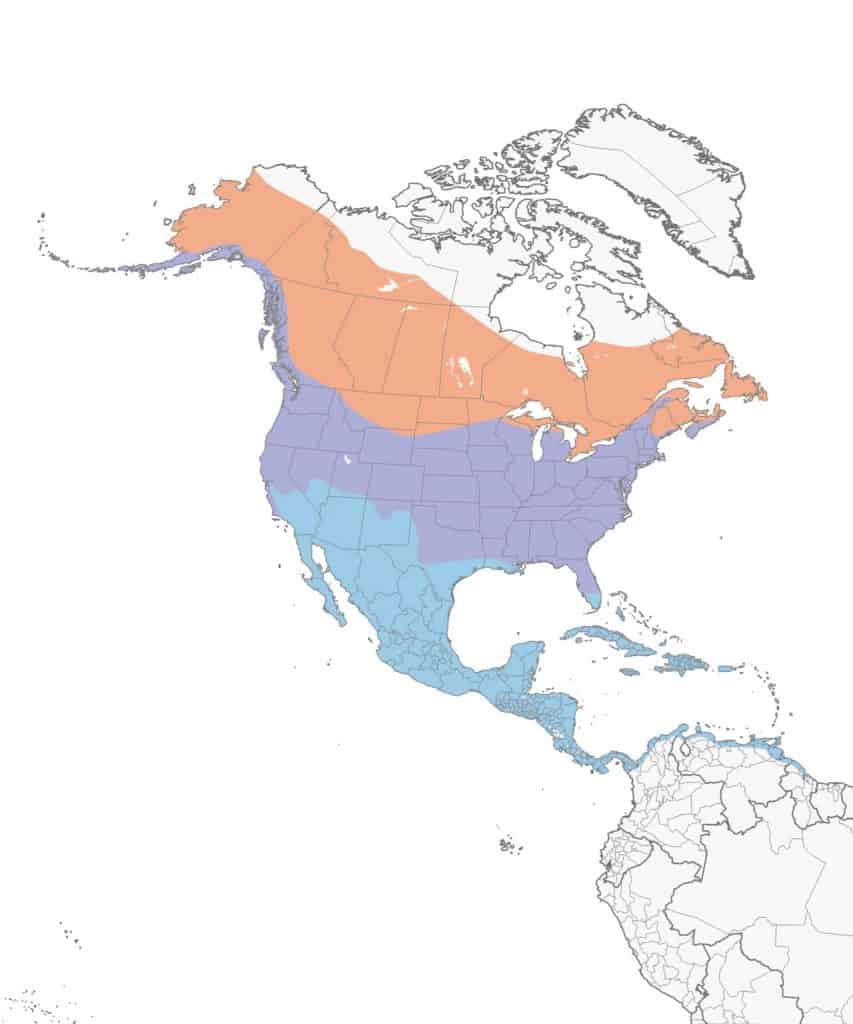
Blue Jay
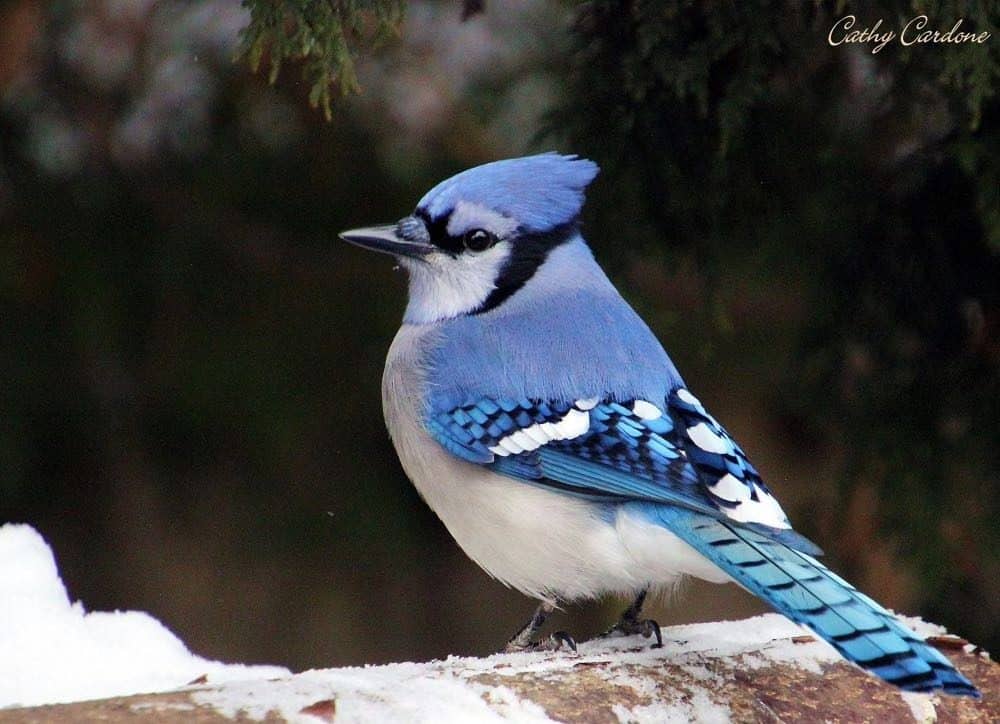
Appearance: Large bird 12″ long, medium blue & white body, blue crest (which he flattens at will), gray belly, and white face. White & blue wings with black spots. Females look the same.
Diet: Insects, fruit, seeds, nuts, other birds’ eggs, and nestlings.
Feeder food: Whole peanuts, sunflower seeds, and cracked corn.
Habitat: Forested areas with mixed tree types. Also common in suburbs and urban areas.
Nesting:
- Nest: bulky large nest made from twigs, bark, and mud resting on a tree branch about 5-50′ up.
- Broods: 1-2 broods/season,
- Clutch: 2-7 eggs/brood,
- Egg color: Pale blue to a light brown base color, and these eggs usually have brown or gray spots.
- Egg size: 1 inch by just under 1 inch
- Incubation: Both parents incubate the eggs for 17-18 days and the young fledge between 17-21 days.
Migration: In general, blue jays are not migrators. They remain in their year-round range for all 4 seasons – even during the breeding season. While they may move within their year-round range, they do not regularly head north for breeding and south for winter as some species do. That said, in rare cases, some will head west of their year-round range for the winter.
Range Map
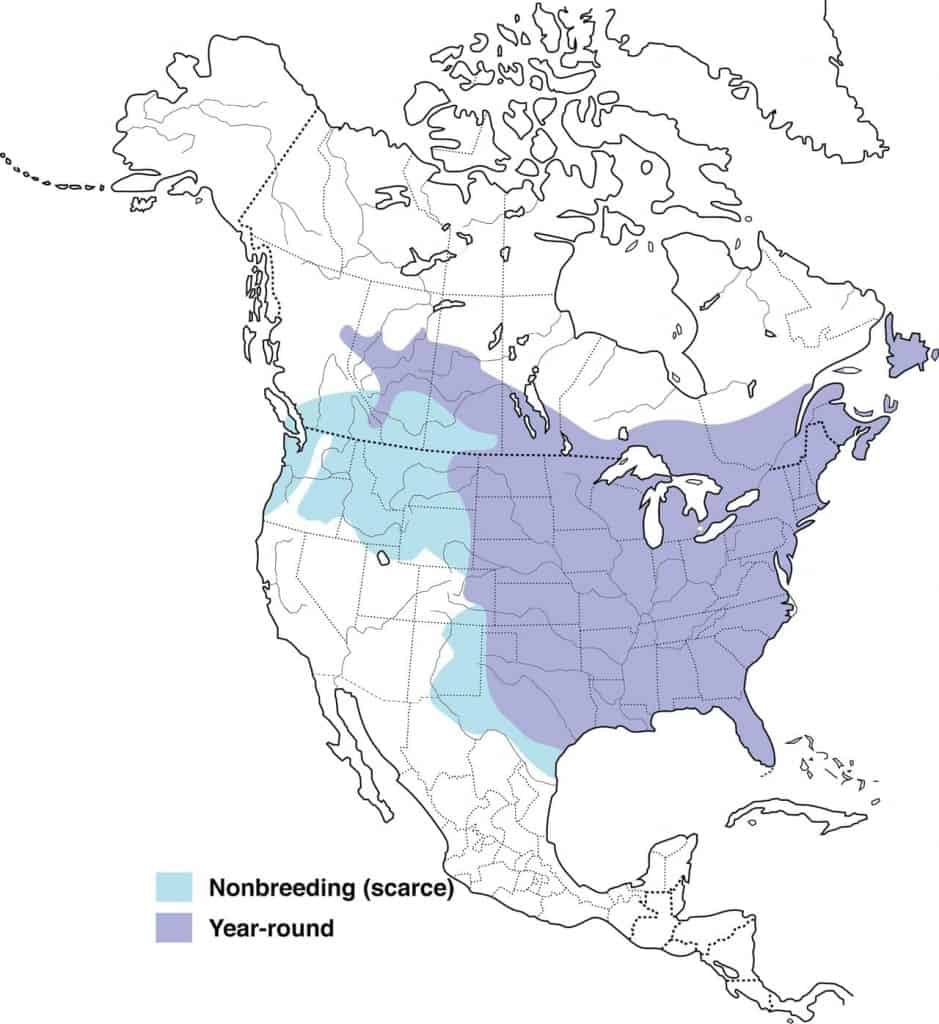
Brewer’s Blackbird
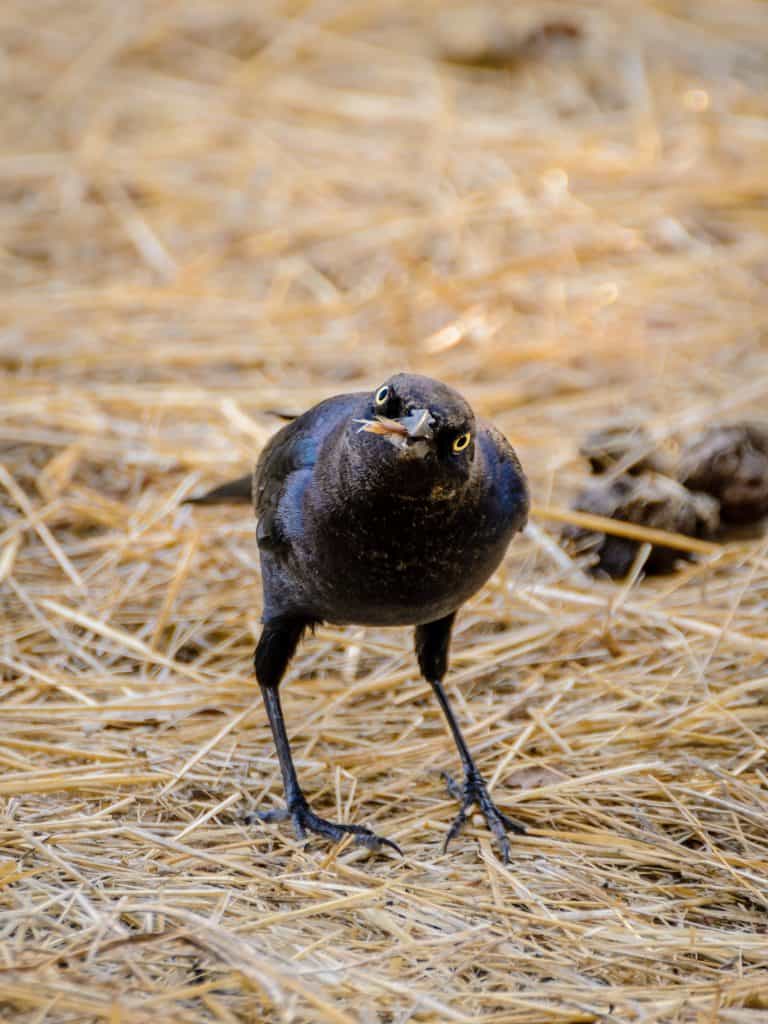
Diet: Insects, seeds, and berries.
Appearance: Brewer’s blackbird is a large bird about 9″ long. They’re all black with purple and green iridescence on the head and body. The female is dull gray/brown instead.
Feeder food: Any type of seed offered on a platform feeder or scattered on the ground.
Habitat: Inhabits a variety of habitats – open woodlands, mountain meadows, city sidewalks, and suburban backyards.
Nesting: They nest in a tree 20-40 feet up. The nest is a bulky cup shape comprised of twigs, grasses, and other plant material. They have 1-2 broods/season and 4-6 eggs/brood. The eggs are light gray to greenish/white and often spotted. Incubation is for 12-14 days and fledglings leave the nest at 13-14 days.
Migration: Brewer’s blackbirds are migrators. While some remain in their year-round range for all four seasons, many head north and east in the spring for breeding and raising their young. Then in the fall, they’ll return or head further south in the southern half of the US or Mexico.
Year-round range: Western US states and Canada’s British Columbia.
Breeding range: Montana, Wyoming, Colorado, and Canada’s British Columbia, Alberta, Saskatchewan, Manitoba, and Ontario.
Winter range: US states south of Kansas, Mexico, and the western part of Canada’s British Columbia.
Range Map
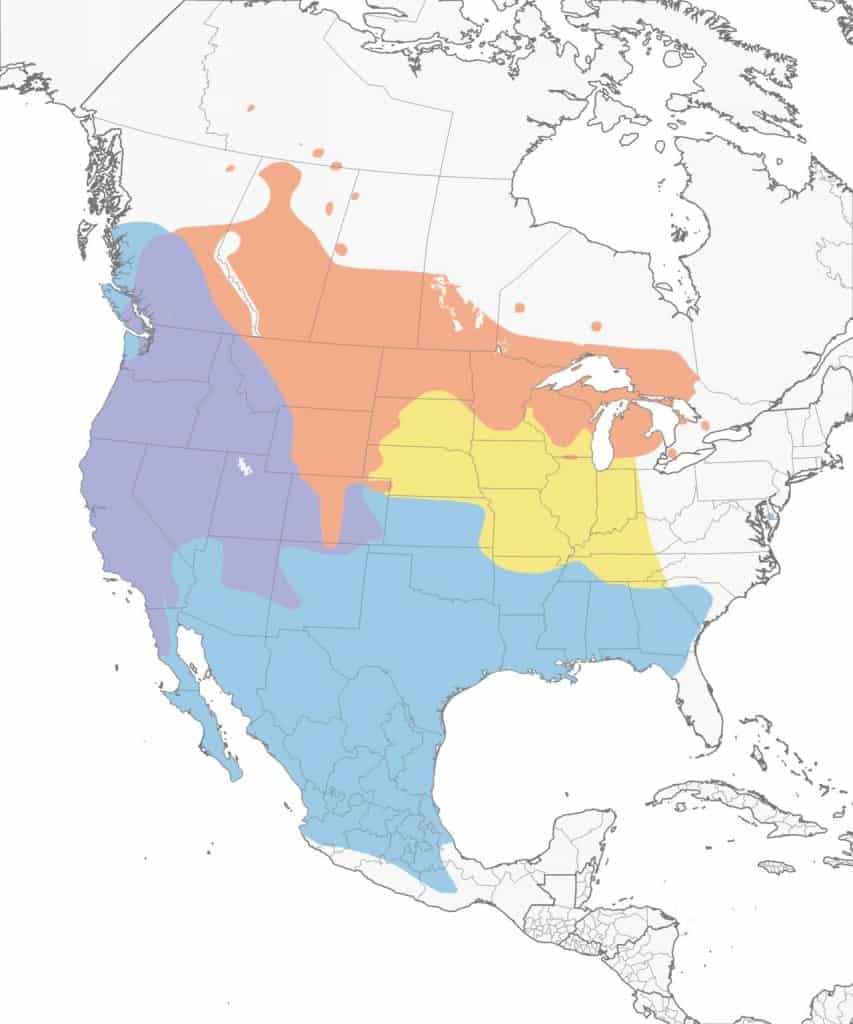
Bullock’s Oriole
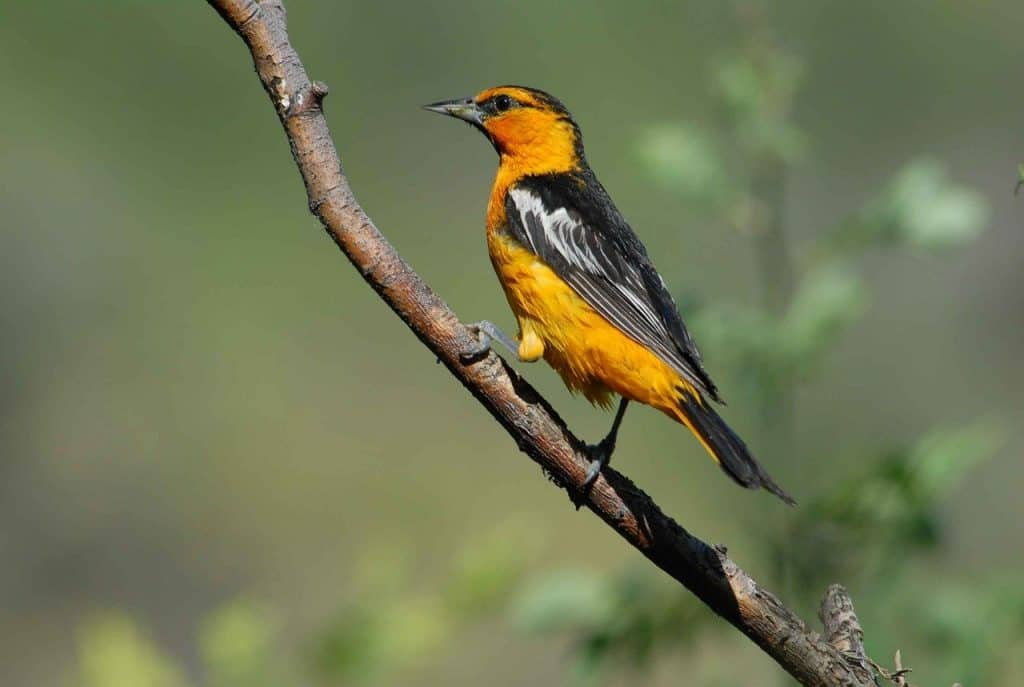
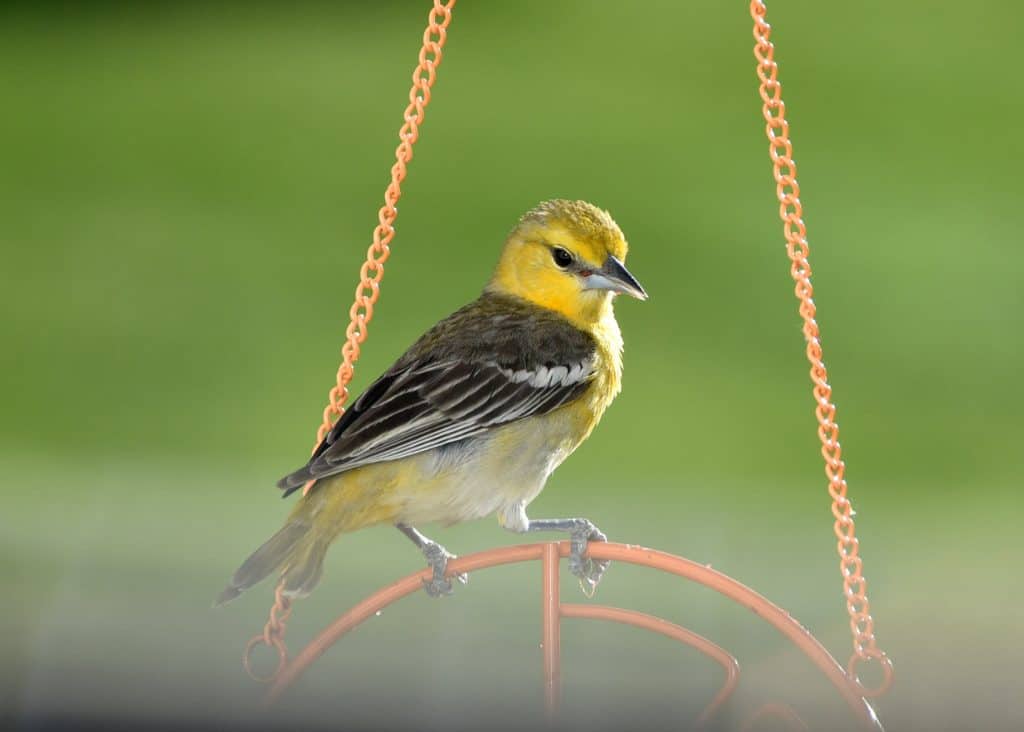
| Appearance | The Bullock’s oriole is a medium-sized bird about 8″ long. They’re orange with a black crown, eye stripes, throat, back, and wings (+ white wingbars). During the first spring, a juvenile male is more yellow-orange with a black mask and throat. The female is yellow with a dark stripe through the middle her eyes, and grayish-black only on her wings. White wingbars accent the black. |
| Diet | Insects, spiders, fruits, and nectar. |
| Feeder Food | Cut fruit, jelly, or nectar. |
| Habitat | Open wooded areas especially along riverbanks. |
| Nesting | Bullock’s orioles build a hanging pouch style nest about 10-20′ high in a tree or shrub and is suspended from a forked branch. They have 4-5 eggs/brood that are incubated for 11-14 days. The eggs are pale blue/white with purplish-brown spots. Fledglings leave the nest at about 14 days. |
Range Map
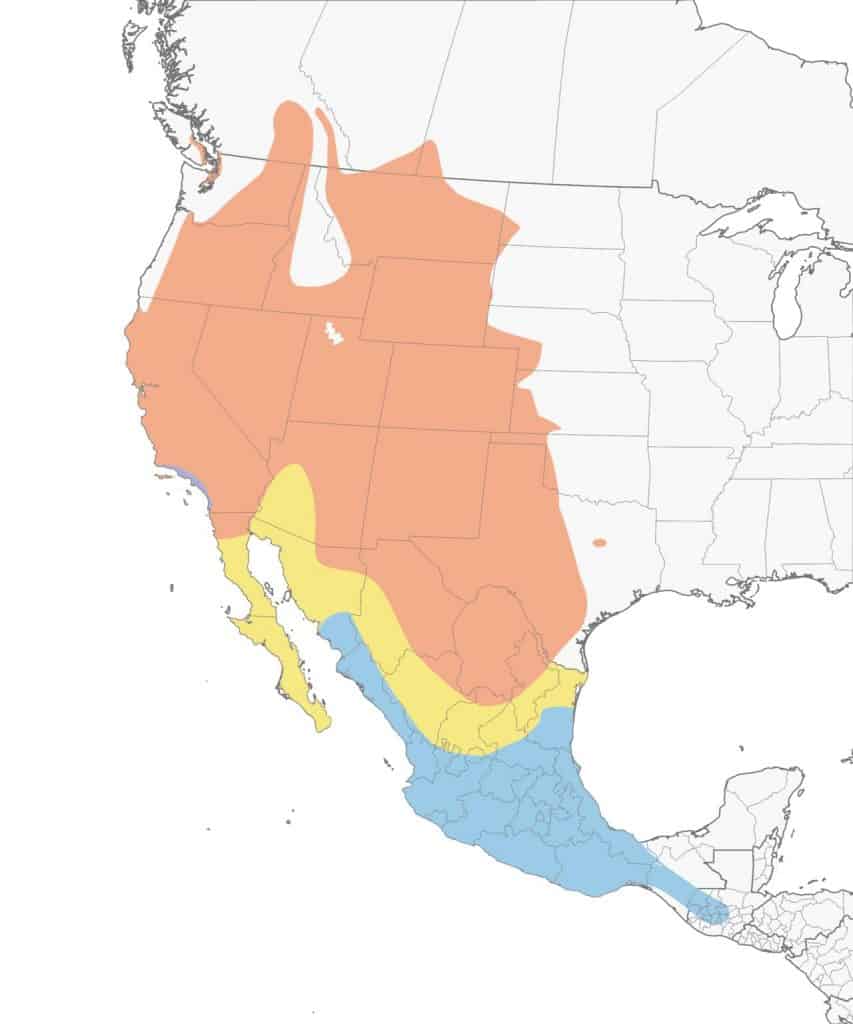
Cassin’s Finch
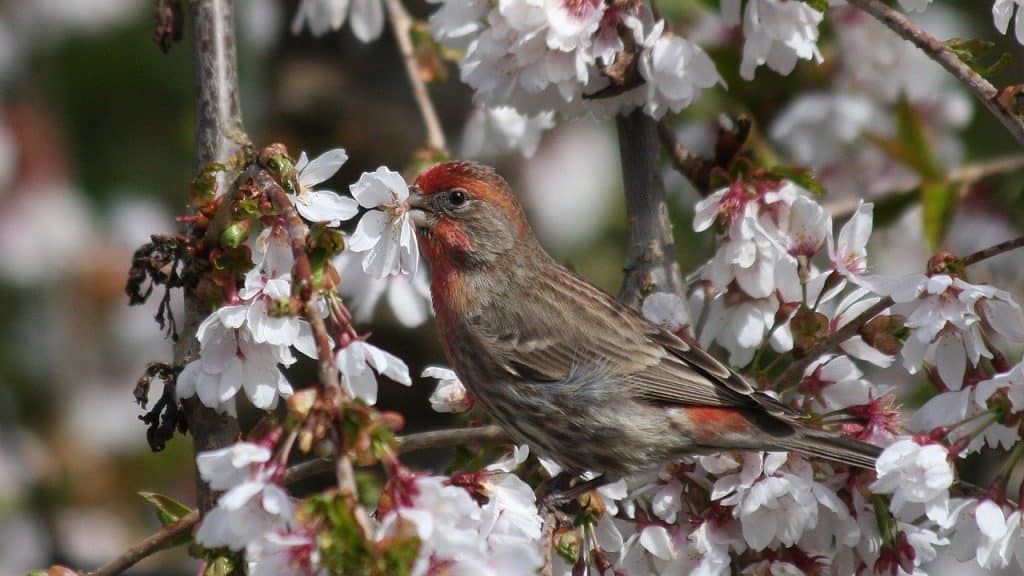
| Appearance | The Cassin’s finch is a small bird about 6 1/4″ long. They’re brown with a red cap, brown stripe across their cheeks, and white underneath with light pink streaks on the chest. The female is similar except she doesn’t have red or pink. her chest and belly are heavily streaked brown and she has a white streak above and over her eyes. |
| Diet | Seeds, buds, and berries. Occasionally insects. |
| Feeder Food | Black-oil sunflower seeds. |
| Habitat | Open forested areas rich with conifers. |
| Nesting | Nest: They build a nest high up in a conifer – about 30+ feet up. Broods: 4-5 eggs/brood Clutch: 3-6 eggs/brood Egg color: Light bluish with black, brown, and purplish speckles Egg size: 0.7 – 0.8 inches by 0.5 – 0.6 inches Incubation: 12-14 days. |
Range Map
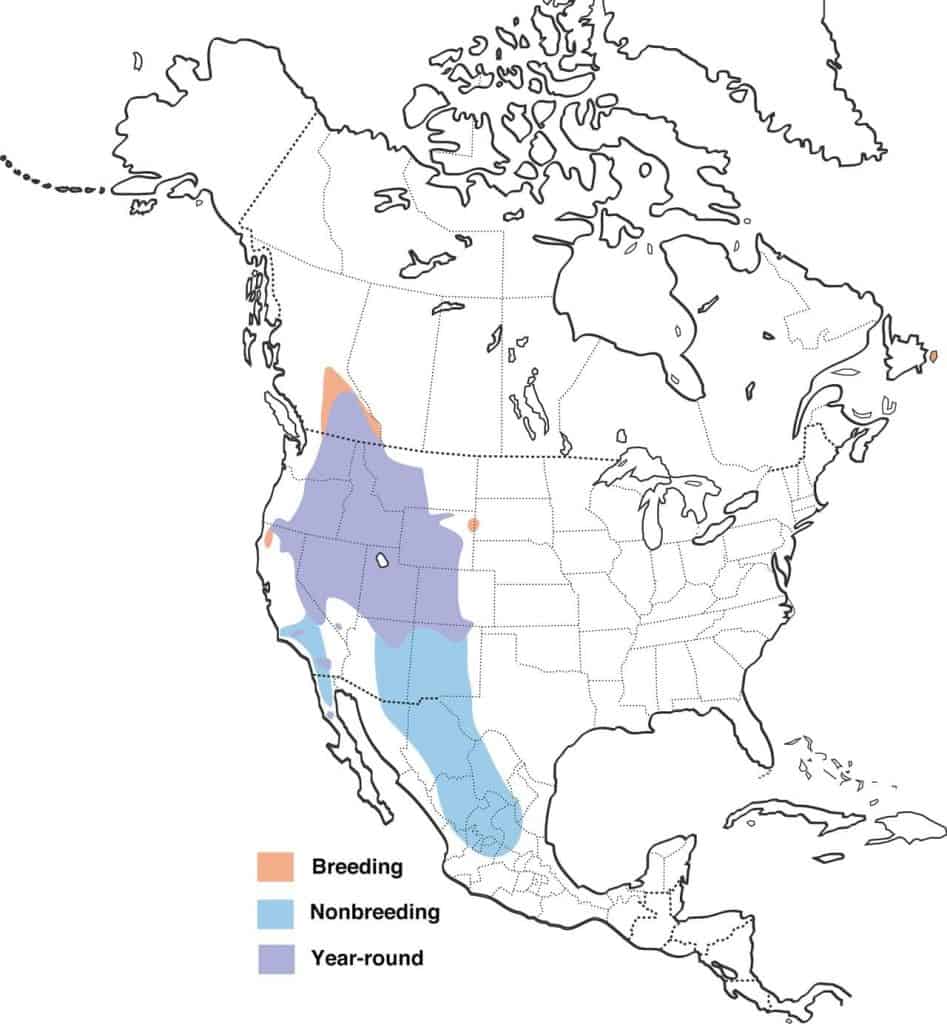
Chipping Sparrow
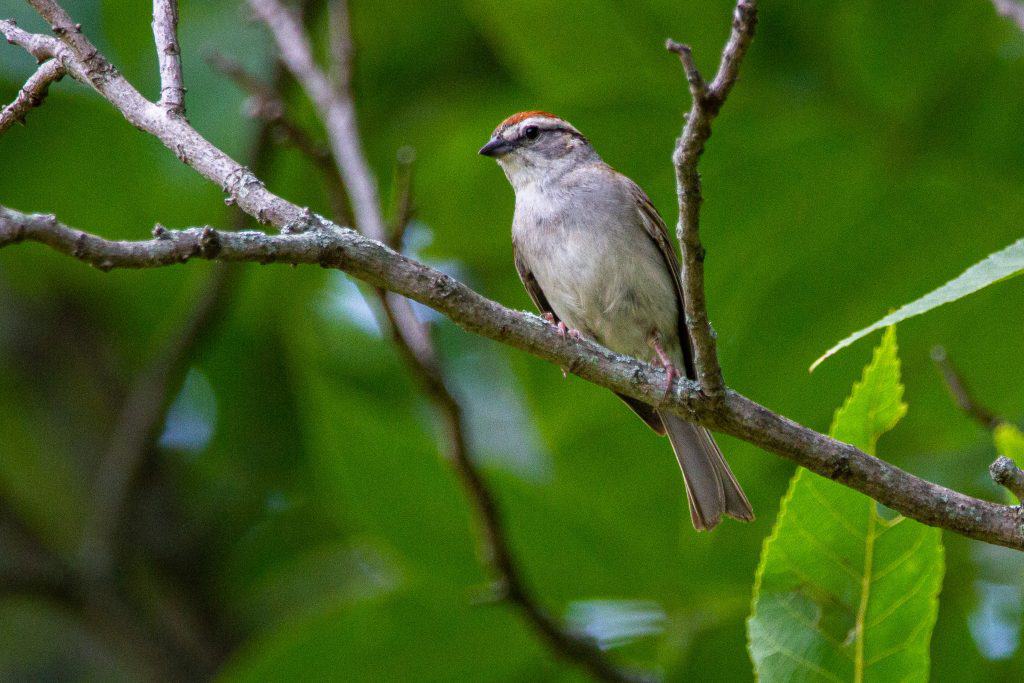
Appearance: The chipping sparrow is a small bird about 5″ long, gray/brown with a light gray chest and rusty crown. Eyes have white eyebrows with a black eye lining, a thin gray-black bill, and 2 wing bars. Males and females look the same.
Diet: Insects and seeds.
Feeder food: Black-oil sunflower seed, mixed seeds. Mostly a ground feeder.
Habitat: Open areas and edges of woodlands.
Nesting: The nest is placed low in dense shrubs. They have 2 broods/year and 3-5 eggs/brood that are blue/green with brown markings. Incubation lasts 11-14 days.
Migration: Chipping sparrows are migrators. In spring they migrate north into every US state and Canadian province o breed and raise their young. Then in the fall, they head back south to southern California, Arizona, Florida, Georgia, Mexico, and the Caribbean islands for winter.
Breeding range: All US states and Canadian provinces.
Winter range: Southeastern California, southwestern Arizona, the pacific coasts of Mexico, Florida, southwestern Georgia, and the Caribbean island.
Year-round range: A population of the birds remains in their year-round range in central to southern California as well as parts of Central America.
Range Map
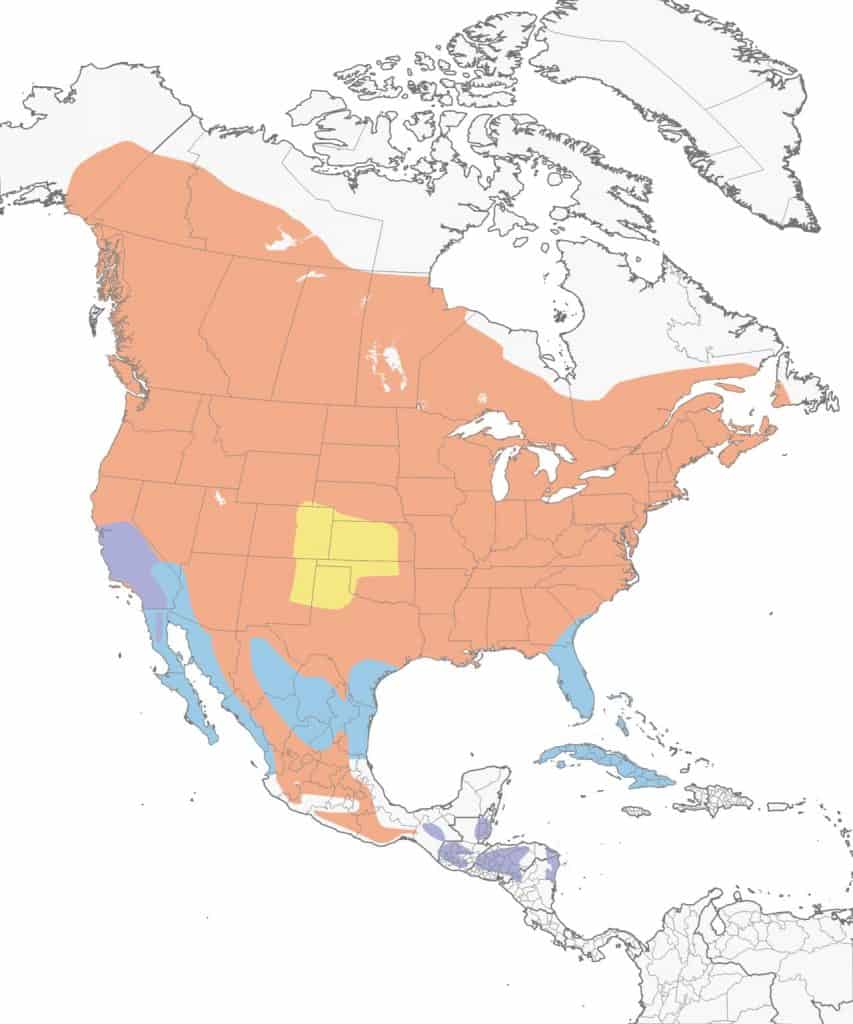
Common Grackle
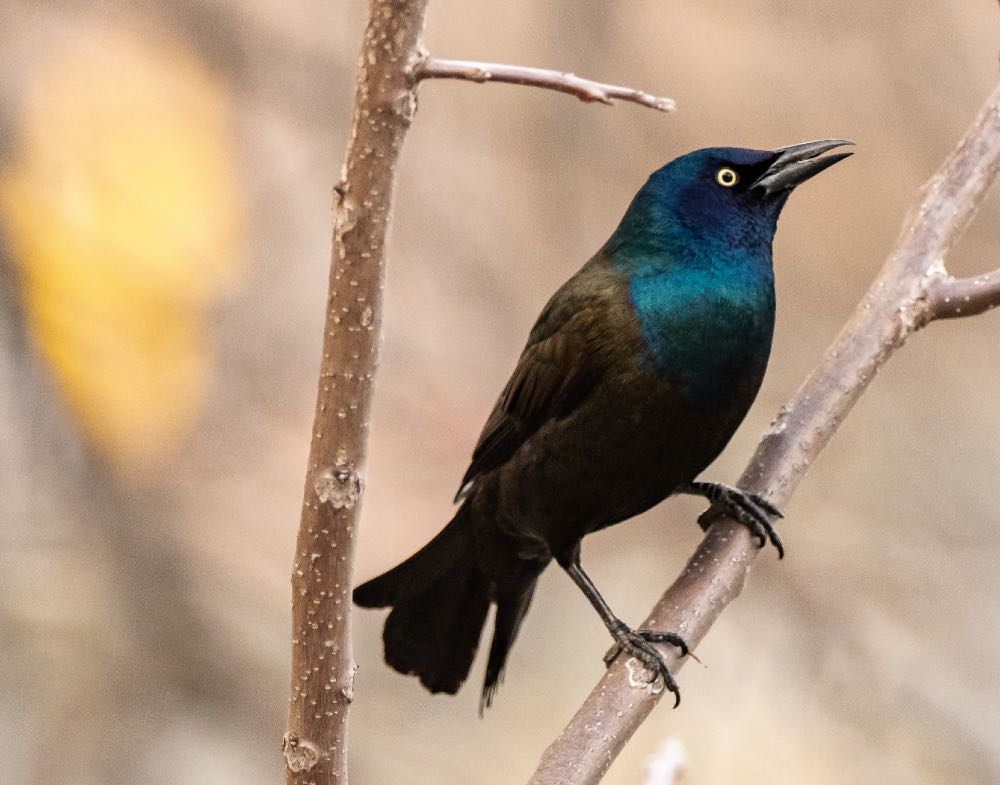
Appearance: The common grackle is a large bird about 12.5″ long bird with iridescent blue purple and bronze. Their eyes are yellow and they have long flared tails. The female is similar with less vibrant coloring (browner) and a shorter tail.
Diet: Insects, grains, seeds, fruit, scavenged garbage.
Feeder food: Sunflower seeds, black-oil sunflower seeds.
Habitat: Fields with scattered trees, open woodlands, farmlands, and marshes. Common in suburban yards.
Nesting: Bulky cup-shaped nest of twigs placed 3-20′ high in a conifer tree. 3-5 eggs incubated for 12-15 days. Young fledge at about 12-15 days.
Migration: Common grackles are migrators. While many remain in their year-round range all four seasons, many head north in spring (as far north as Canada’s Northwest Territories) to breed and raise their young. Then in the fall, they head back south into their year-round range. A small part of the population pushes further southwest of Texas.
Year-round range: Nebraska and the US states south and east of it. US states
Breeding range: Montana, Idaho, Wyoming, Colorado, New Mexico, North Dakota, South Dakota, Kansas, western Kansas, Minnesota, Wisconsin, Michigan, the New England states, and all Canadian provinces (except for Nunavut and barely British Columbia).
Winter range: Southwest edge of their Texas year-round range.
Range Map
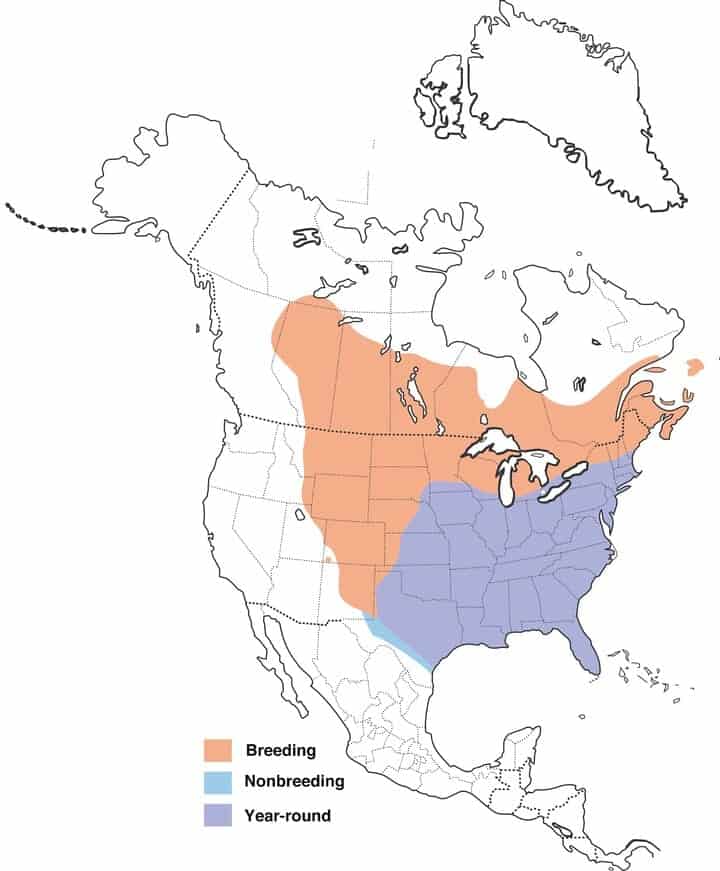
Dark-Eyed Junco
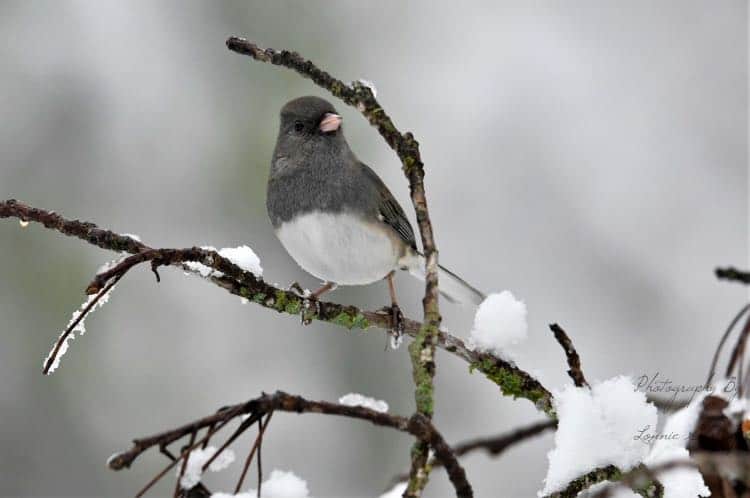
Appearance: Dark-eyed juncos are tiny birds about 5.5″ – 6.5″ long. Males are dark gray with a white underside and pink bill. Females are the same except brownish gray.
Diet: Insects, spiders, seeds.
Feeder food: Nyjer, black-oil sunflower seeds, hulled sunflower seeds, safflower seeds, cracked corn, hulled peanuts, and suet.
Habitat: Juncos are found across the US and Canada so can be found in a variety of habitats including forested areas (both coniferous and deciduous), wide-open spaces, partially wooded edges, parks, and backyards.
Nesting: Nests are located in a variety of locations from ground-level surrounded by vegetation to in a hanging basket. They have 1-3 broods/season, 3-6 eggs per brood that can be any of these colors: White, gray, pale bluish-white, or pale-greenish white speckled with brown, gray, and green. Occasionally unmarked. Incubation lasts 9-13 days.
Migration: Dark-eyed juncos are partial migrators. Some remain in their year-round range all seasons of the year while others migrate north in spring and south for the winter.
Year-round range: Southern Alaska, Washington, Oregon, Idaho, Montana, Wyoming, Utah, California, Nevada, Colorado, Arizona, New Mexico, northern Minnesota, Wisconsin & Michigan, Pennsylvania, New York, New England, and British Columbia & Alberta in Canada.
Breeding range: Alaska and Canada.
Winter range: The remaining US states (outside the year-round range above), southeast Alberta, southern Saskatchewan, far southeast Ontario, and Mexico.
Range Map
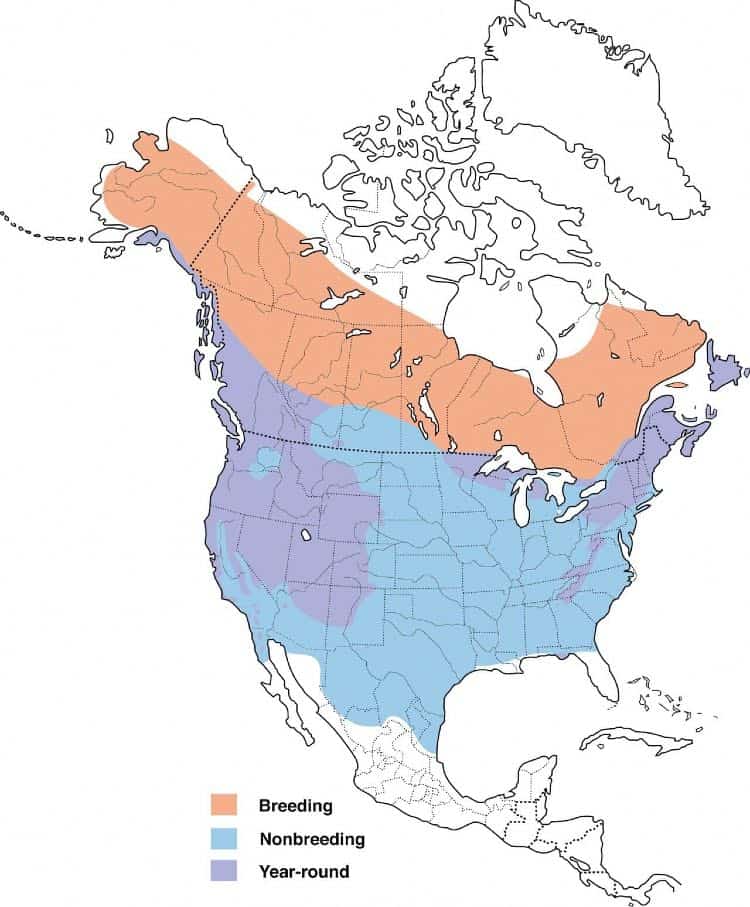
Want to see dark-eyed juncos in your yard? Check out my article: 7 Proven Ways to Attract Dark-Eyed Juncos.
Eastern Bluebird
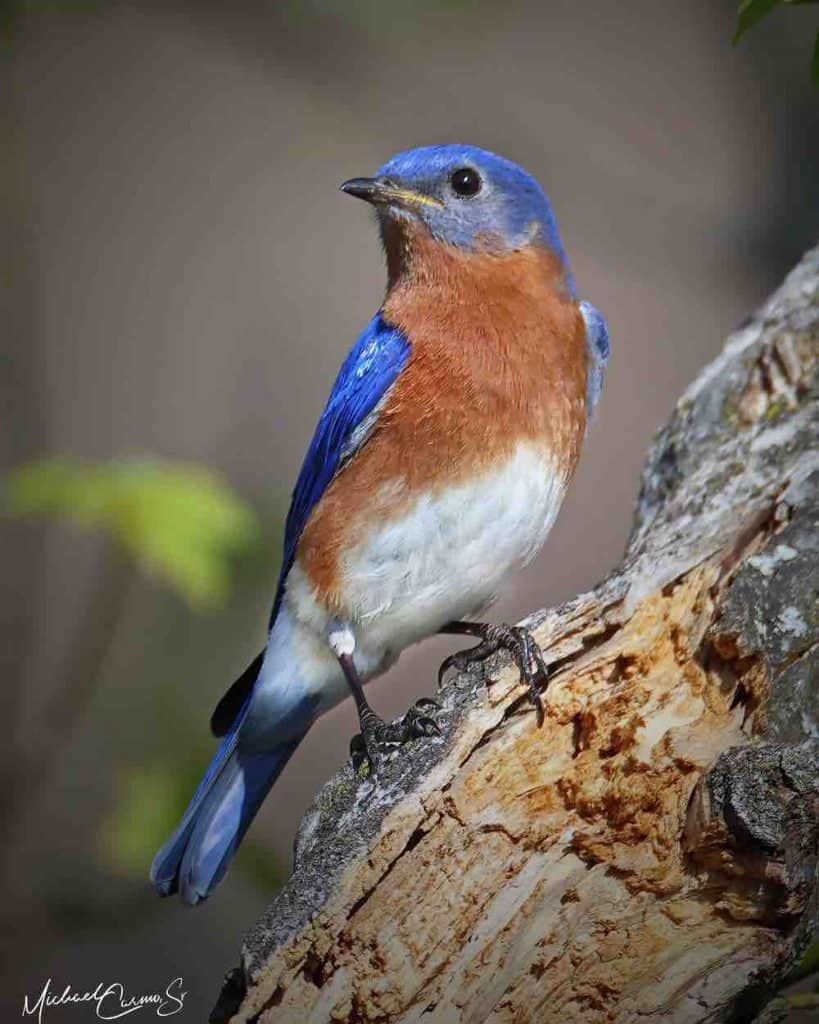
Appearance: Eastern bluebirds are small birds about 7″ long, royal blue, orange throat & breast, white belly & undertail. Female is similar but with more muted colors
Diet: Insects & spiders in spring/summer. Small fruit in Fall/Winter.
Feeder food: Suet, sunflower seeds, dried fruit, jelly.
Habitat: Wide-open spaces, fields, meadows.
Nesting:
- Nest: Cavity nesters. The male bluebird determines the nest site (an old woodpecker hole in a tree or manmade nestbox), but the female is the one who builds the nest. She keeps the nest for multiple broods.
- Brood: 2-7 broods/season
- Clutch: 4-5 eggs/brood
- Egg color: Pale blue eggs (sometimes white) with no blemishes or discoloration.
- Egg size: 0.9 inches by 0.8 inches
- Incubation: 11-19 days
Migration: Some eastern bluebirds are migrators. While many remain in their year-round range all year long, some migrate north for breeding and raising their young then head south in winter back into the year-round range or further west into Colorado, New Mexico, and western Texas.
Year-round range: The US states south and east of Nebraska, Mexico, and Central America.
Breeding range: Northwest Nebraska, South Dakota, North Dakota, Minnesota, the northern half of Wisconsin & Michigan, New Hampshire, Maine, and the southern part of these Canadian provinces: Saskatchewan, Manitoba, Ontario, and Quebec.
Winter range: Eastern Colorado, New Mexico, western Texas, and northeast Mexico.
Range Map
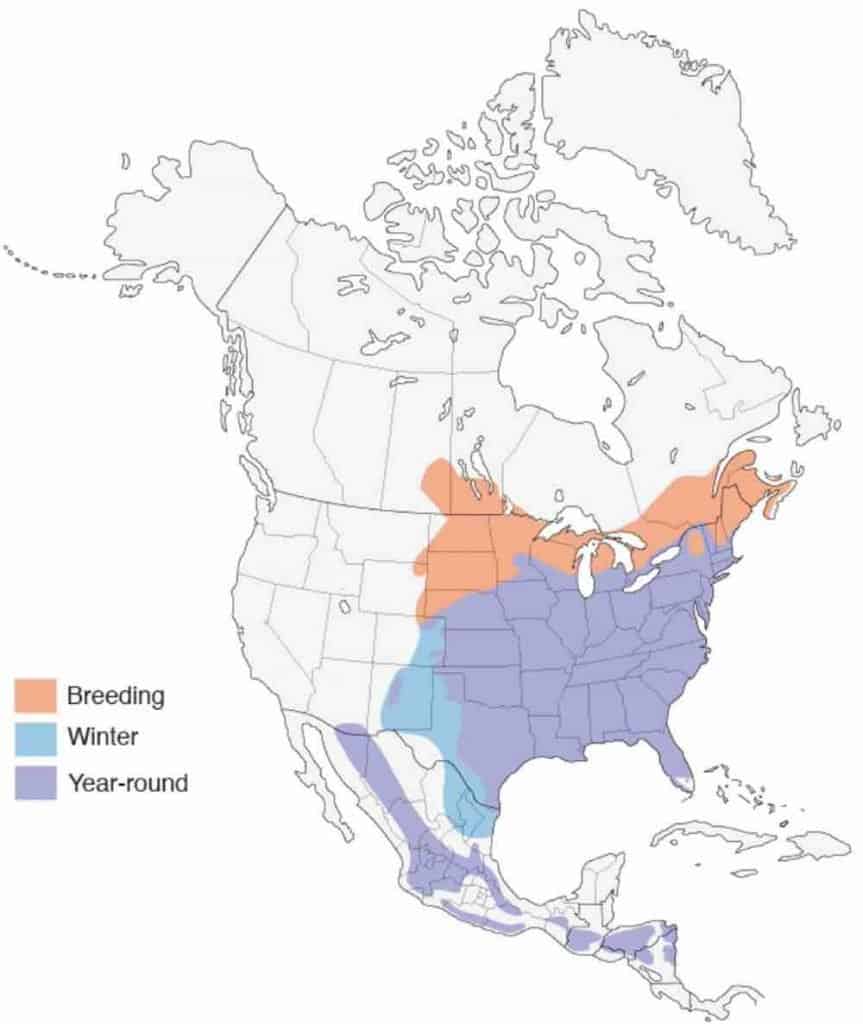
Eurasian Collared-Dove
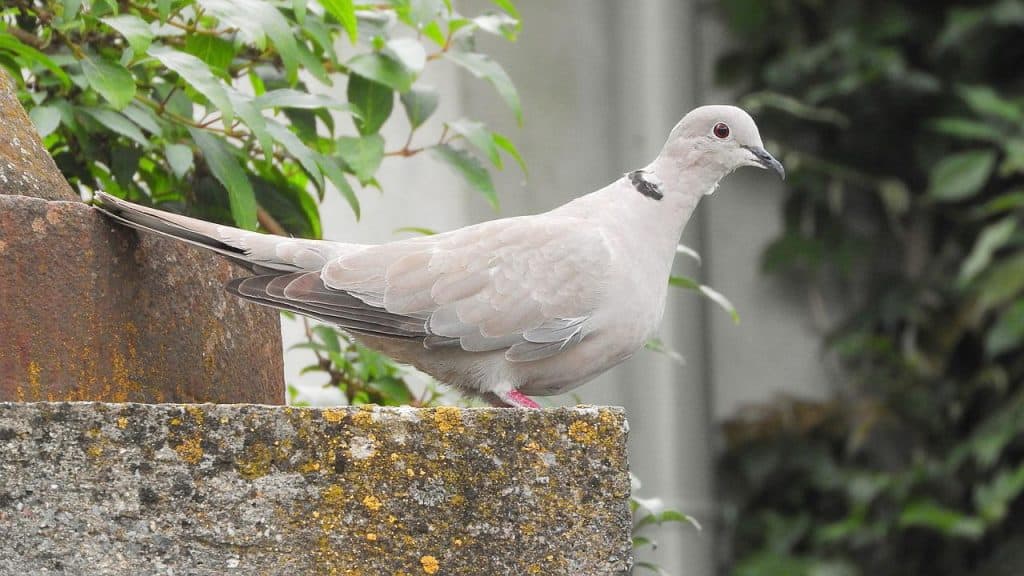
Appearance: The Eurasian collared dove is a large bird about 12 1/2″ long, gray/tan with a black collar on the back of its neck. Eyes are large and black, bill long and slightly curved down. They have a long, squared-off tail with a white tip best seen from underneath.
Diet: Seeds, grain, berries, and insects.
Feeder food: Millet on the ground or platform feeder.
Habitat: They live in towns, suburbs, and farms.
Nesting: They build their flimsy platform nest of twigs and stick then place them in a tree or shrub about 1/2 way up. They have 3-6 broods/season with 1-2 eggs/brood. Eggs are white and slightly glossy. Incubation is for 14-19 days and fledglings leave the nest about 16-20 days after hatching.
Migration: Eurasian-collared doves do not migrate. They remain in their year-round range for all seasons of the year.
Year-round range: The western half of the US, states east and south of Illinois, southern British Columbia, Alberta, and Saskatchewan, as well as Mexico.
Range Map
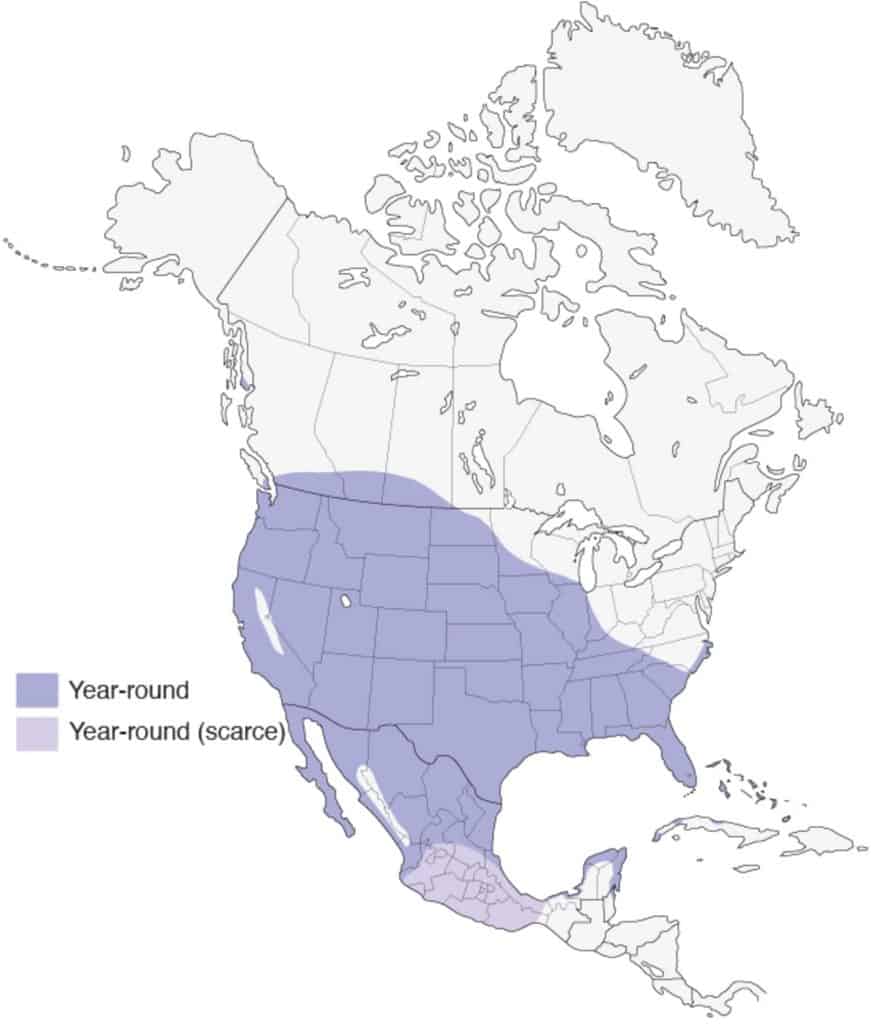
European Starling
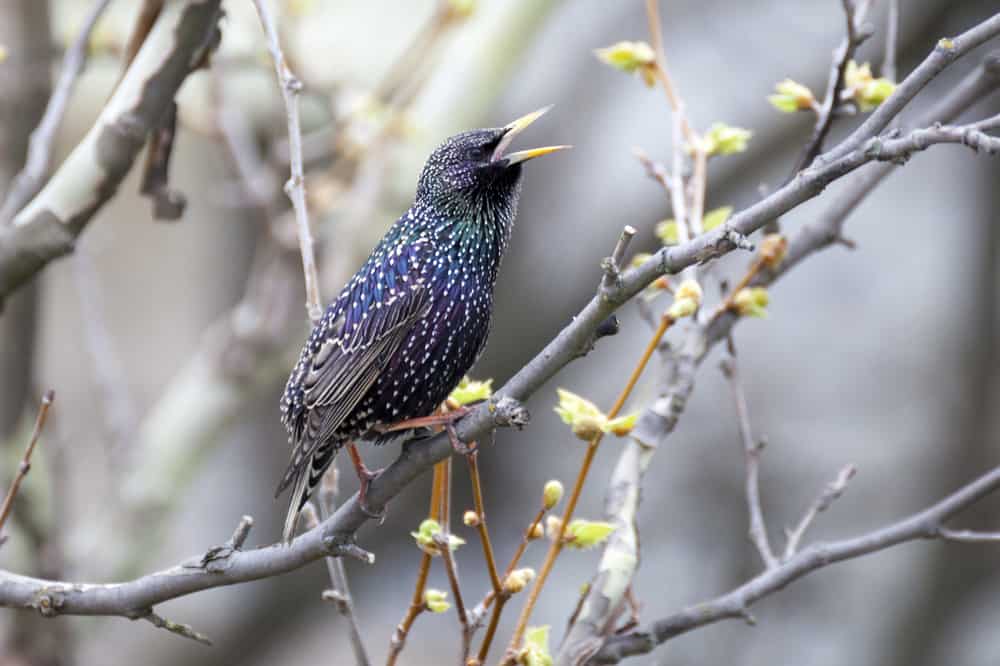
| Appearance | Medium-sized bird about 7 1/2″ long with iridescent shades of purple and black with white speckles throughout. They have a long pointed gray bill in fall and yellow in spring. The tail is short. The Female looks the same. |
| Diet | Insects, seeds, fruit. |
| Feeder Food | Everything and anything you could offer at the feeder. |
| Habitat | Urban and residential areas throughout the US and Canada including backyard lawns, parks, and fields. |
| Nesting | Nest: They are cavity nesters Brood: 2 broods/year. Clutch: 4-6 eggs/brood Egg color: Glossy bluish or a pale green Egg size: 1.1 – 1.3 inches by 0.8 – 0.9 inches Incubation: 12-14 days. |
| Migration | North American European starlings are not migrators. They remain in their year-round range all seasons of the year. That said, some may head further south into Mexico for winter. Year-round range: Every US state and Canadian province, and Mexico. |
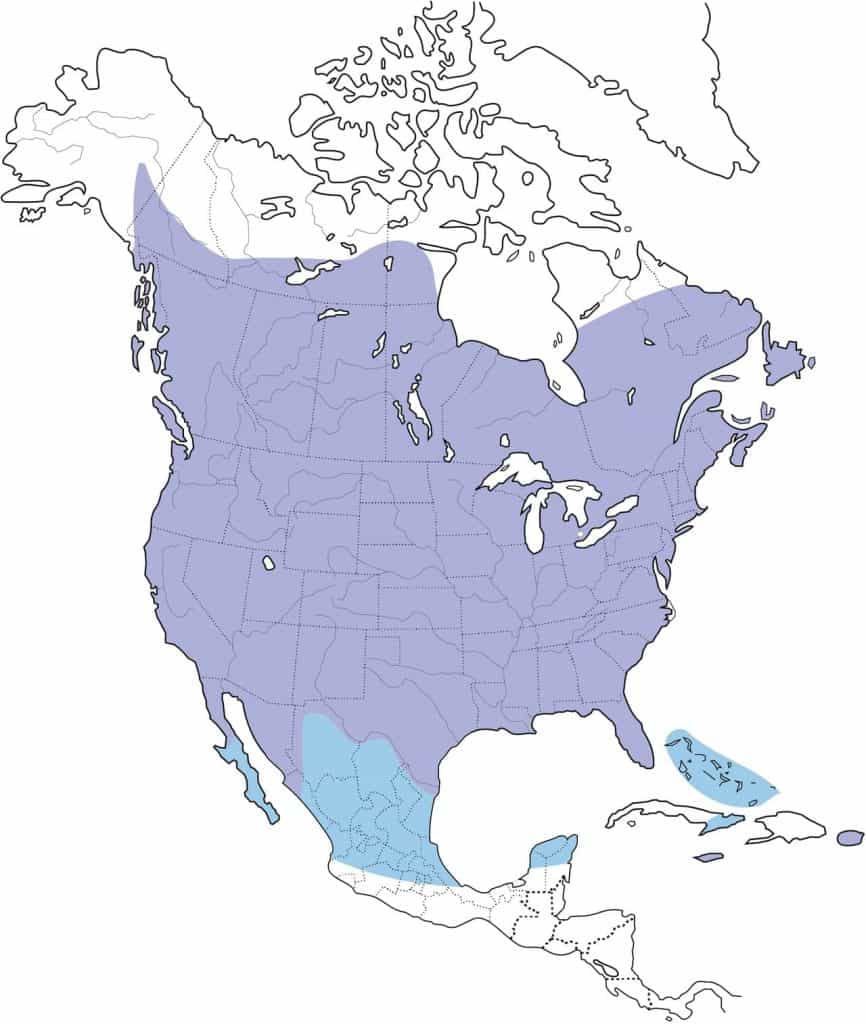
Golden-Crowned Kinglet
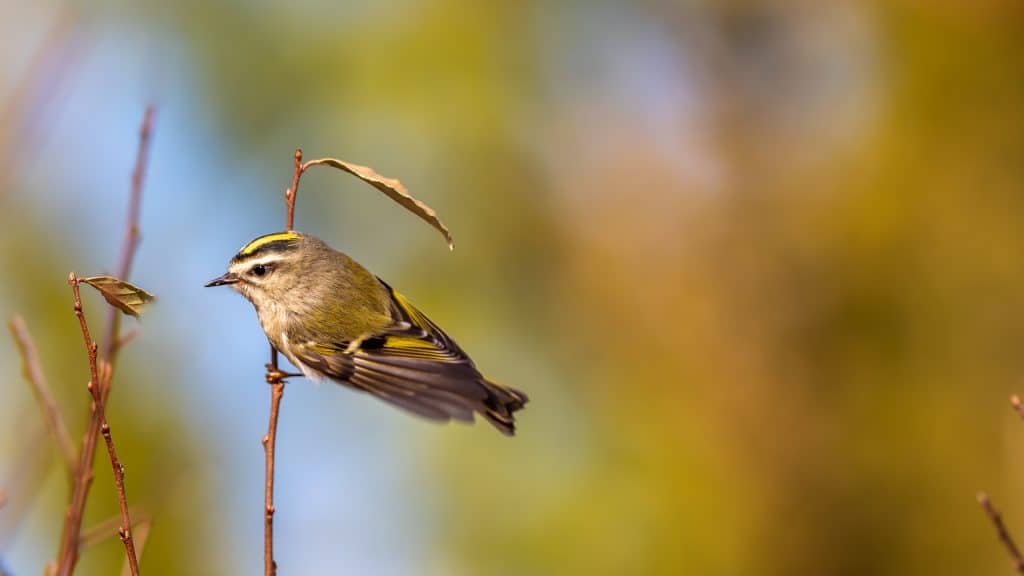
Appearance: Golden-crowned kinglets are small birds about 4″ long, olive-green in color with crowns striped with reddish/orange and white stripes above & below the eyes. Females are the same except for their crowns are yellow instead
Diet: Insects and spiders.
Feeder food: Suet.
Habitat: In their year-round area, they generally inhabit mountainous regions with abundant coniferous trees. They nest in mixed forested areas and within small groups of trees with minimal or no undergrowth.
Nesting: The golden-crowned kinglet builds a 3″x3″ cup-shaped, deep nest and places it at the intersection of several branches. They have 1-2 broods/season and 7-8 eggs/brood that are white/cream colored with specks of brown or lavender. Incubation lasts 15 days.
Migration: Golden-crowned kinglets are migrators. While many remain in their year-round range every season of the year, others migrate. The migrators head north into Canada, northern Minnesota, Michigan & Wisconsin for breeding in springtime then head south to the rest of the US for winter months.
Year-round range: Pacific coast of Alaska, British Columbia, Washington, Oregon, California, Idaho, eastern Oregon, western Montana, Utah, Colorado, Arizona, New Mexico, New England, and Mexico.
Breeding range: Canada (except Nunavut), southeast Alaska, northern Minnesota, Michigan & Wisconsin.
Winter range: All US states, southern Alberta, Saskatchewan, Manitoba, and the northern part of Mexico.
Range Map
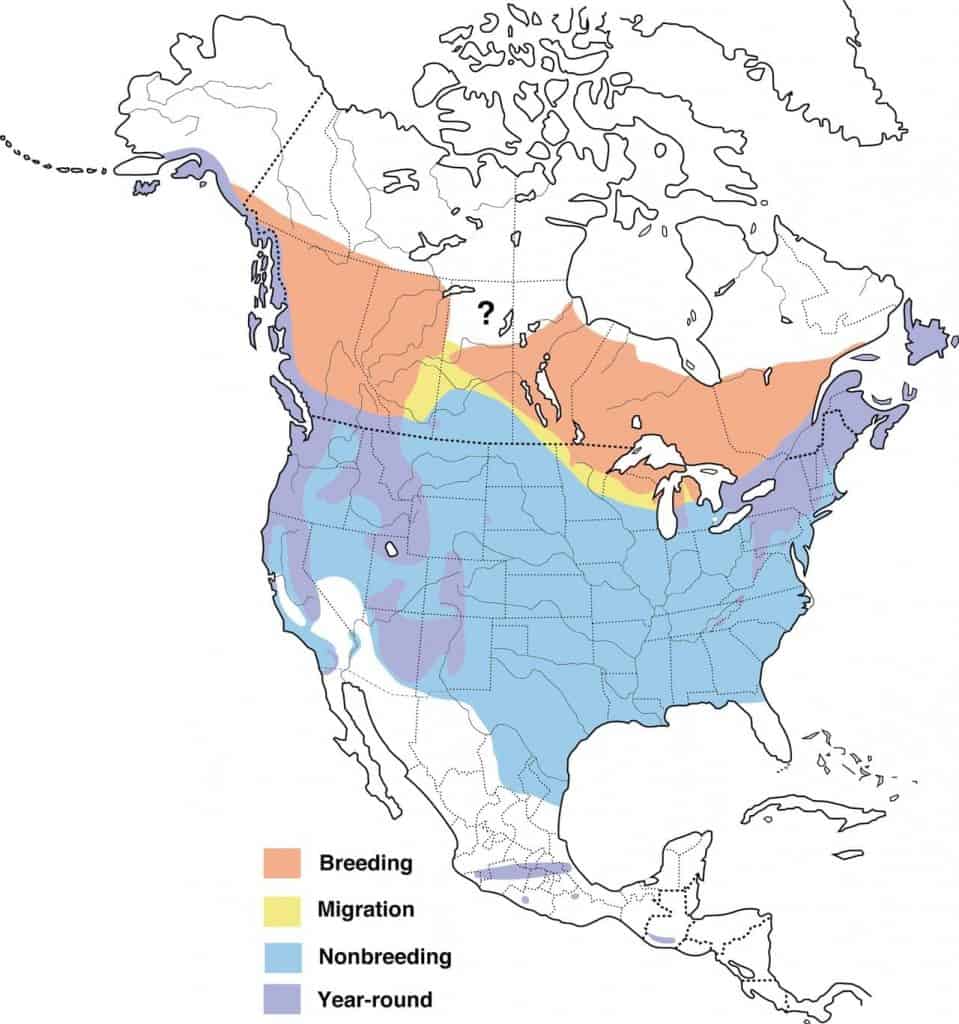
Great Blue Heron
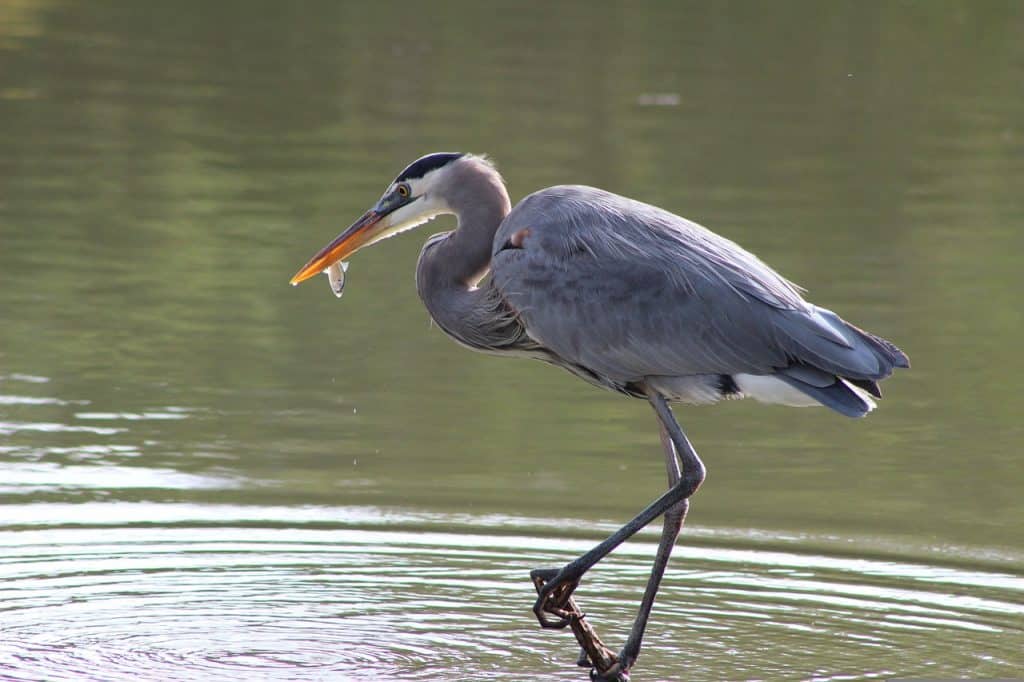
| Appearance | Great blue herons are enormous waterbirds about 45-55″ long. They have a large body with blue/gray feathers, long legs, a white face with a black streak on the cheek and crown, a long pointy orange bill, and a curvy neck which they often curl into the shape of an “S”. |
| Diet | Fish, frogs, salamanders, turtles, snakes, insects, small mammals, and birds. |
| Feeder Food | They don’t visit feeders. |
| Habitat | The Great Blue Heron is a highly adaptable bird evidenced in its wide year-round range that spans much of the US and British Columbia coast. They prefer calm freshwaters, rivers, and shallow coastal areas. |
| Nesting | Nest: A large, round platform-style nest is weaved by the female from sticks collected by the male and lined with pine needles, moss, grass, and other soft materials and placed on the ground. Brood: 1 – 2 broods/year Clutch: 2 – 6 eggs/brood Egg color: They lay large eggs ranging from pale blue to white. The lighter the color, the older the egg is. If you see near white eggs, they are close to hatching. Egg size: 2.4 – 3 inches by 2 inches Incubation: Both parents incubate the eggs for about 25-30 days. |
Range Map
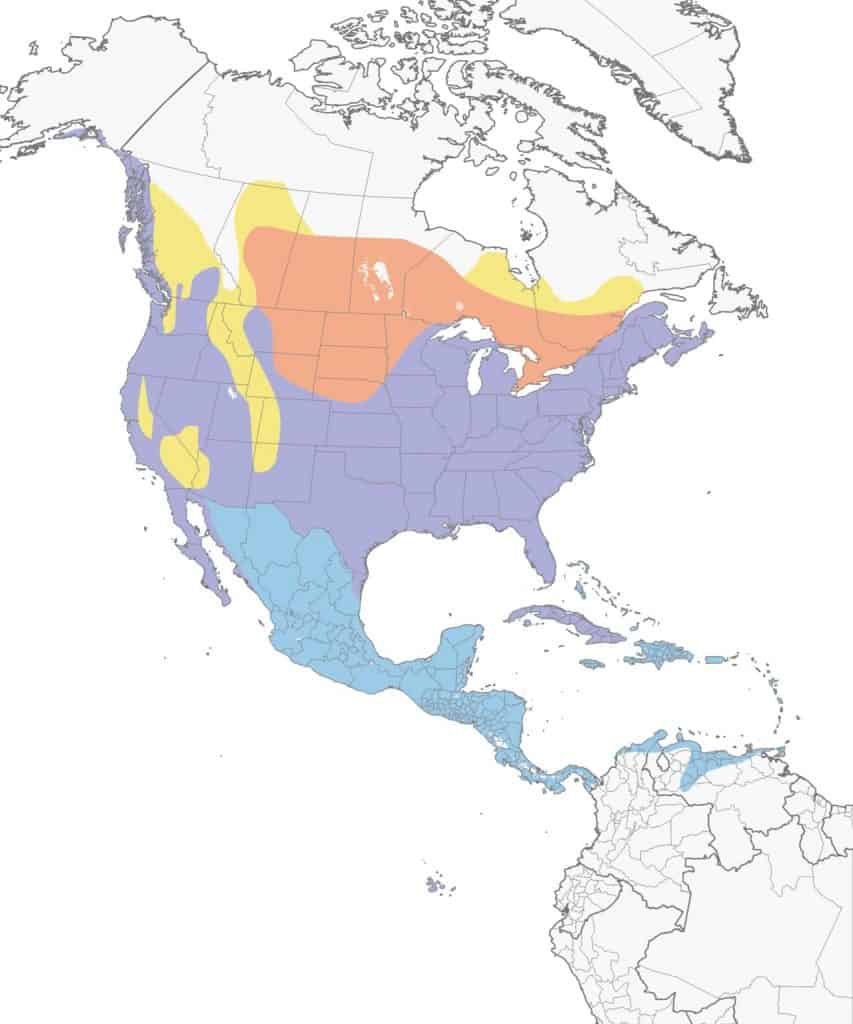
Great Gray Owl
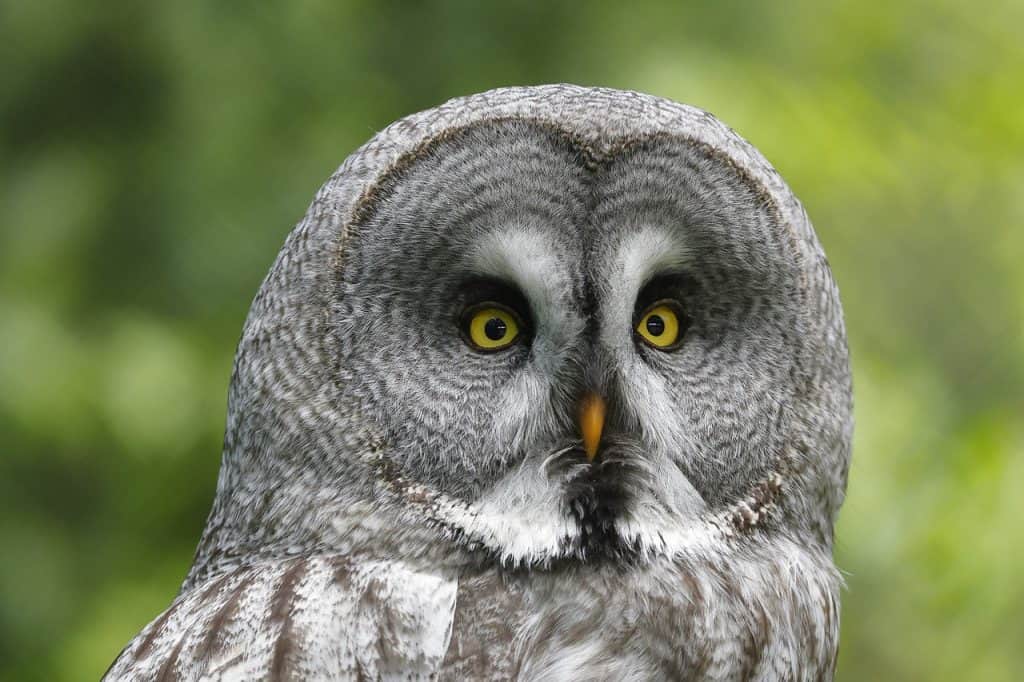
Appearance: Great gray owls are large birds about 24-33″ in length. They’re brown, silver, and white streaked, have very large heads, and have a large relatively flat face. Their eyes are close together and bright yellow and their beak is orange. Females are the same except bigger.
Diet: Small mammals.
Feeder food: Great gray owls are not feeder birds.
Habitat: The great gray owl prefers dense and moist evergreen forests in the far north.
Nesting: Great gray owls use existing nests built by other large birds or squirrels, or they lay their eggs on the top of dead trees or other plant material. They have 1 brood/season, 2-5 white eggs/brood, incubate for 28-36 days and fledglings leave the nest after 26-29 days.
Migration: Great gray owls are not migrators. That said, during the winter a population of them may expand a short distance outside their year-round range into Wyoming northern Minnesota, Wisconsin, Michigan, New York, and New England.
Year-round range: Alaska, northeast Washington, northern Idaho, western Montana, central Oregon, eastern California, and Canada’s provinces (except Nunavut).
Winter range: The year-round range plus into Wyoming northern Minnesota, Wisconsin, Michigan, New York, and New England.
Range Map
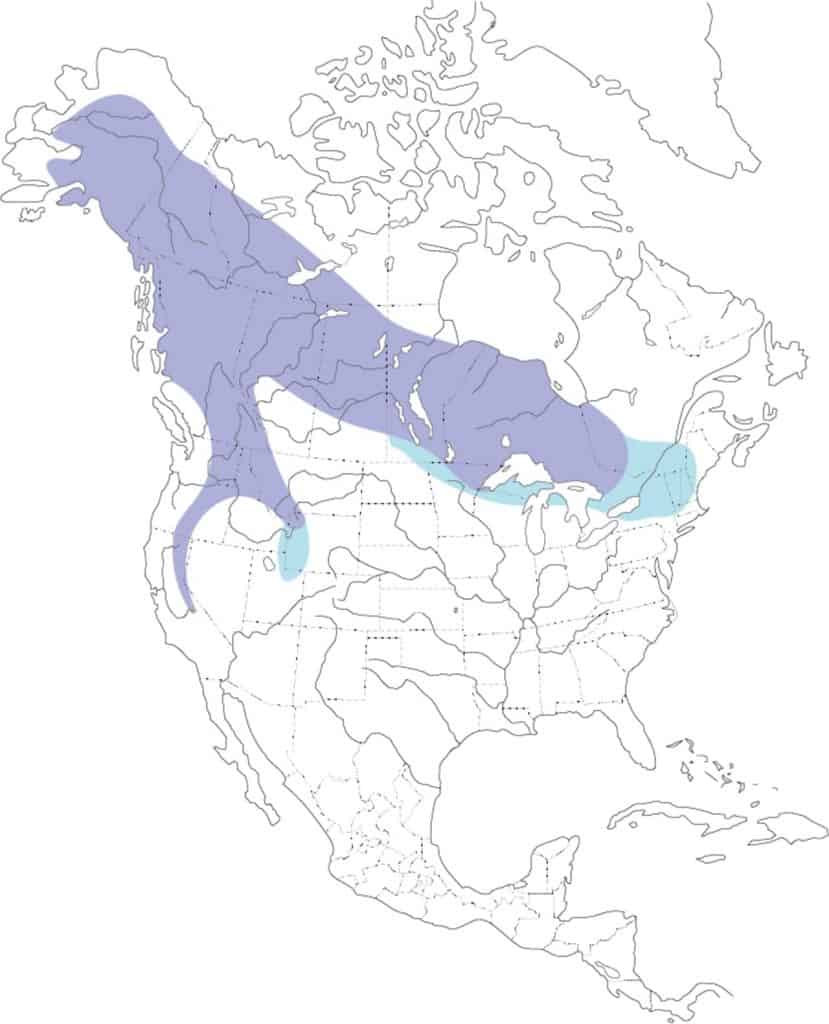
Greater White-Fronted Goose
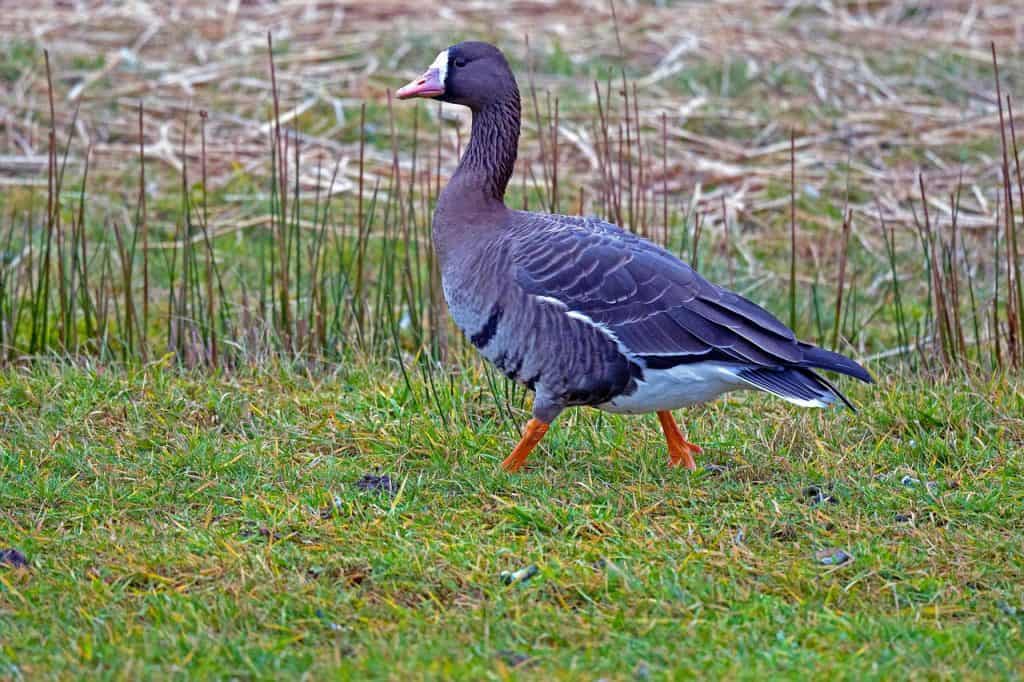
| Appearance | Large mostly brown waterbird about 25-32″ long. They have a heavy, stocky body with an orange bill and legs, white between the bill and head, and buffy underparts. |
| Diet | Diet includes plants such as grasses, berries, seeds, and grain. |
| Feeder Food | N/A |
| Habitat | Near wetlands, rivers, and ponds. |
| Nesting | The greater white-faced goose is a ground nester. The female constructs the nest on the shore of a lake or wetland area. She scrapes the ground and incorporates grass and sedge to form a large bowl-shaped nest. Broods: 1/season Clutch: 1-8 eggs/brood Egg color: white – tan Egg size: About 3.2″ x 2.1″ Incubation: Incubation lasts about 22-27 days and fledglings leave the nest after a short 2 days. |
| Migration | Greater white-fronted geese are migrators. In spring they migrate north into the northernmost part of Canada and Alaska to breed and raise young. Then in the fall, they head south and west for the winter. Breeding range: Alaska, and Canada’s northern Yukon, Northwest Territories, and Nunavut. Winter range: Along the pacific northwest from Washington to Mexico, southeastern Texas, Louisiana, and southeastern Arkansas. |
Range Map
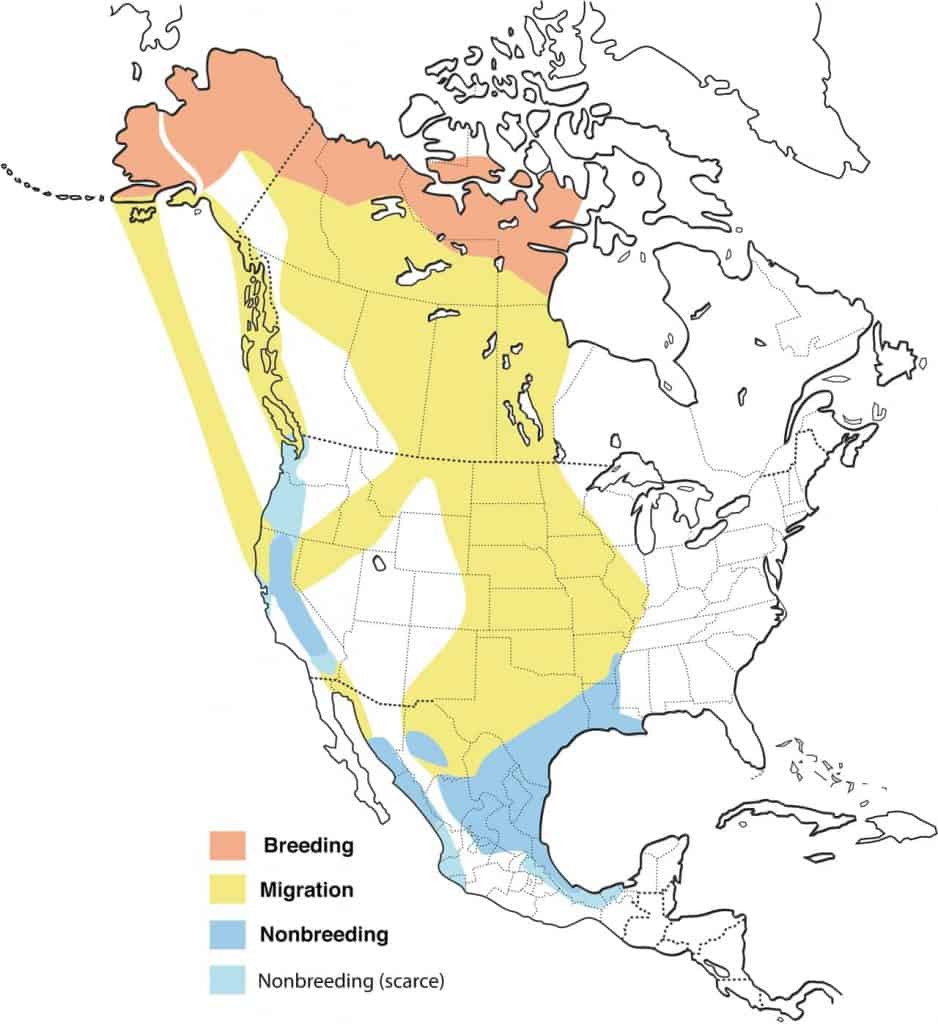
Gyrfalcon
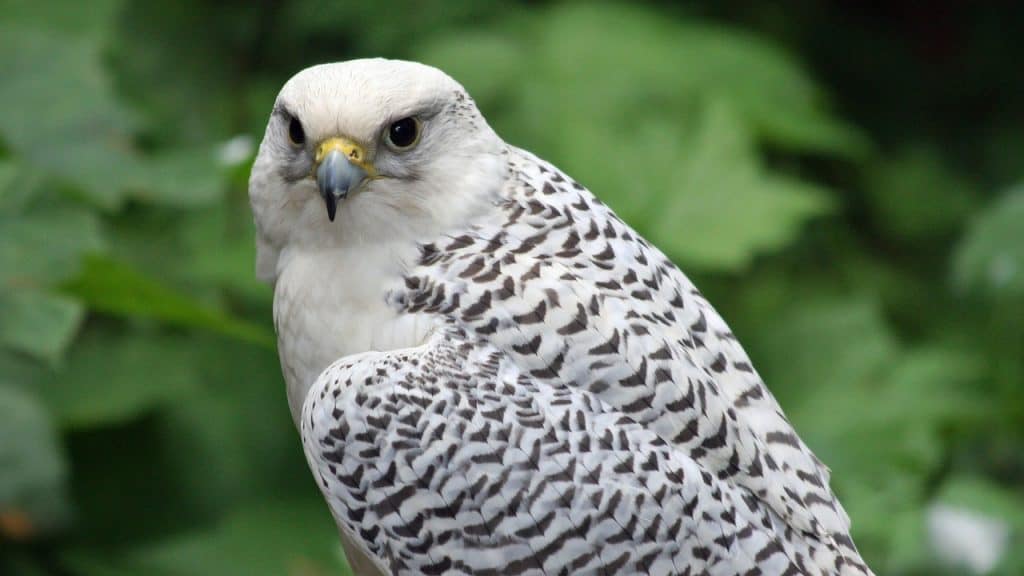
Appearance: Gyrfalcons are enormous birds about 19-26″ long. The more regal variety of this bird is white with black spots. However, they do come in other shades including white, gray, and dark brown. The wings, back, and tails are barred with either gray or dark brown. The wings and tail are long. The females are the same but much larger.
Diet: Birds and small mammals (e.g. rabbits, squirrels).
Feeder food: Not feeder birds.
Habitat: Gyrfalcons prefer the northern tundra both inland and along the coasts where seabirds and waterfowl are on the menu. Occasionally they can be found along the edges of forested areas. In lower elevations, they are found in open areas.
Nesting: Gyrfalcons build a rudimentary nest very high in a tree or along a cliff edge. They have 1 brood per season, 1-5 white or reddish-brown eggs/brood, incubation is 34-36 days and fledglings leave the nest after about 50 days.
Migration: Gyrfalcons are migrators. Although they maintain a year-round range in Alaska and northern Canada, many migrate even further north into Canada’s islands and Greenland for breeding. Then in the fall, they return to the year-round range for winter or migrate further south into Canada and northern US states.
Year-round range: Alaska, Yukon, northern Northwest Territories, northern Nunavut, and northern Quebec.
Breeding range: northern Canadian islands and Greenland.
Winter range: Alaska, Washington, Idaho, Montana, Wyoming, North & South Dakota, Minnesota, Wisconsin, Michigan, New York, Vermont, New Hampshire, Maine, and all Canadian provinces.
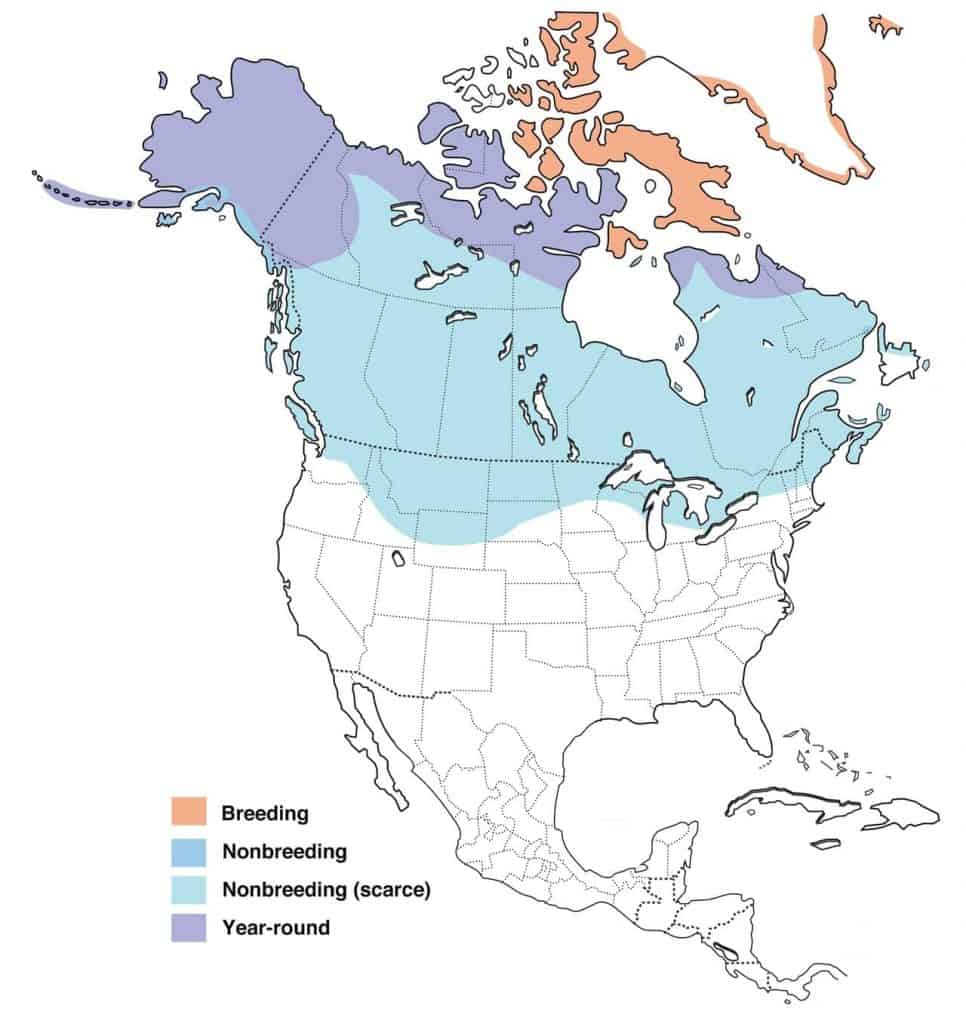
Harris’s Sparrow
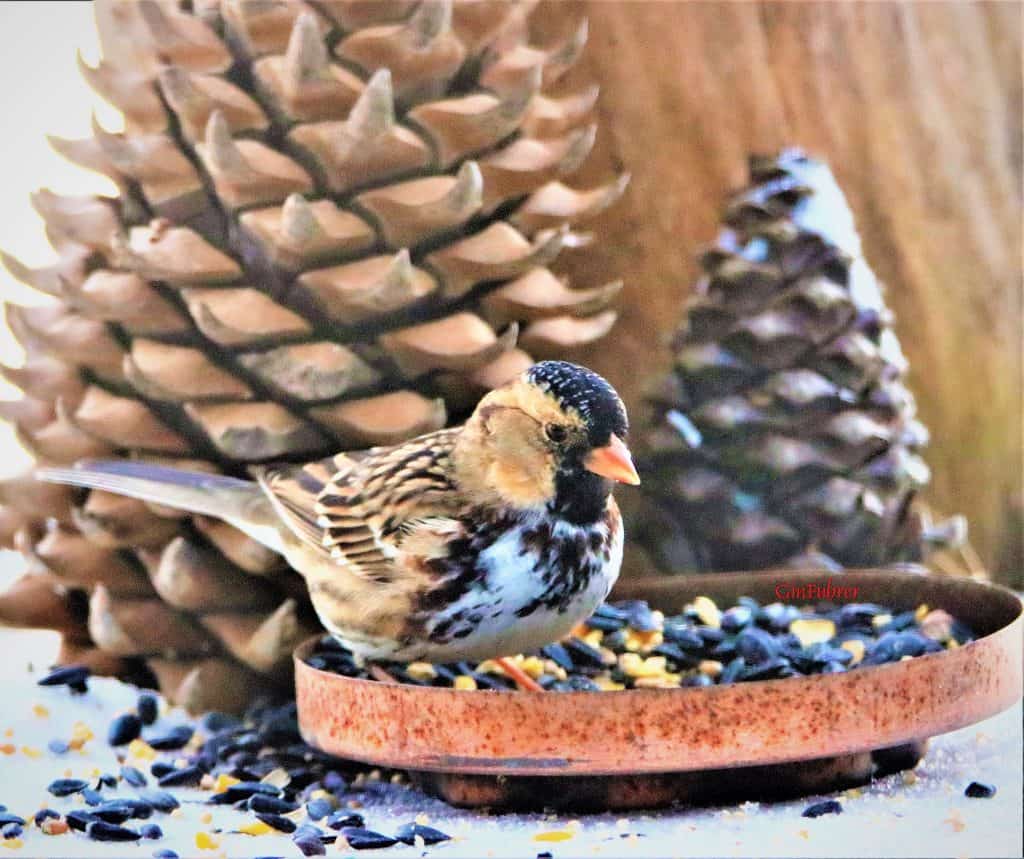
Appearance: The Harris’s sparrow is a medium-sized bird about 7 1/2″ long. It has black and charcoal in its head all the way to the back of its neck. The neck and belly are white with brown spots, brown wings, and a pink bill and legs. The female is the same.
Diet: Seeds, insects, berries.
Feeder food: Black-oil sunflower seeds, hulled sunflower seeds, cracked corn, and millet.
Habitat: Shrubby areas dense with vegetation.
Nesting: The cup-shaped nest is located on the ground. They have 1 brood/season with 4-5 white eggs with brown spots in each brood. Incubation is 13-14 days.
Migration: Harris’s sparrows are migrators. They migrate north in the spring to breed and raise their young. Then in the fall, they migrate south for the winter.
Breeding range: Canada’s Northwest Territories, Nunavut, northwest parts of Saskatchewan, and Manitoba.
Winter range: Kansas, Nebraska, Oklahoma, and Texas.
Range Map
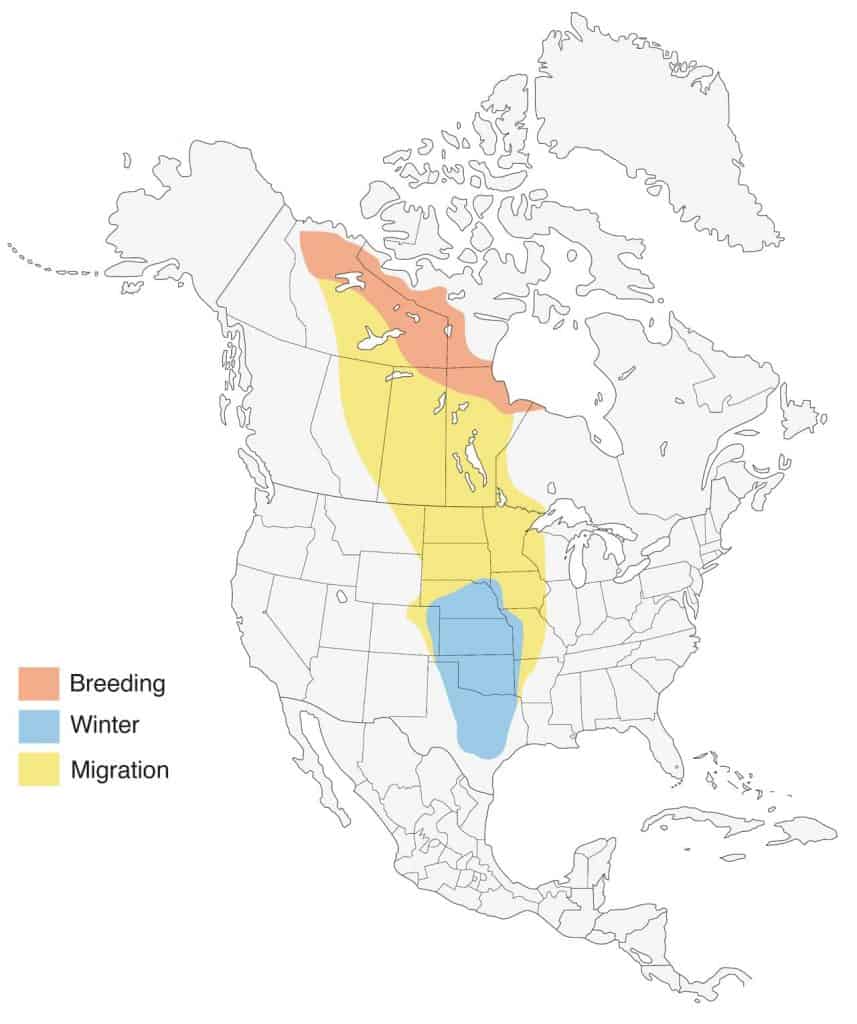
Hermit Thrush
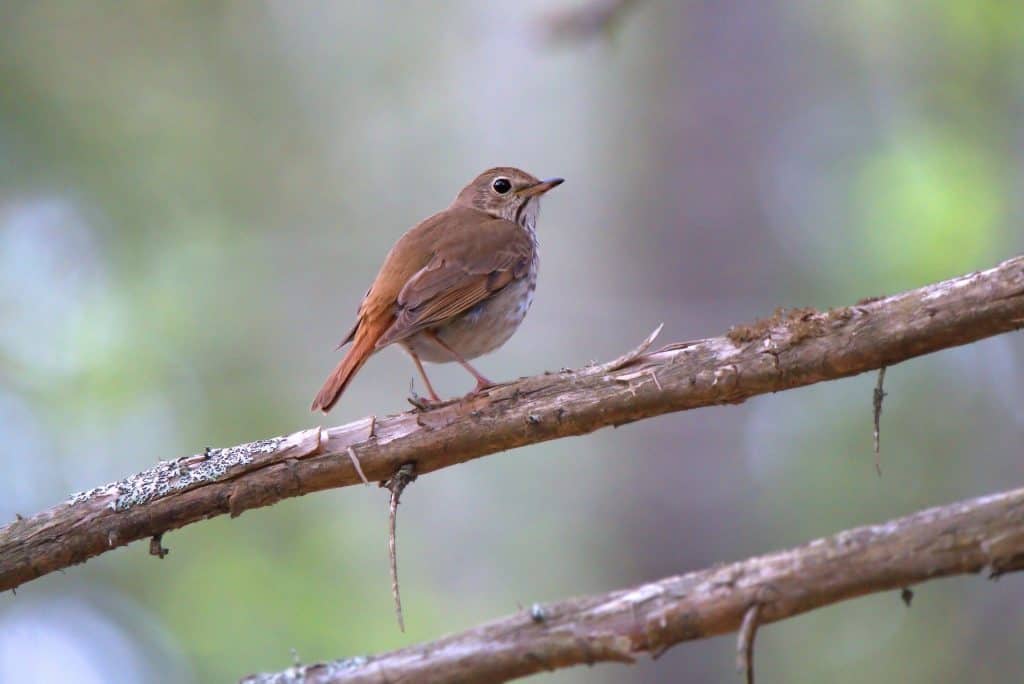
Appearance: The Hermit thrush is about 7″ long. In the east, they’re rich brown with brown flanks (belly area below the wing). In the west, they’re gray/brown with gray flanks. They have a cinnamon-colored tail, dark round eyes with a white eye-ring, and tan breasts with dark spots.
Diet: Insects and fruit.
Feeder food: Unlikely to visit a feeder.
Habitat: Forested areas that are rich with coniferous and hardwood trees.
Nesting: They build a cup-shaped nest made of grass and placed it on the ground. They have 1-2 broods/season, usually, 4 eggs/brood, and the eggs are light blue – sometimes with brown spots. Incubation is for 12-13 days and fledglings leave the nest about 12-13 days after hatching.
Migration: Hermit thrushes are migrators. In spring they head north to the western US states as well as Canada to breed and raise their young. Then in the fall, they migrate south to the southern part of the US, along the pacific coast, and Mexico for the winter. There are a few small patches throughout the US where populations of Hermit thrushes remain year-round.
Year-round range: Northern and central east California, western Nevada, southern Arizona, southern New Mexico, Virginia, and Pennsylvania.
Breeding range: Northern Washington, Idaho, western Montana, Wyoming, eastern California, Nevada, Utah, Colorado, New Mexico, New England, Alaska, and the Canadian provinces (except Nunavut),
Winter range: Pacific coast, southern Arizona, southeastern New Mexico, Texas, Oklahoma and states east of there.
Range Map
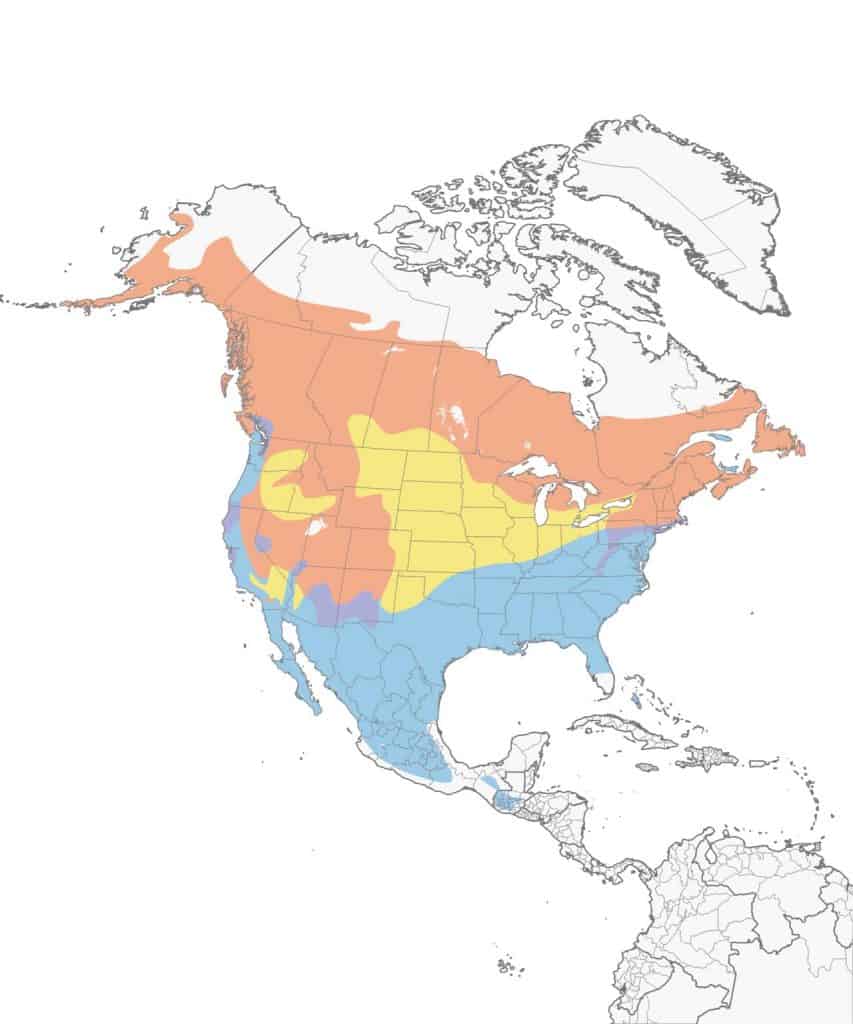
Herring Gull
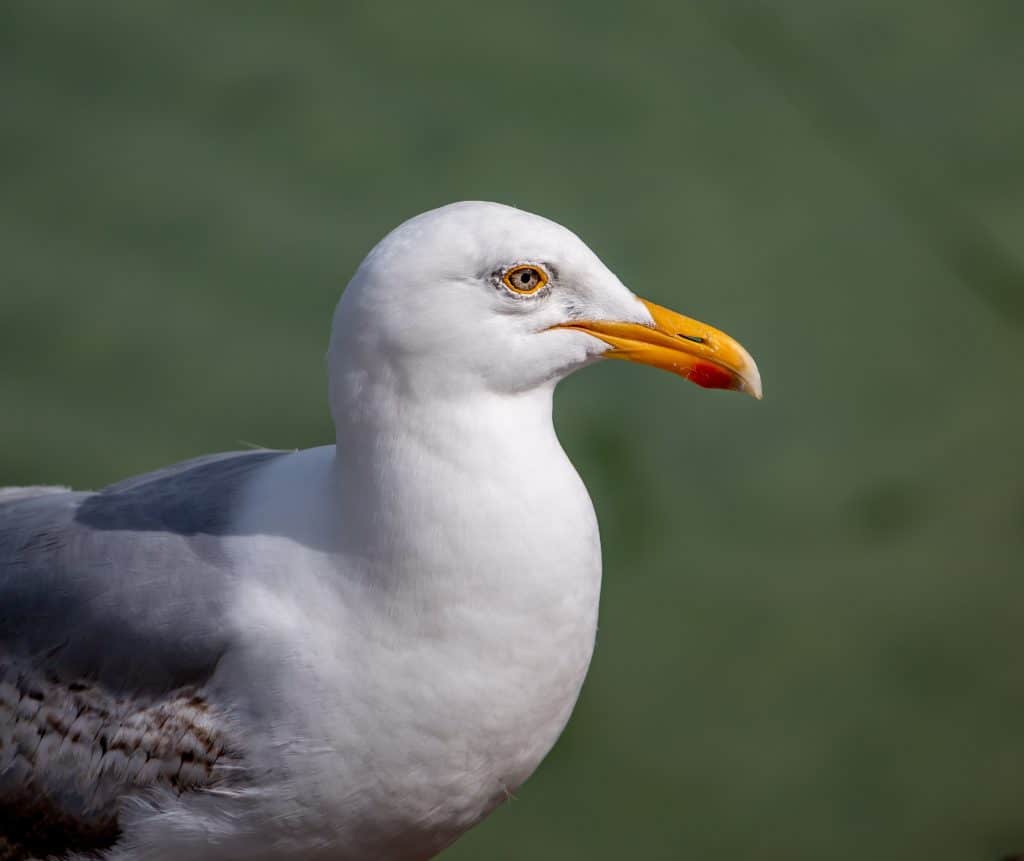
| Appearance | The herring gull is a large bird about 25″ long. They’re pal gray above with a white head and underparts. The head has brown specks except for the summertime when it’s pure white. They have yellow eyes and bills, and pink legs. |
| Diet | fish, marine life (shellfish, sea urchins, crabs…), insects, other bird eggs, and bird nestlings. |
| Feeder Food | They don’t visit feeders. |
| Habitat | Open water areas both coastal and inland. |
| Nesting | Herring gulls nest on the ground. They have 1 brood/season and 3 eggs/brood. The eggs are light green/tan with spots. Incubation is for 27-30 days and fledglings leave the nest after a few days. |
Migration: Herring gulls are migrators. While a population of them remain along the east coast year-round, others migrate north to Canada and Alaska in the spring to breed and raise young. In the fall, they migrate south for winter.
Year-round range: Southern Alaska, northern Wisconsin, Michigan, New York, and the east coast south to South Carolina as well as a narrow string in southern Quebec.
Breeding range: Alaska, northern Vermont, New Hampshire, and Maine, as well as all of Canada.
Winter range: Washington, west coasts of Oregon & California, Colorado, New Mexico, Kansas, Oklahoma, Texas, southwest Wisconsin, Illinois, Iowa, Arkansas, Missouri, Alabama, Mississippi, Georgia, Florida, and Mexico’s coasts.
Range Map
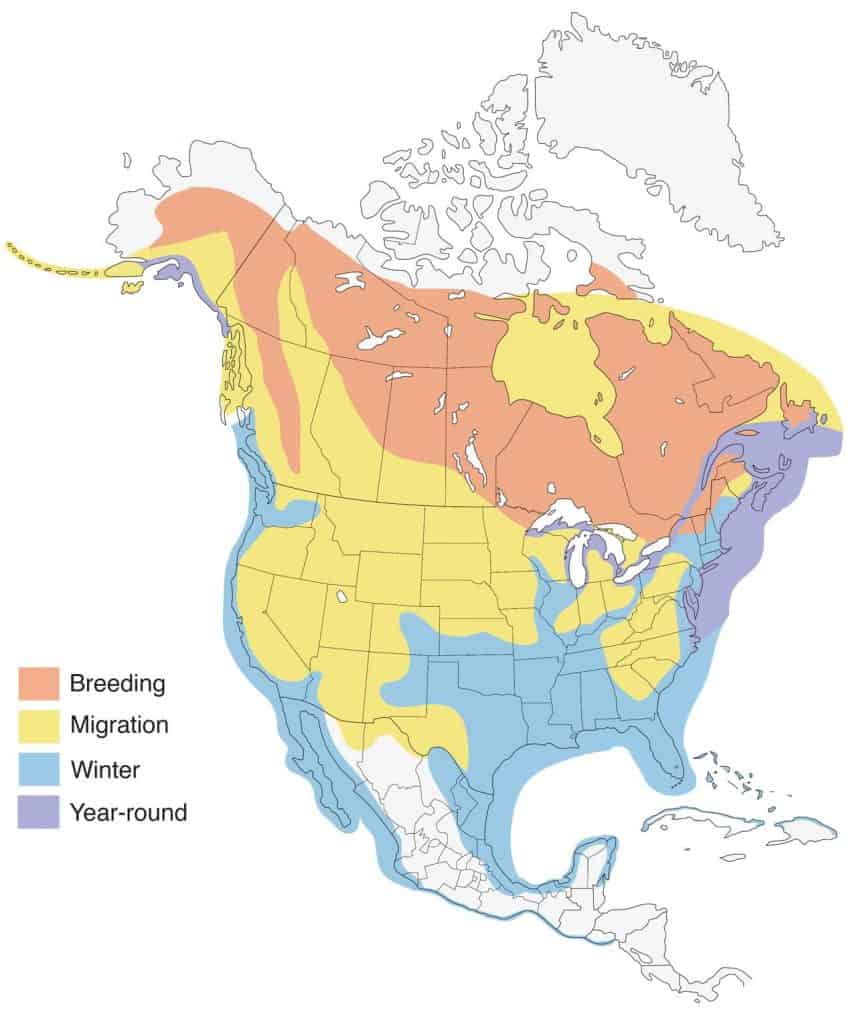
House Finch
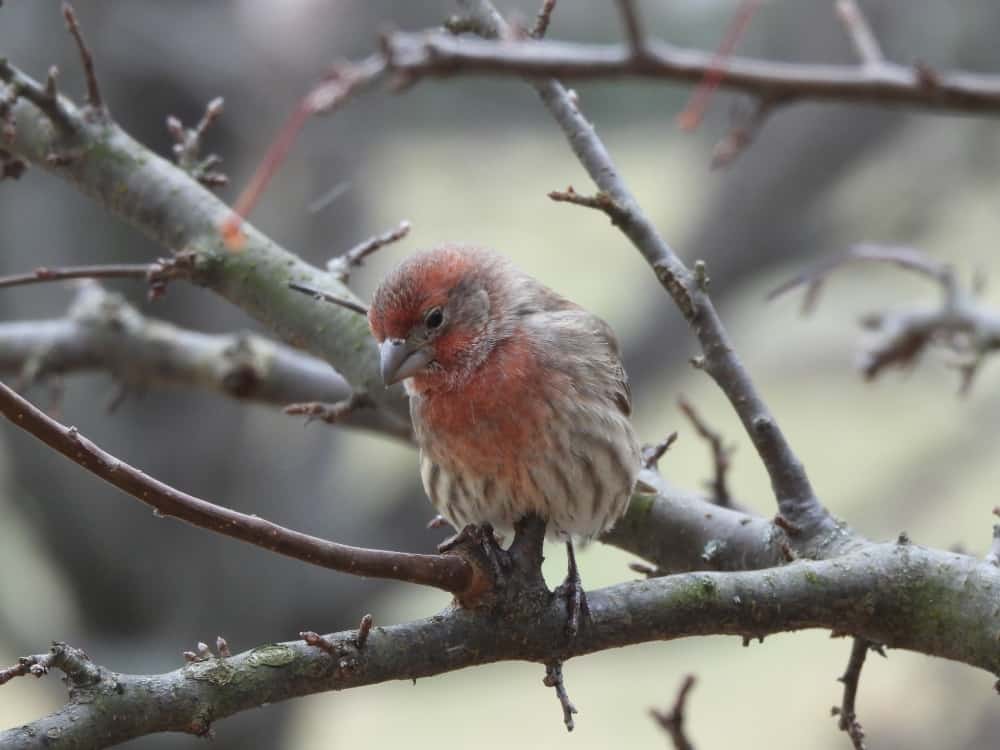
| Appearance | Small bird about 5″ long, orange/red face chest, and rump. Brown wings streaked with white. White belly with brown streaks. The Female and juvenile are brown with streaks of white. |
| Diet | Seeds, fruit, tree buds. |
| Feeder Food | Black oil sunflower seed is their favorite. |
| Habitat | House finches are found in the western and eastern parts of the US. They prefer to live around human dwellings (buildings, backyard trees, shrubs, barns. Also are found in parks and other urban areas. |
| Nesting | Nest: Small cup about 3-7″ wide, constructed from stems, leaves and plant roots, and feathers. The nests are built in coniferous or deciduous trees or even any place that holds a nest (ledges, vents, hanging plants). Broods: 1-6 broods/season Clutch: 2-6 eggs/brood (typical is 4-5) Egg color: Eggs are pale blue and speckled with black and purple dots. Egg size: 0.6 – 0.8 inches by 0.5 inches Incubation: 13-14 days and the young fledge between 12-19 days. |
| Migration | House finches are not migrators They remain in their year-round range for all seasons. Year-round range: Every US state except North & South Dakota, southern Ontario & British Columbia, and Mexico. |
Range Map
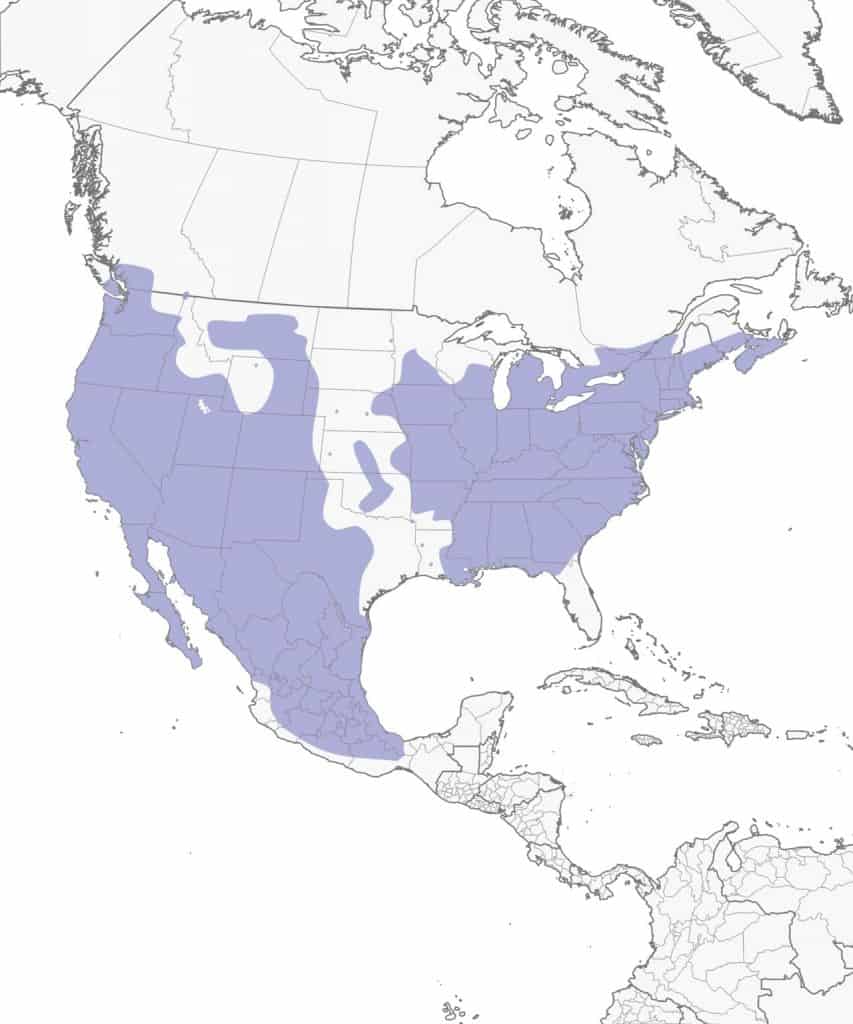
House Sparrow
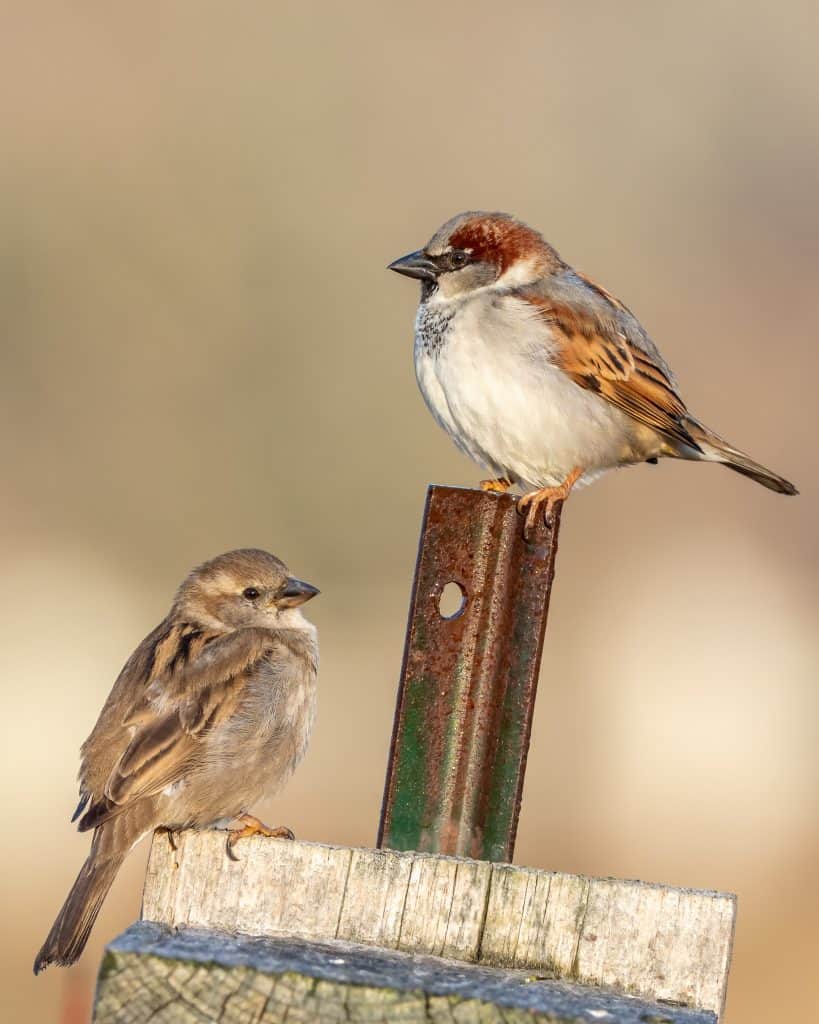
Appearance: The house sparrow is a small bird about 6″ long. They’re brown with a large black spot on the chin down to the chest. They have white wing bars, a gray belly & crown. The female is a bit smaller, all light brown and not black.
Diet: Seeds, insects, fruit.
Feeder food: Black oil sunflower seed, cracked corn, peanut hearts, millet, and milo.
Habitat: Around people and buildings in the city, towns, villages, suburbs, and farms.
Nesting: Dome-shaped nest within a cavity. They have 2-3 broods/year, and 4-6 white eggs with brown markings. Incubation is 10-12 days.
Migration: House sparrows are not migrators. They remain in their year-round range every season of the year. Their year-round range is massive encompassing nearly every part of North America (except Alaska and far northern Canada), Mexico, and Central America.
Range Map
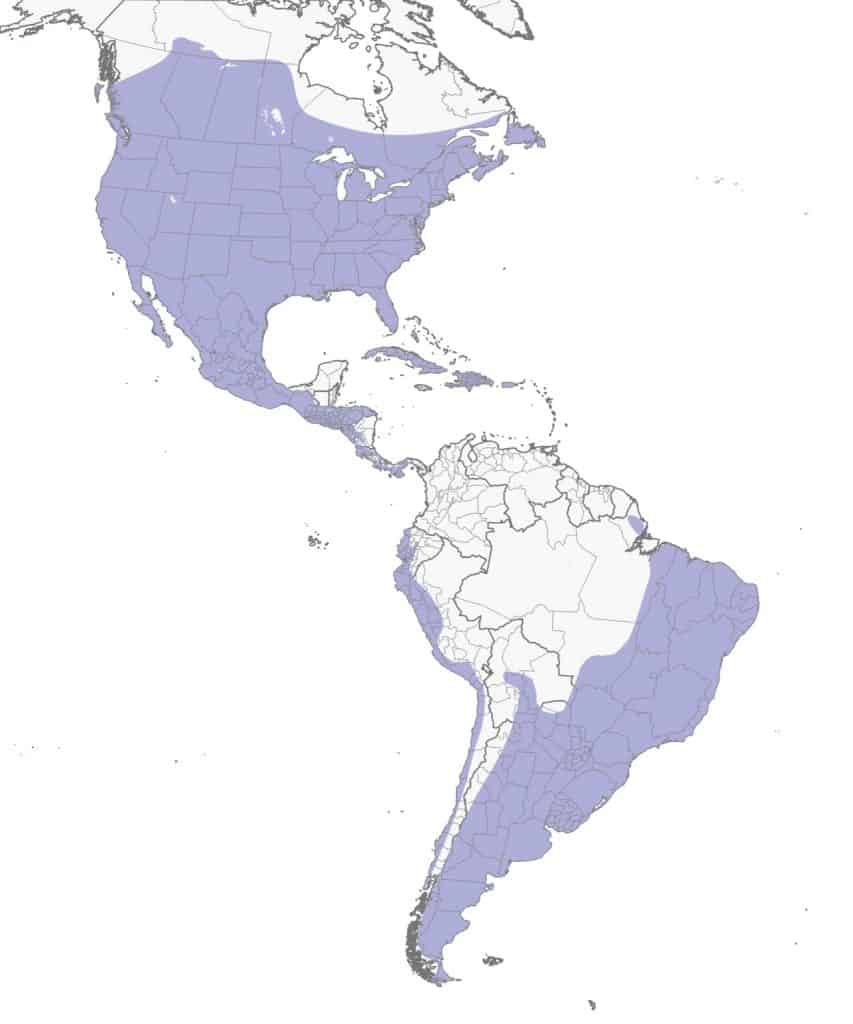
Indigo Bunting
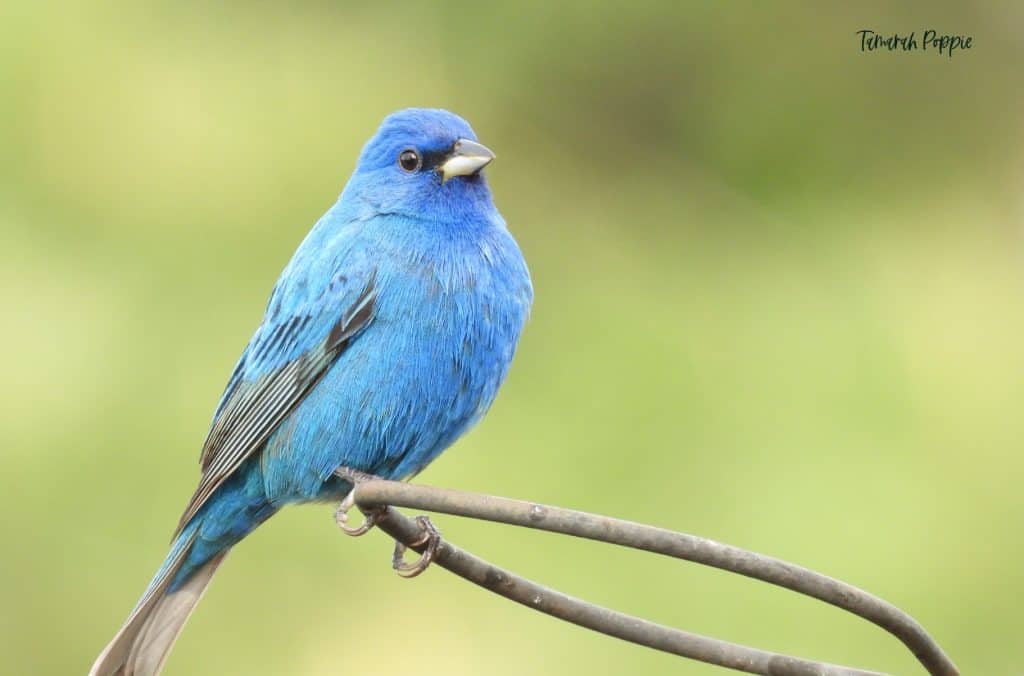
Appearance: Brushy fields, on weedy plants, scrub, and along the edges of the woods. Also in clearings within deciduous woods and edges of swamps.
Diet: Small seeds, insects, and fruits.
Feeder Food: Although not a regular at the feeder you may entice them with nyjer/thistle and white millet seeds.
Habitat: Brushy fields, on weedy plants, scrub, and along the edges of the woods. Also in clearings within deciduous woods, and edges of swamps.
Nesting: Cup-shaped nest in shrubs or trees 3′ high. Shrubs or trees 3′ high. 1-3 broods/season, 3-4 eggs/brood, eggs are white with few brown spots.
Range Map
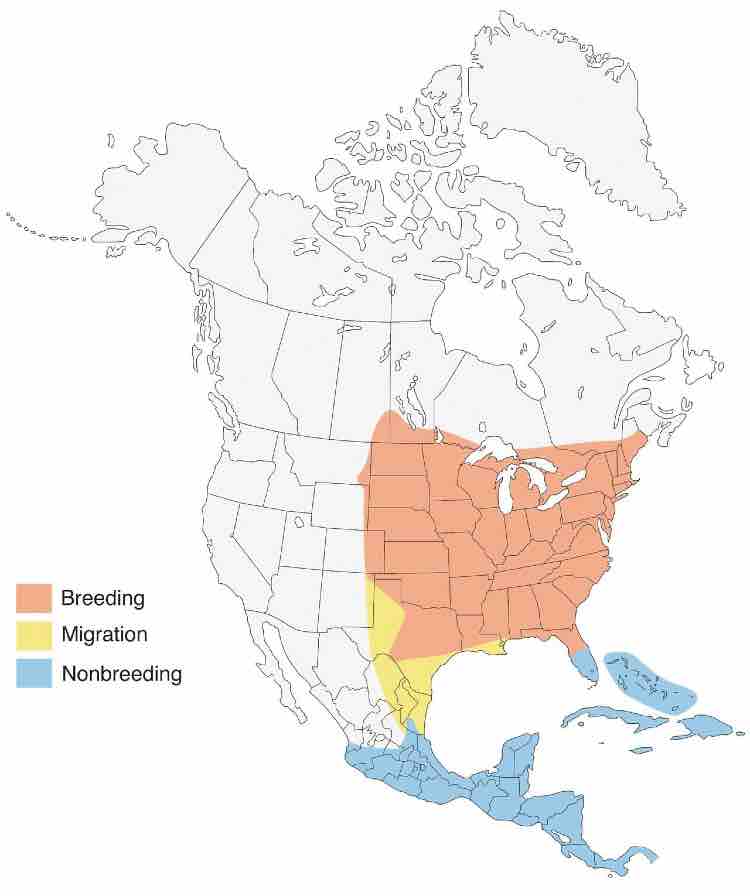
For more detail about the Indigo Bunting such as its mating & nesting, how to attract them to your yard, and more: check out Proven Ways to Attract Indigo Buntings.
Lark Sparrow
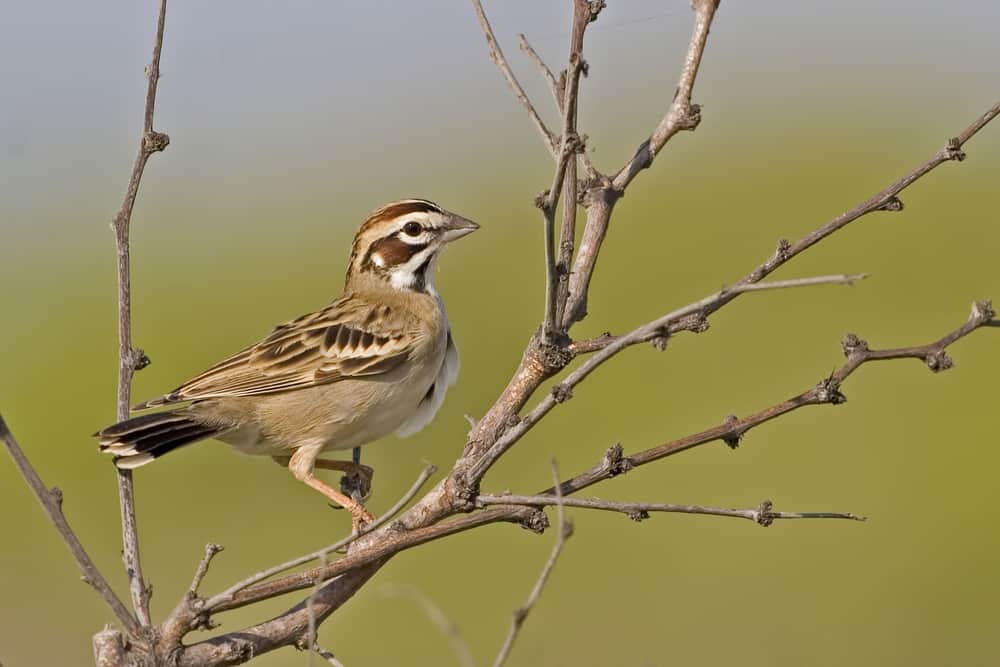
Appearance: The lark sparrow is a medium-sized bird about 7″ long. They’re primarily brown with striped patterns of chestnut, tan, white, and dark brown on its head. Underneath is a buffy tan with a dark brown spot in the middle of its chest.
Diet: Weed and grass seeds as well as insects.
Feeder food: Millet and cracked corn scattered beneath the feeder.
Habitat: Varied habitats comprised of grassy areas, trees, shrubs, prairies, hedgerows, and desert scrub.
Nesting: Lark sparrows usually nest on the ground. They have 1 brood/season and 4-5 eggs/brood. Incubation is for 11-12 days and fledglings leave the nest after about 9-12 days.
Migration: Lark sparrows are migrators. While many of them remain in their year-round range, others migrate north in the spring for breeding and raise their young. Then in the fall, the migrators will either return to their year-round range or further south.
Year-round range: Southwest Oregon, southcentral Idaho, the western edge of California, southern Arizona, the southern edge of New Mexico, and Texas.
Winter range: Mexico.
Breeding range: Most of the US except New England and the southeast.
Range Map
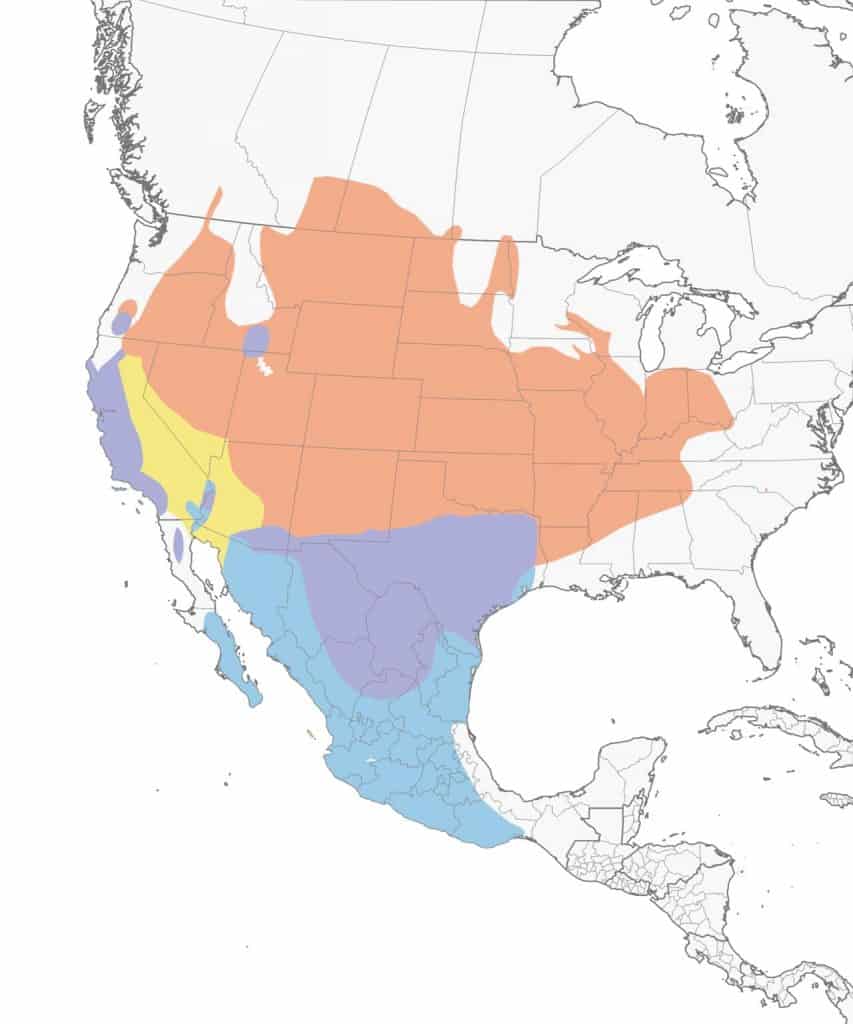
Lazuli Bunting
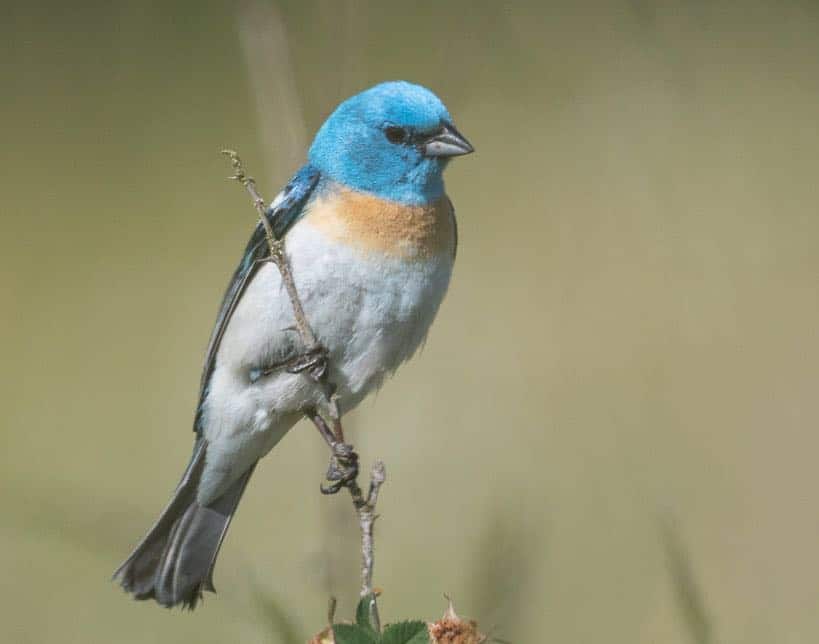
Appearance: Small bird 5-6″ long, brilliant blue on top, soft orange-cinnamon color chest, white belly and patch on the shoulder, cone-shaped bill, and slightly flat forehead.
Diet: Insects, fruits, and grasses.
Feeder Food: White proso millet, sunflower seeds, or nyjer thistle seeds.
Habitat: Open woodlands, brushy hillsides, thickets, and backyards throughout the West.
Nesting: Cup-shaped nest of bark, twigs, and leaves nestled in a shrub about 3′ up. They have 1-2 broods/season, 3-4 eggs/brood, and eggs are .7-.8″ long and pale blue to faint green/blue or white. 11-14 days incubation period.
Range Map
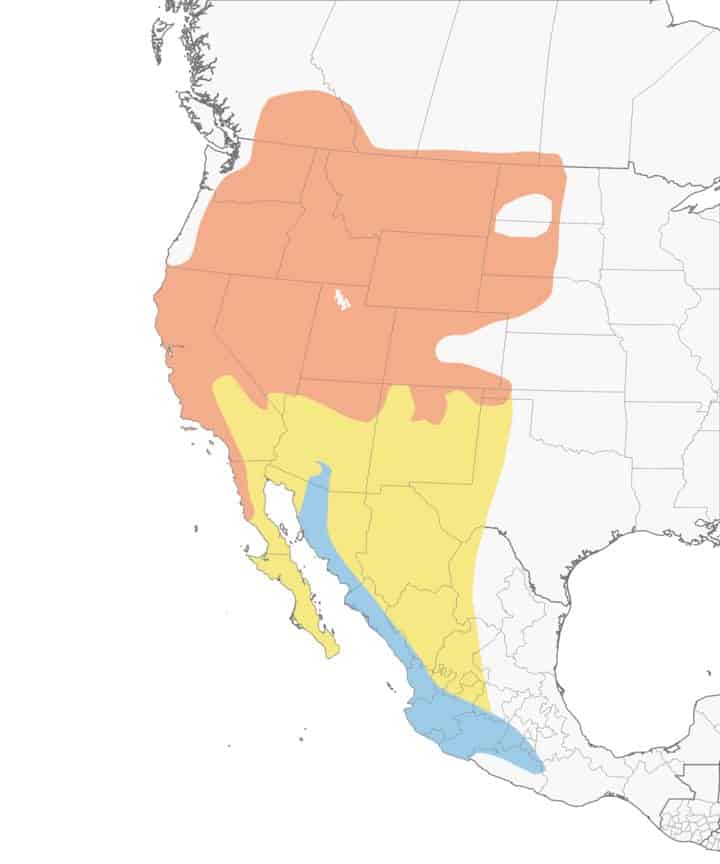
Lewis’s Woodpecker
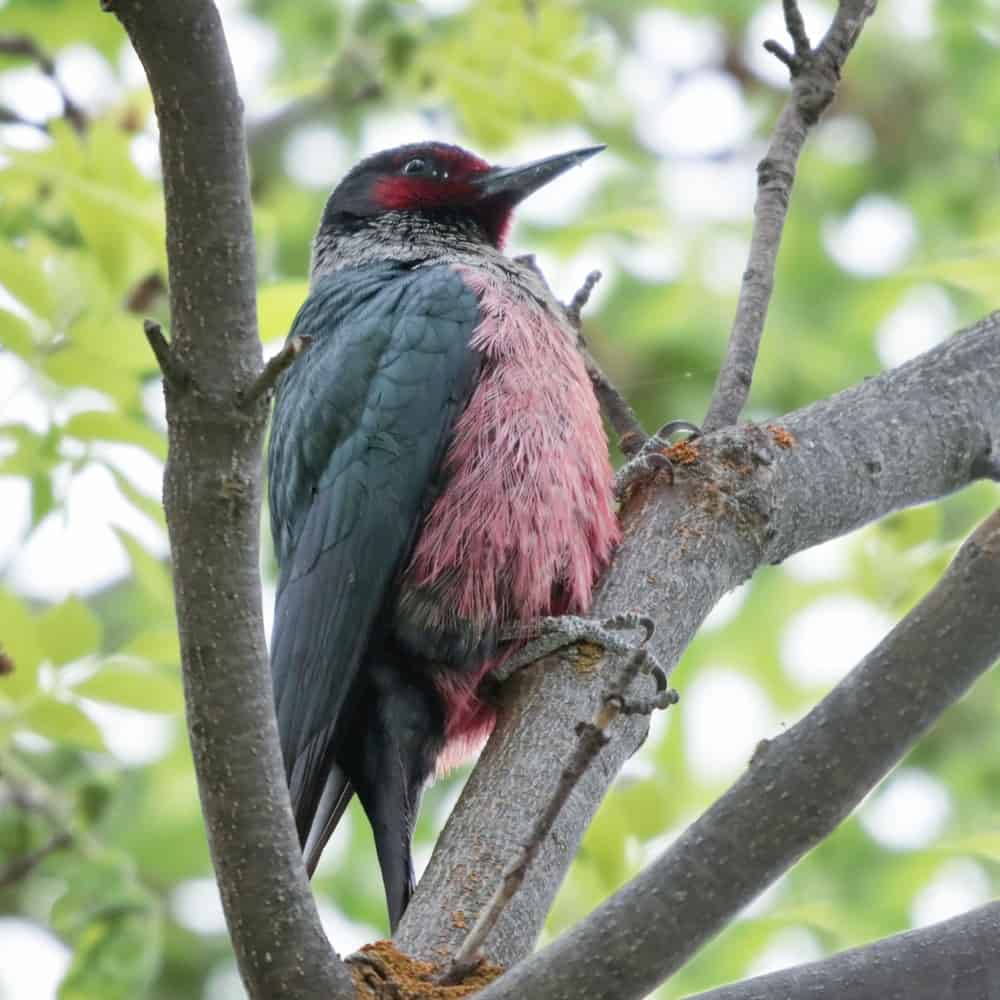
Appearance: The Lewis’s woodpecker is about 10-11″ long, dark iridescent green, a silver collar, black head and pointy bill, deep red on their face, red or salmon on the lower breast and belly. Male and females look the same, males are typically a bit larger.
Diet: Adult insects (especially ants, bees, wasps, butterflies, beetles & grasshoppers), nuts (acorns, almonds), fruit (apples, cherries, peaches, wild berries), and seeds. In winter they’ll commonly collect acorns, almonds, and corn then store them in tree cavities, crevices, etc. for later consumption.
Feeder food: Shelled peanuts, suet, sunflower seeds.
Habitat: During the breeding season, Lewis’s woodpeckers are found in open areas filled with pines, junipers, and oak trees as well as orchards and agricultural areas. They have a strong preference for ponderosa pines and forested areas. They’re particularly attracted to burn areas as the allure of dead trees is too enticing to resist.
Year-round range: Oregon, California, Utah, Colorado, Arizona, and New Mexico
Breeding range: British Columbia, Washington, Oregon, Nevada, Idaho, Montana, Wyoming, Utah, Colorado.
Nesting: Lewis’s woodpeckers are cavity nesters. They’ll generally use an existing cavity versus excavating their own. Wood chips become the lining of the nest. They have 1 brood/season, 5-9 eggs/brood, eggs are white colored, incubation is from 12-16 days and fledglings leave the nest after about 30 days.
Migration: Lewis’s woodpeckers do migrate. In the spring, some migrate north for breeding while others remain in their year-round range to reproduce. In the fall and winter, few of them remain in the breeding range during winter, others will hang out in family groups wandering throughout their year-round range in search of food. Most will head south for the winter spending time inland California – especially in valleys and lower mountain elevations.
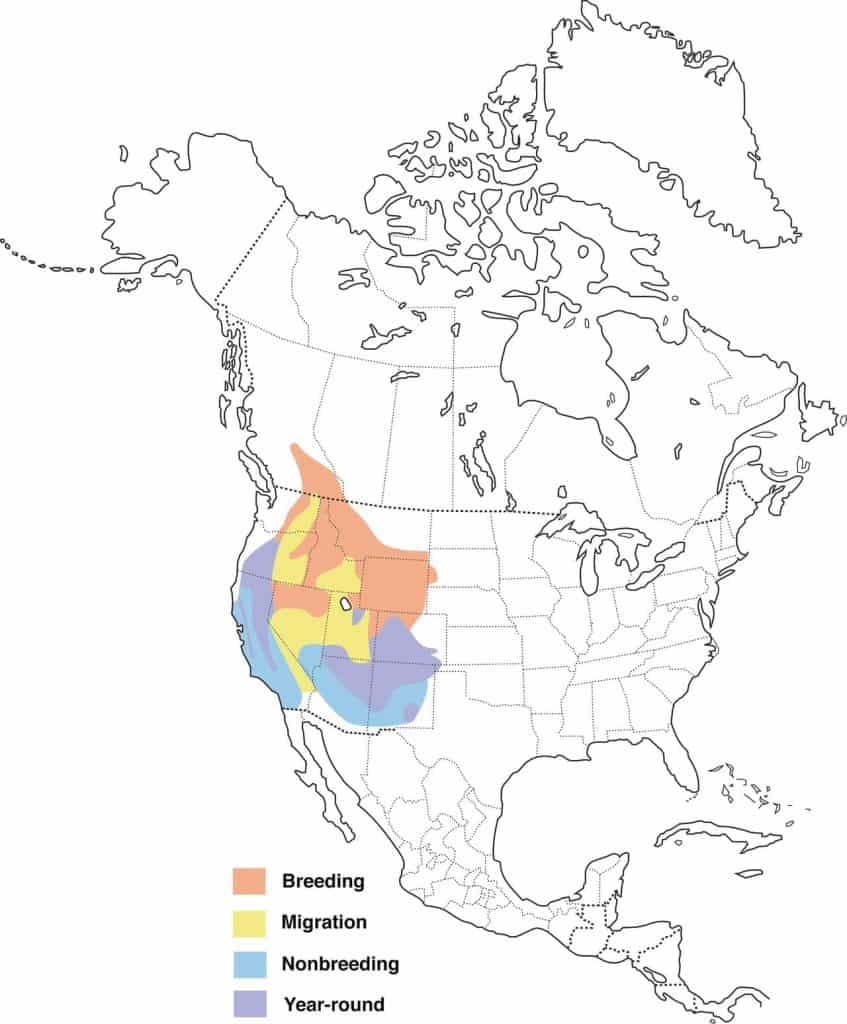
Mallard
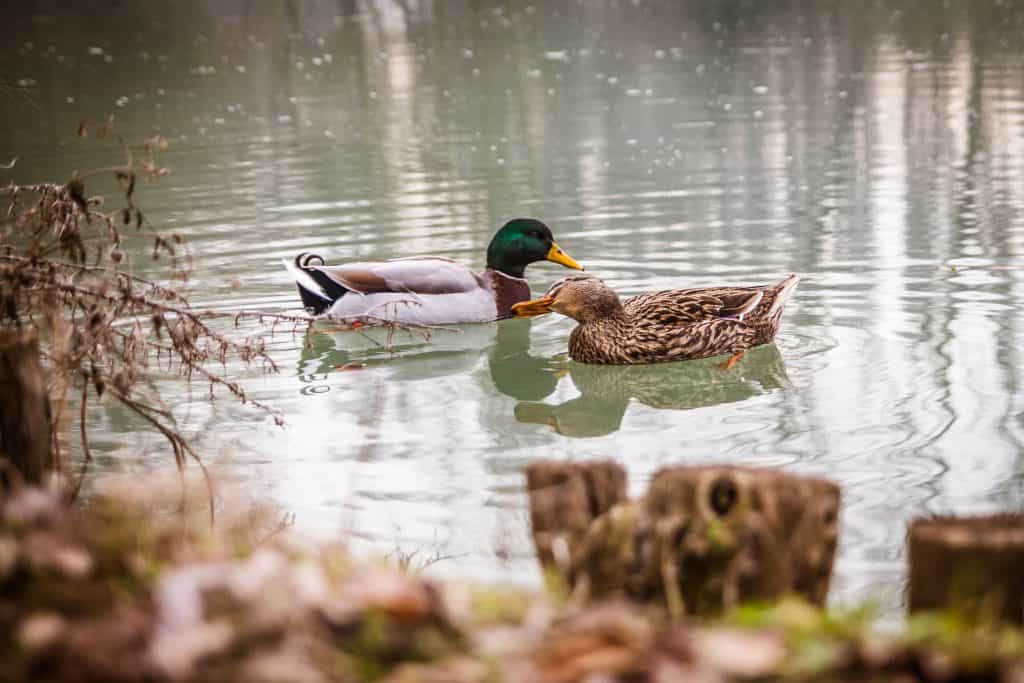
| Appearance | Mallards are large ducks about 23″ long. The male has a metallic green head, chestnut breast, and yellow bill. The female is a mottled brown with an orange bill and heavily streaked dark brown. |
| Diet | Insect larvae, snails, seeds. |
| Feeder Food | They’re not feeder visitors. |
| Habitat | Around freshwater habitats. |
| Nesting | Mallards nest on the ground near water. The nest is typically made from plant materials and lined with feathers and down. They have 1-2 broods/season and 10-12 eggs/brood. Incubation lasts for 28 days and fledglings leave their mom at about 7-8 weeks. |
Range Map
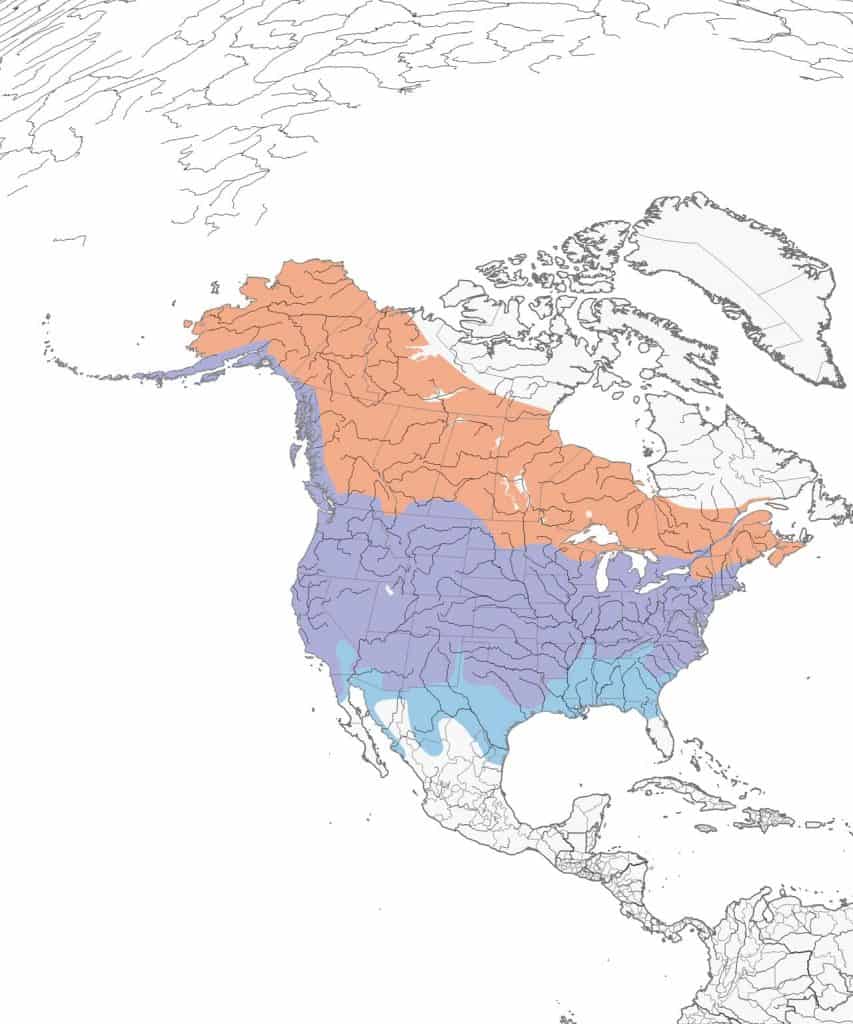
Mountain Bluebird
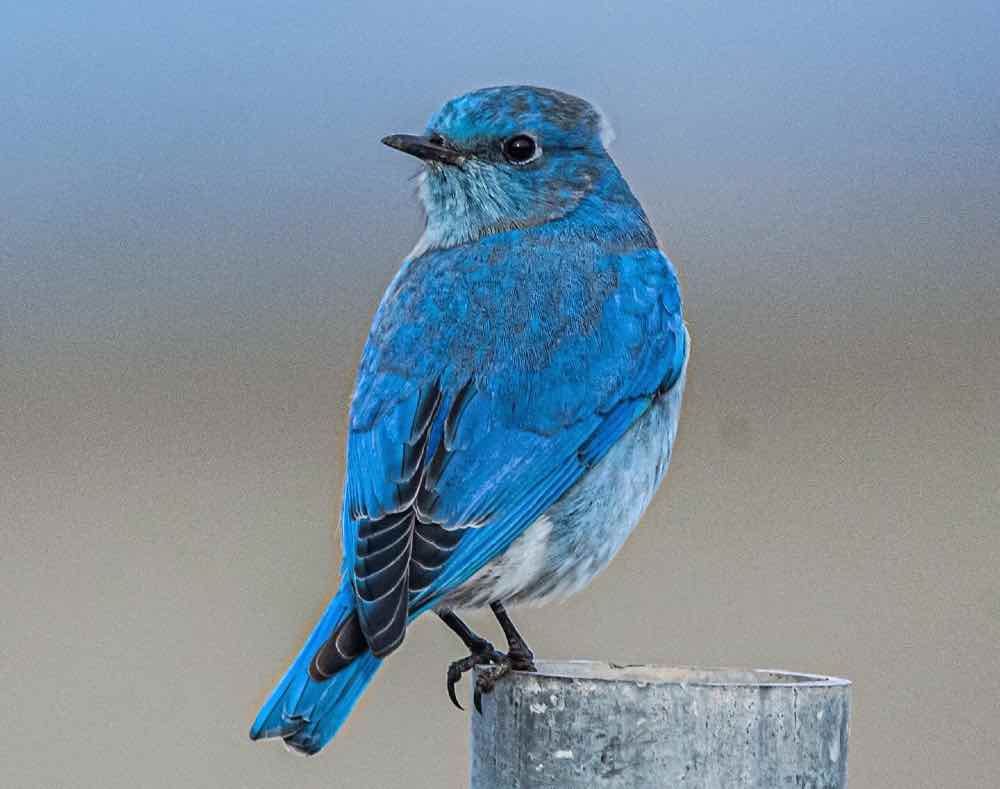
Appearance: Small bird about 7″ long. Sky-blue color, darker blue wings and tail, lighter shades of below underneath, white undertail with black wing tips, and straight thin bill. Females are gray/brown with a bit of soft blue on their wings and tail.
Diet: Insects, fruit, and seeds.
Feeder Food: Unlikely to visit a feeder.
Habitat: Open woodlands, fields, prairies.
Nesting: Cavity nesters – will use an old woodpecker hole or manmade nesting box.
Brood: 1-2 broods/season
Clutch: 4-8 eggs/brood
Egg size: 1″ x .8″
Egg color: Pale blue to bluish-white (rarely pure white)
Incubation: 18-21 days
Range Map
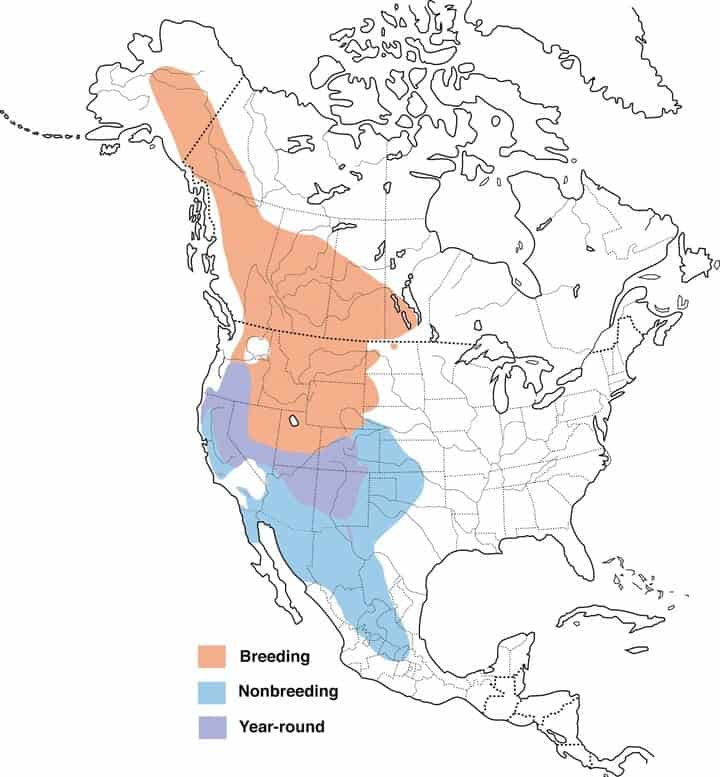
Northern goshawk
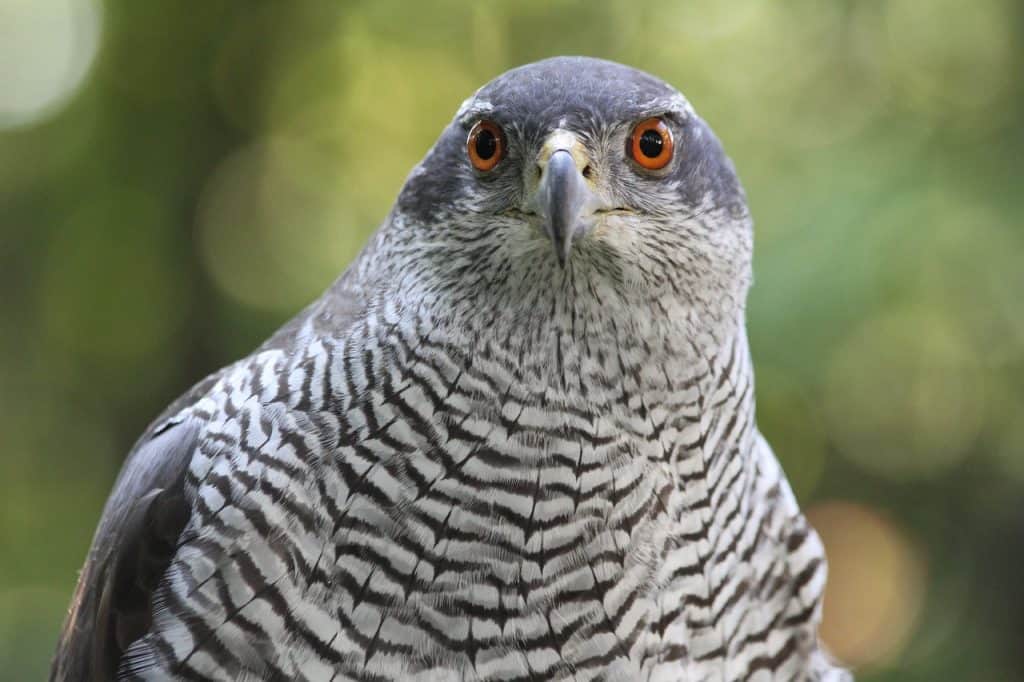
Appearance: Northern goshawks are large birds about 21-30″ long.
Diet: Mammals (e.g. rabbits, squirrels), large birds (e.g. grouse, woodpeckers, blue jays, crows), reptiles, insects, and even carrion.
Feeder food: They don’t eat feeder food.
Habitat: This bird prefers forest areas comprised of both coniferous and deciduous trees.
Nesting: Northern goshawks place their nest in a large, tall tree next to the trunk or horizontally along forked branches. In the east they choose deciduous trees, in the west, it’s usually conifers. They’ll build or use an existing nest from a prior brood. They have 1 brood/season, 2-4 blue/white eggs/brood, incubate for 28-38 days and the fledglings leave the nest after 35 days.
Migration: Northern goshawks are migrators. While many remain in their year-round range all seasons of the year, some will head further south for the winter.
Year-round range: Alaska, Washington, Oregon, California, Idaho, Montana, Wyoming, Nevada, Utah, Colorado, Arizona, New Mexico, Minnesota, Wisconsin, Michigan, Pennsylvania, New York, New England, all of Canada, and Mexico.
Winter range: Their year-round range plus North & South Dakota, Nebraska, Illinois, and Ohio.
Range Map
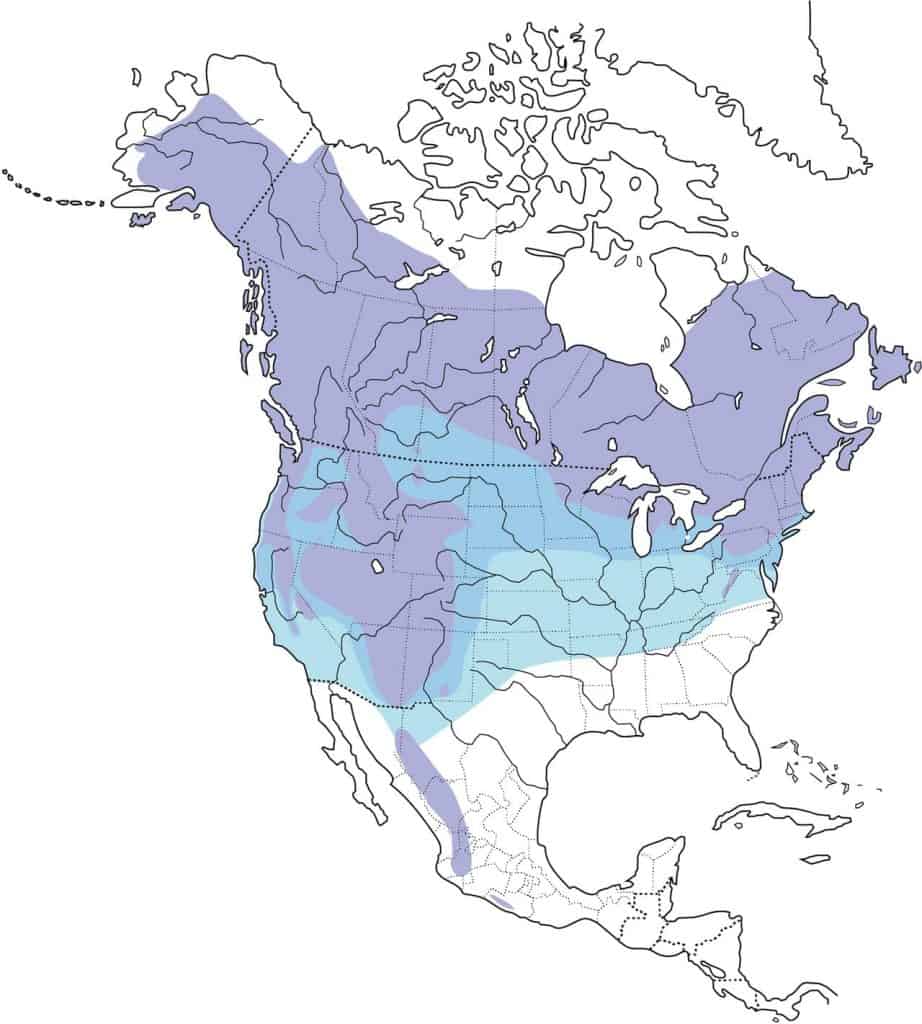
Northern Mockingbird
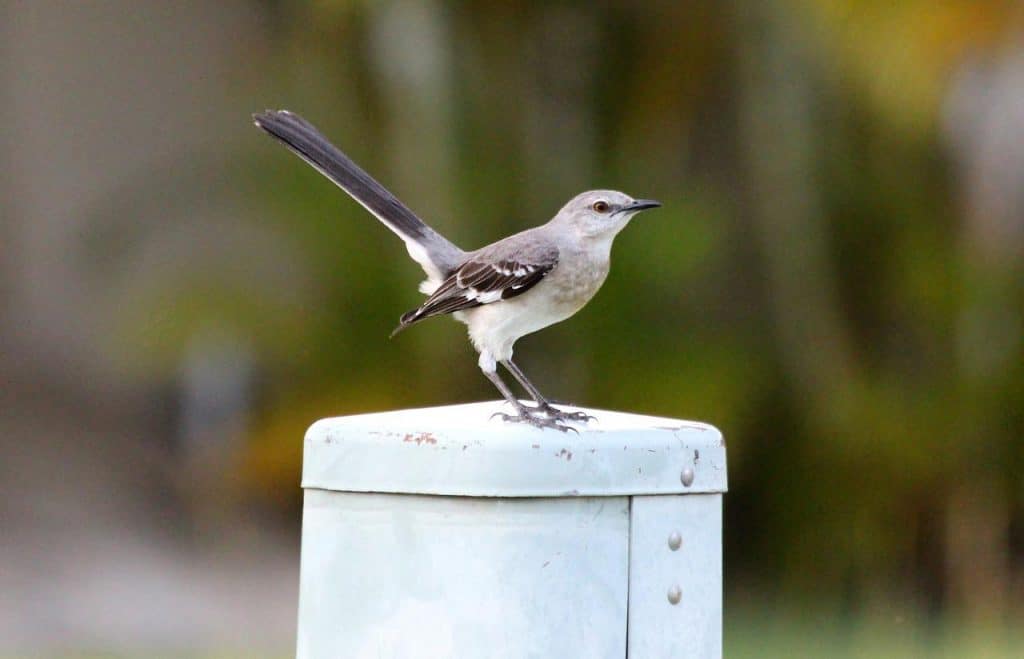
Appearance: Northern mockingbirds are about 10″ long. They have gray above and white below. Wings are dark gray with patches of white. They have long beaks and yellow eyes.
Diet: Insects and berries.
Feeder food: Suet
Habitat: Northern mockingbirds prefer thickets and brushy areas with open areas nearby.
Nesting:
- Nest: They nest in a thick shrub or tree between 1-10′ up. Northern mockingbird males select several nesting sites and begin building nests in each. The female will pick her favorite and finish the nest. They won’t abandon these nests but move to another with each brood
- Brood: 2-3 broods/season
- Clutch: 2-6 eggs/brood
- Egg color: Light blue to greenish-white sporting brown or red spots.
- Egg size: 1.1 inches by 0.8 inches
- Incubation: 12-14 days and fledglings leave the nest at 11-15 days.
Migration: Northern mockingbirds do not migrate. They remain in their year-round range all seasons of the year.
Year-round range: Every US state, the southern edges of Canada’s British Columbia, Alberta, Saskatchewan, Manitoba, Ontario, Quebec, and Mexico.
Range Map
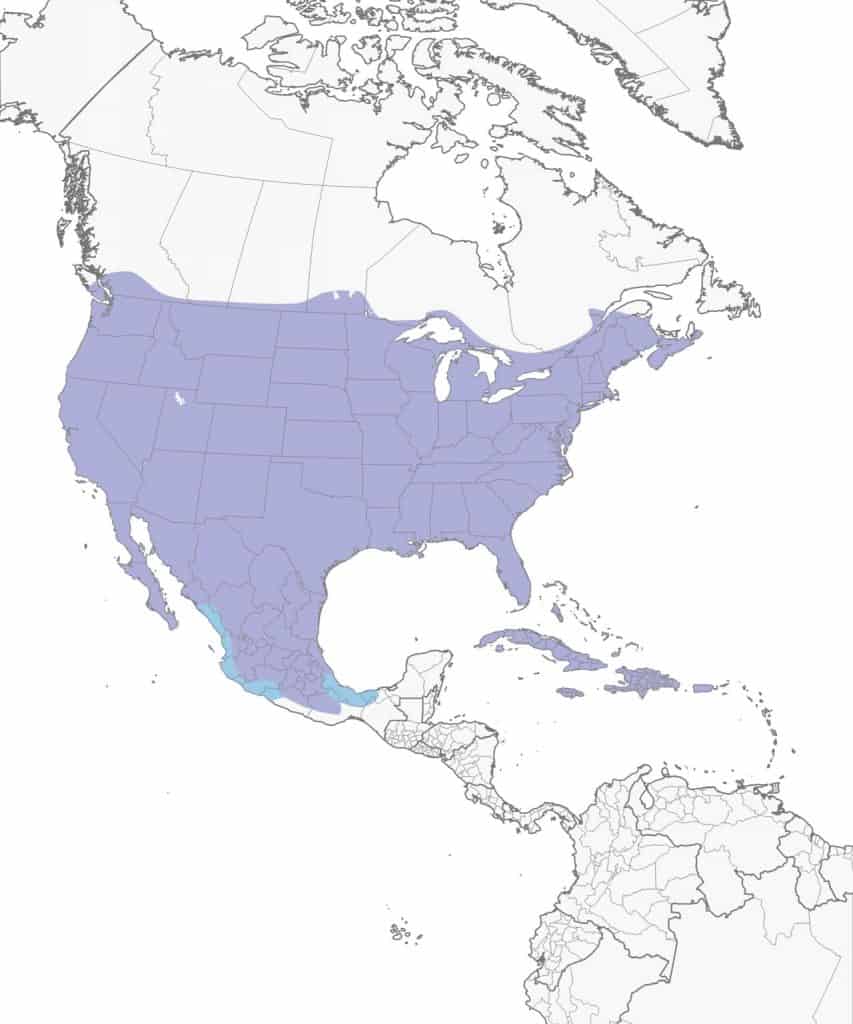
Northern Shoveler
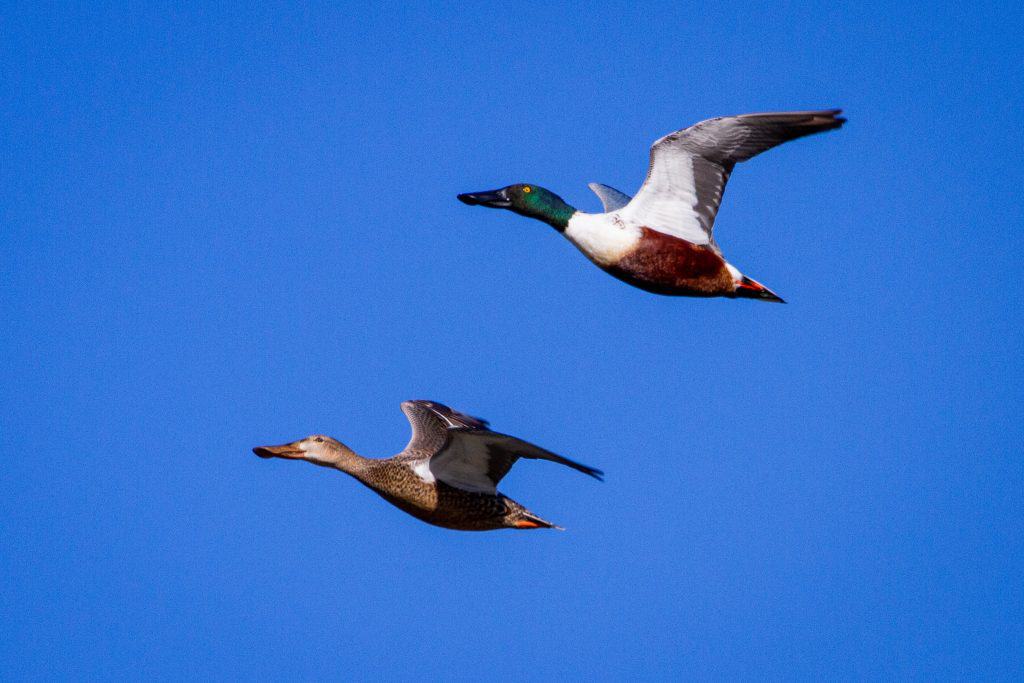
| Appearance | Northern shovelers are medium-sized waterbirds at about 17-20″ in length. They have shovel-shaped heads. The male has a dark green head, black back and feathers, white neck, and brown chest. The female has an orange bill & eggs with brown and white markings throughout her body. |
| Diet | Mollusks, insects, crustaceans, sometimes small fish, aquatic plants, and seeds. |
| Feeder Food | N/A |
| Habitat | Northern shovelers can be found in shallow wetland areas with plenty of vegetation. They’ll also be found in salt marshes, lakes, flooded fields, and other overflow areas that collect water. |
| Nesting | Northern shovelers are grounds nesters. The female generally Broods: 1 broods/season Clutch: 8-12 eggs/brood Egg color: pale olive Egg size: About 2″ x 1.4″ Incubation: Incubation lasts 21-27 days. The young follow their mom out of the nest within a few hours of hatching. They’re able to fly about 52-60 days after hatching. |
Range Map
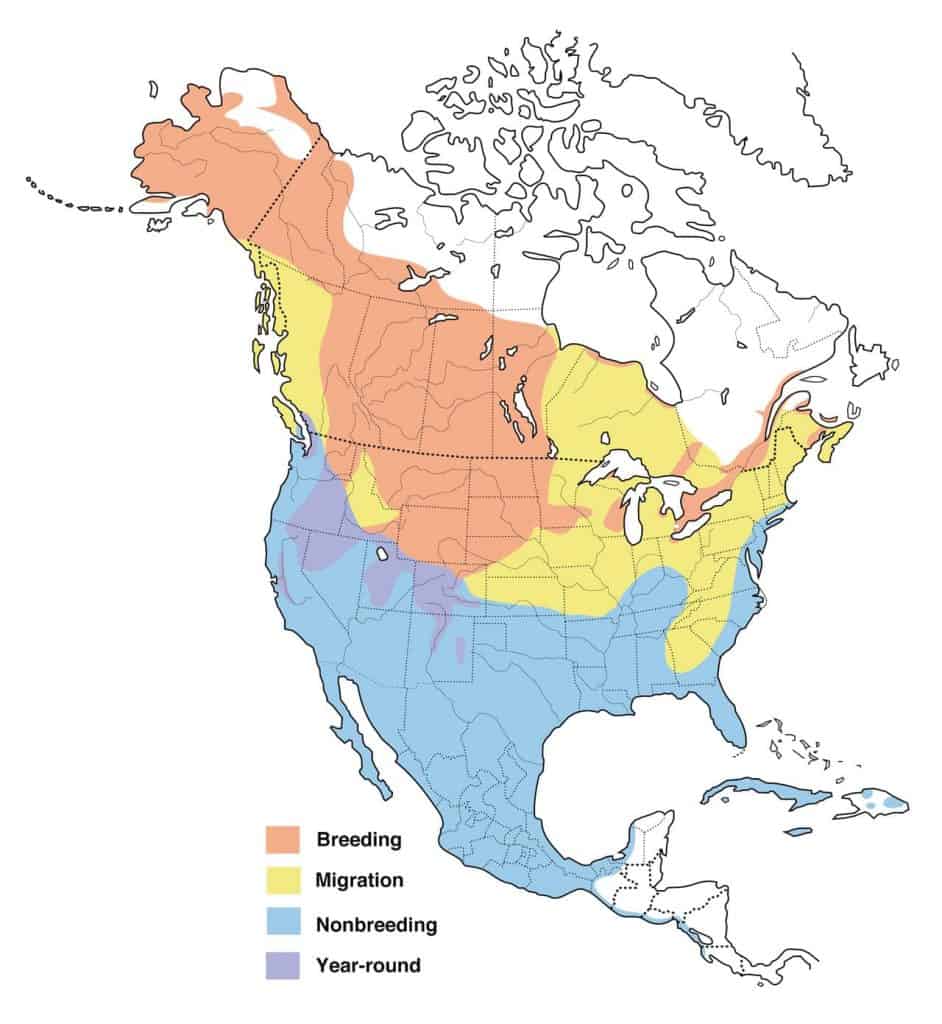
Northern Shrike
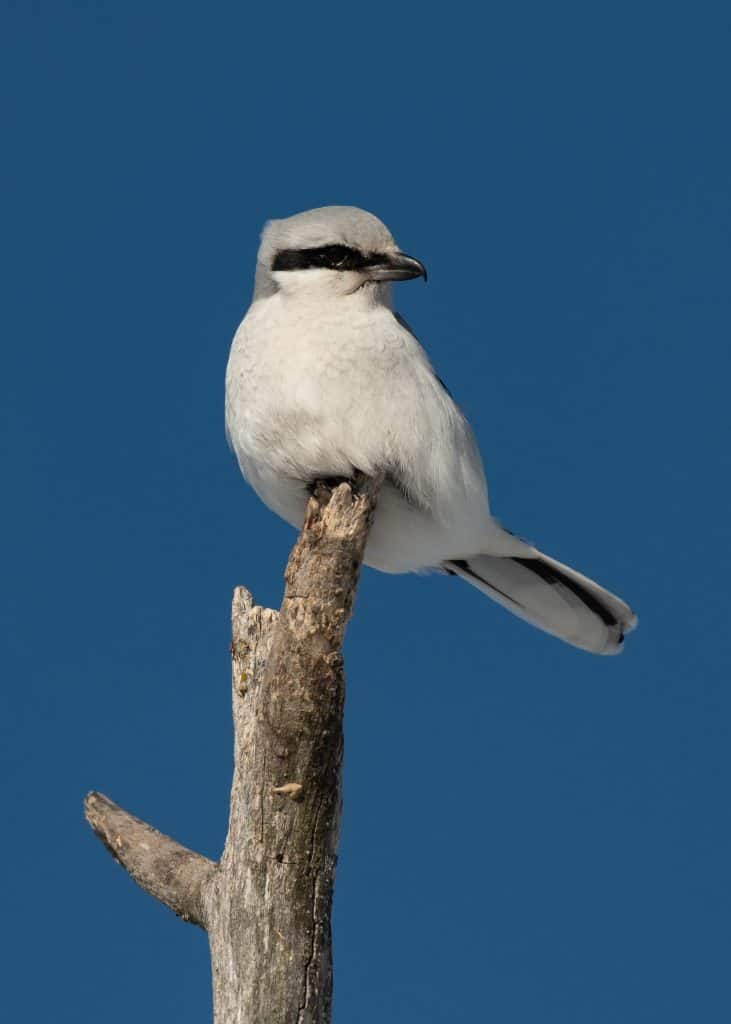
Appearance: Northern shrike is a medium-sized bird about 9.5″ long. They’re gray with white bellies, black wingtips & tails, and a black mask that extends from each eye back to the ear area. Their short bill is notched at the end. Females are the same. Immature northern shrikes are browner.
Diet: Insects, birds, and small mammals.
Feeder food: They may show up at the feeder to hunt feeder birds!
Habitat: Northern shrikes prefer the northern tundra regions, especially where the thick forest meets the tundra. They also are found in open areas.
Nesting: Northern shrikes nest in trees and shrubs, usually 8 feet or higher. They’re not opposed to reusing nests from other birds. They have 1 brood/season, 4-9 gray/green or white eggs/brood, incubation is 14-21 days, and fledglings leave the nest after about 20 days.
Migration: Northern shrikes are migrators. In the spring they migrate north into Alaska and northern Canada regions to breed. Then in the fall, they migrate south into the northern half of the US and southern Canada.
Breeding range: Alaska, Canada’s Yukon Territory, Northwestern Territories, northern Ontario, and Quebec.
Winter range: Northern US states, western states, and Canada’s northern provinces.
Range Map
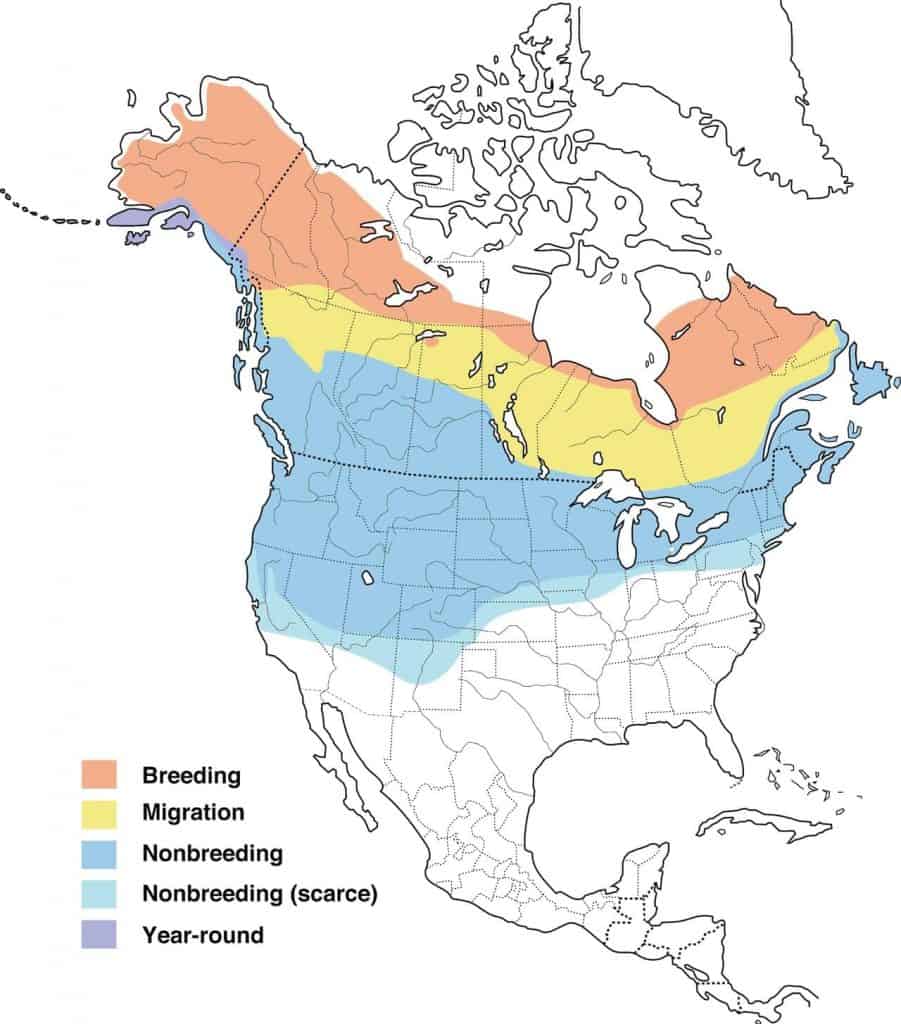
Orange-Crowned Warbler
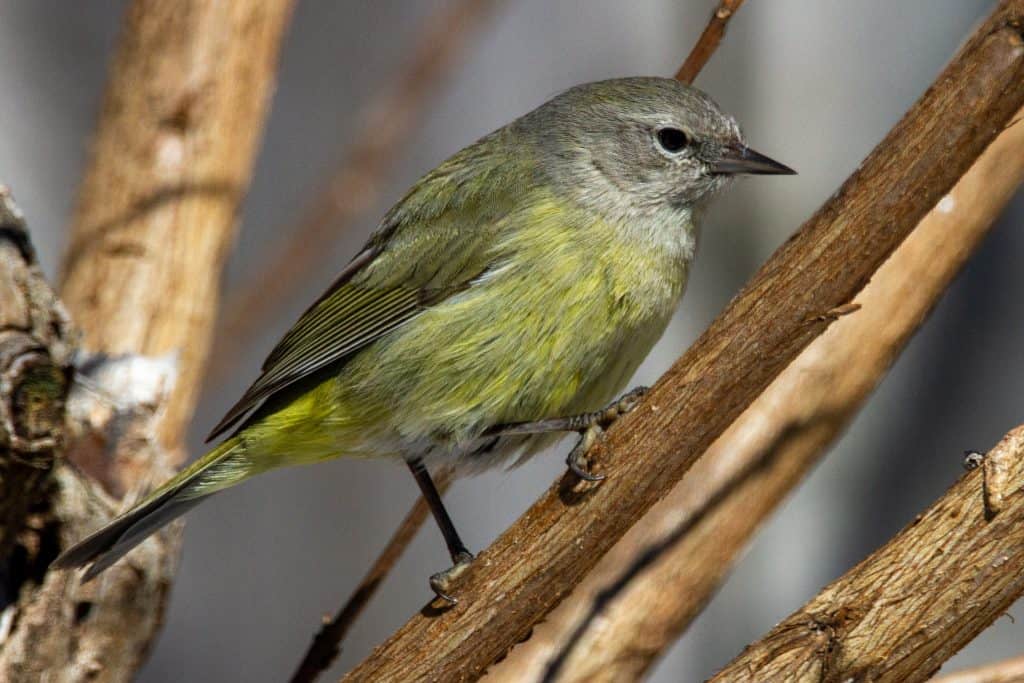
Appearance: The orange-crowned warbler is a small bird about 5″ long. They are olive-green and yellow throughout with an orange crown that is barely visible. There’s a subtle dark line that runs through the eyes. They have yellow underneath that’s smudged with olive green.
Diet: Insects, small berries, and nectar.
Feeder food: Suet and peanut butter spread.
Habitat: The orange-crowned warbler is found in a variety of habitats within its range from low-growing shrubs and thickets to coastal canyons and backyard gardens.
Nesting: They build a cup-shaped nest of twigs and other plant material placed on or near the ground. They have 1 brood/season and 3-6 eggs/brood. The eggs are white/creamy with spots. Incubation is for 11-13 days and fledglings leave the nest at 10-13 days.
Migration: Orange-crowned warblers are migrators. In the spring they migrate north and west to breed and raise young. Then in the fall, they migrate south for winter. That said, they have a small year-round range along the pacific coast (Washington, Oregon, and California) where they remain year-round.
Year-round range: Along the pacific coast of Washington, Oregon, and California.
Breeding range: Alaska, Washington, Idaho, western Montana, Wyoming, Oregon, northern California, Nevada, Utah, Colorado, New Mexico, and all Canadian provinces except Nunavut.
Winter range: Southwest California, southwest Nevada, Mexico, the southern parts of Texas, Mississippi, Alabama & Georgia, South Carolina, southern Texas, Louisiana, Florida, and Mexico.
Range Map
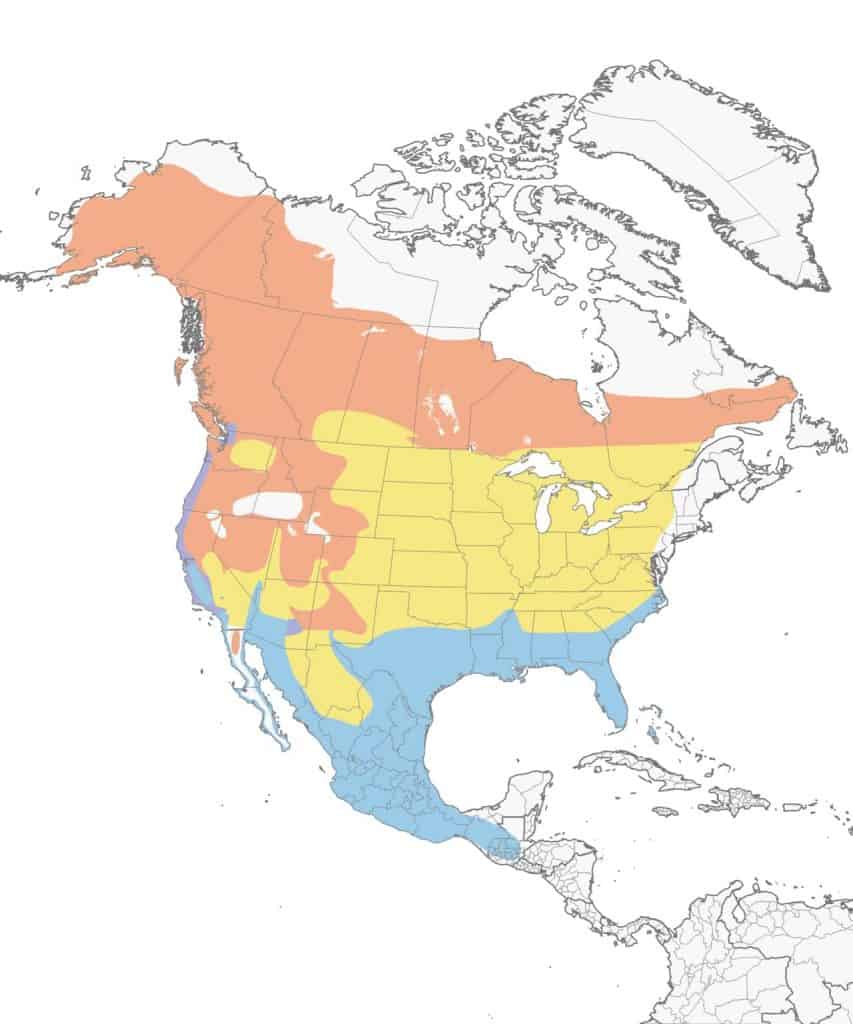
Pine Grosbeak
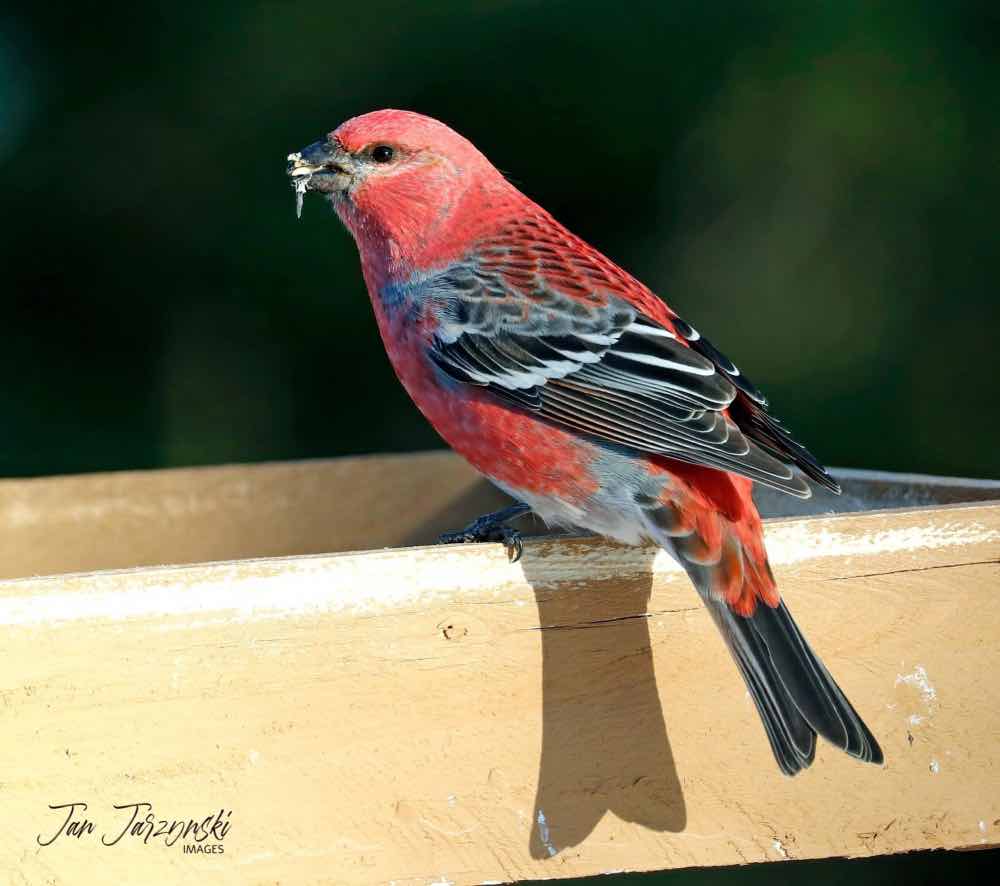
| Appearance | Sturdy bird approx 8-10″ long, soft pinkish-red with gray & charcoal body, short charcoal beak, medium tail with black tip, wings of black, white, and red. No crown. The Female is gray with a yellow head and tail. |
| Diet | Mostly seeds and fruits from their habitat (pine trees). Sometimes supplements with insects. |
| Feeder Food | Black-oil sunflower seeds and suet. |
| Habitat | Open areas with coniferous trees and deciduous trees in winter. |
| Nesting | About 20′ up in evergreen trees rests their rather large nest constructed with roots and twigs then lined grass, pine needles, and feathers. 1 brood/season, 3-4 eggs/brood, incubation lasts 13-14 days and they fledge between 13-20 days. Eggs are light blue and dotted. |
Range Map
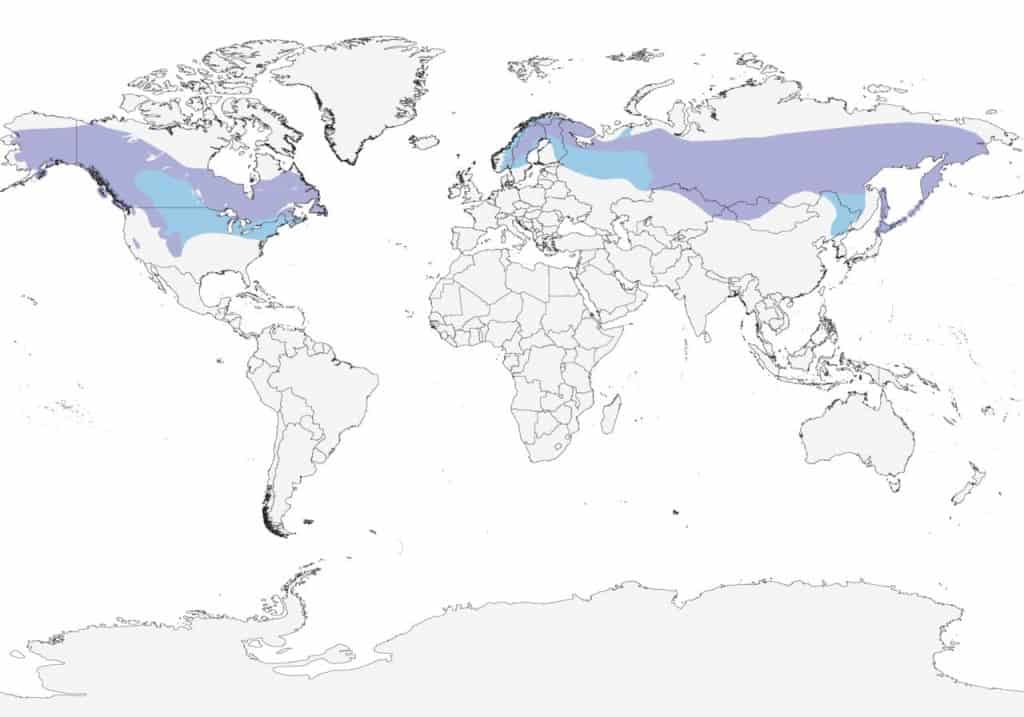
Pine Siskin
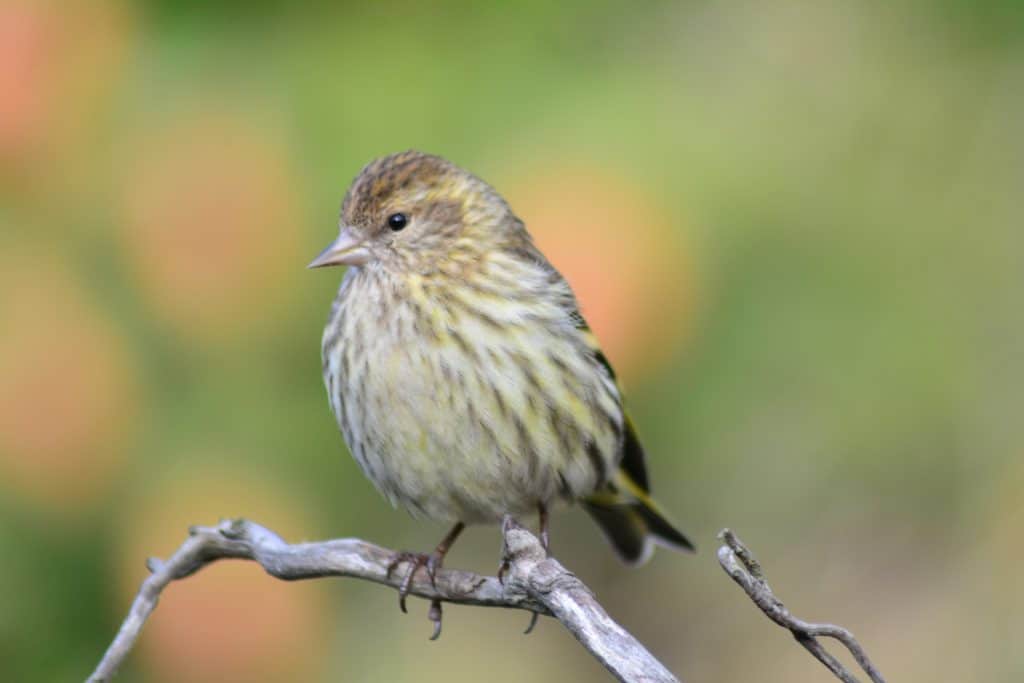
Appearance: Small brown bird about 5″ long with streaks on the back, breast, and belly. They have some yellow in the wing bars at end of the tail. The Female is the same.
Diet: Seeds, insects.
Feeder food: Black-oil sunflower seeds, hulled sunflower seeds, suet & fruit.
Habitat: Open areas, wooded edges.
Nesting: Cup-shaped nest for 2 broods/year. 3-4 eggs/brood that is green/blue with brown spots. Incubation is 12-13 days.
Migration: While some pine siskins remain in their year-round range, most are migrators. In spring, the migrators head south to Canada to breed and raise their young. Then in the fall, they migrate south for the winter.
Year-round range: The northern edge of the US, the Pacific Northwest states, the southern edge of the Canadian provinces, and the central strip of Mexico.
Breeding range: Alaska’s southeastern corner, the southern part of Canada’s Northwest Territories, the northern part of British Columbia, Alberta, Saskatchewan, Manitoba, Ontario, and Quebec.
Winter range: The entire US (outside of the year-round range).
Range Map
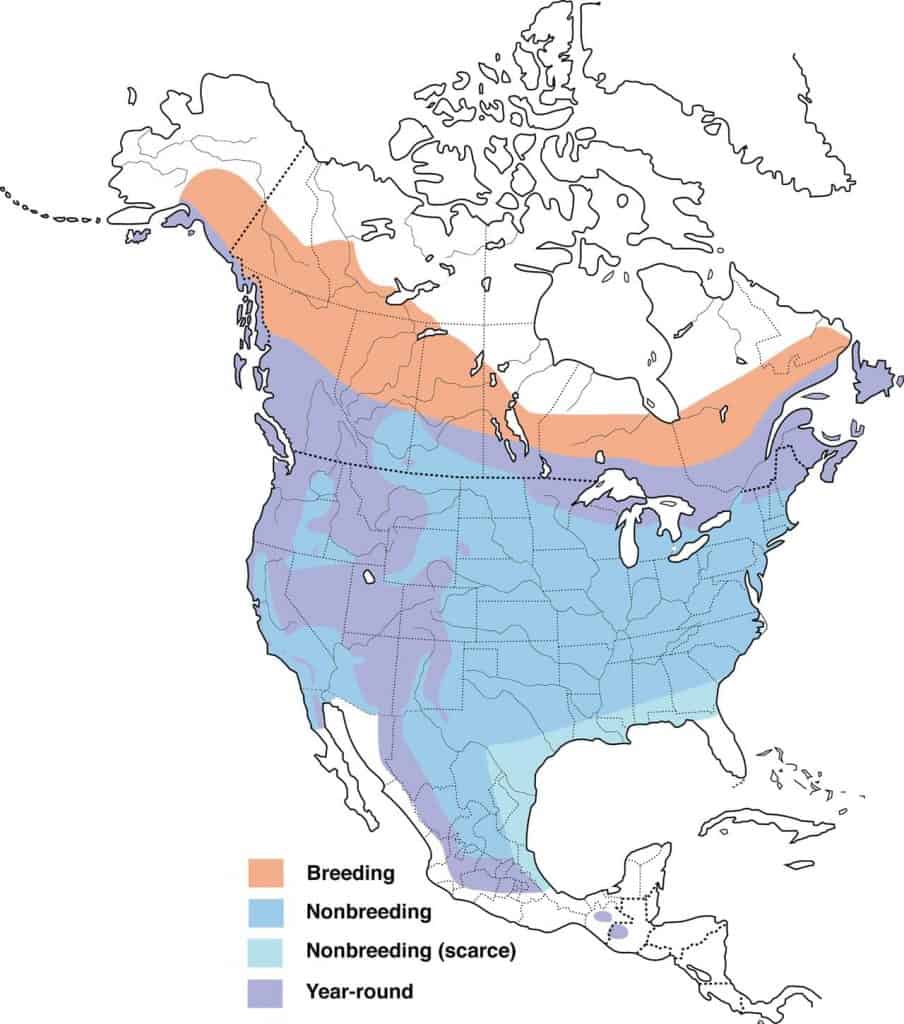
Pinyon Jay
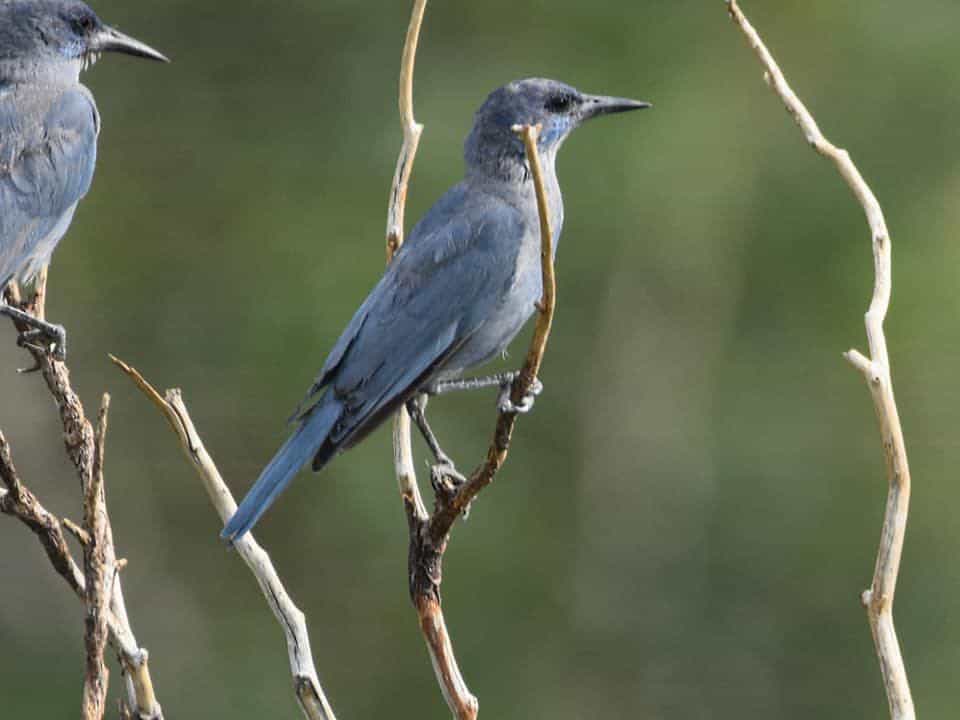
Appearance: 10-11″ long bird, dusty blue body and lighter blue belly and throat, short tail, and no crown. The female looks similar.
Diet: Primarily Pinyon-pine seeds, acorns, fruit, and grains. Also consumes insects, lizards, snakes, nestling birds, and small mammals.
Feeder Food: Whole peanuts, sunflower seeds, suet, cracked corn.
Habitat: Forested areas comprised of Pinyon-juniper, sagebrush, scrub oak, and other pine trees.
Nesting: Large bulky nests of sticks and twigs in the trees about 3-115′ up. 1 brood/season, 2-5 eggs/brood, eggs are 1.3-1.5″ long, pale blue with dark brown specks, incubation last 17 days and young fledge between 21-22 days.
Range Map
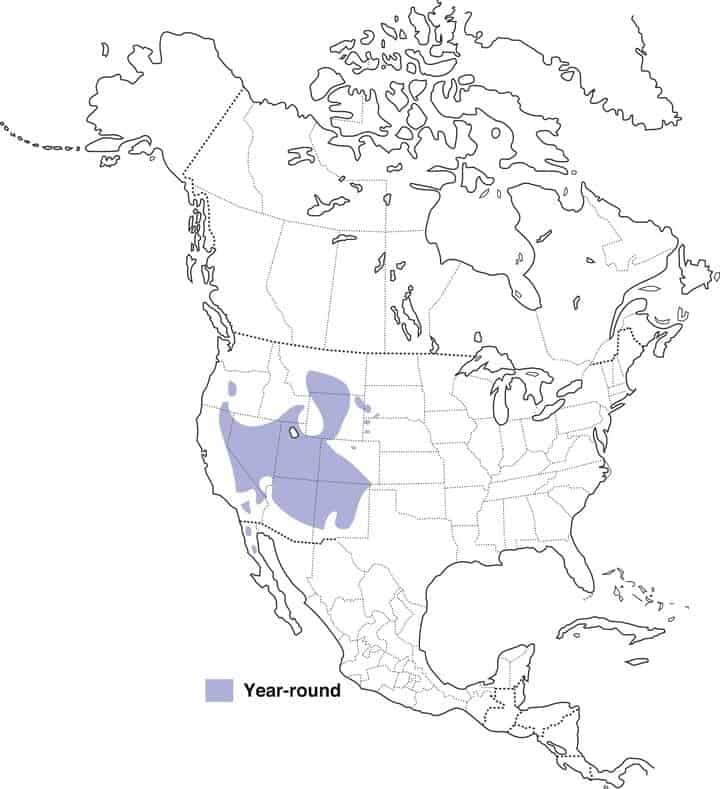
Red Crossbill
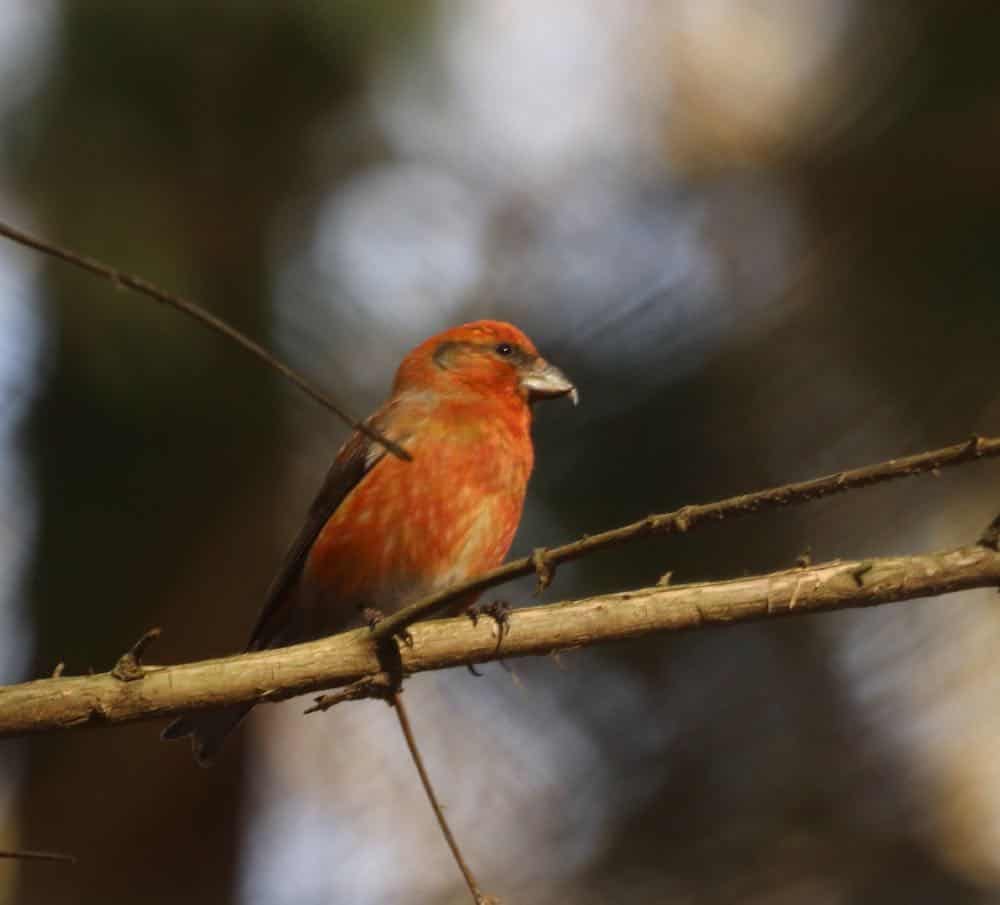
Appearance: The red crossbill is a small bird about 6.2″ long, dark red-orange with brown singes and tail. Their bill is long, pointed, and “crossed”. A brighter color of red on the head and rump. No crown. The female and young are pale yellow and gray.
Diet: Seeds – especially those inside pinecones. The bird’s “crossbill” is designed to pry open pinecones to get at the seed inside.
Feeder food: Black oil sunflower seed.
Habitat: Red crossbills either remain in their year-round territory for winter or expand south to create a wide winter range that includes Canada, the Pacific Northwest, states west of the Great Plains, Minnesota, Wisconsin, Michigan, New York, Vermont, Connecticut, and Massachusettes. They prefer mature coniferous forests.
Migration: While many red crossbills remain in their year-round range all seasons of the year, many migrate south for the winter.
Year-round range: The western half of the US, Mexico, and all Canadian provinces except Nunavut.
Winter range: Primarily northern Nevada, eastern Montana, North Dakota, South Dakota, northern Kansas, southern Minnesota & Wisconsin, northern Michigan, Pennsylvania, and New England. To a lesser degree, the remaining southern US states.
Range Map
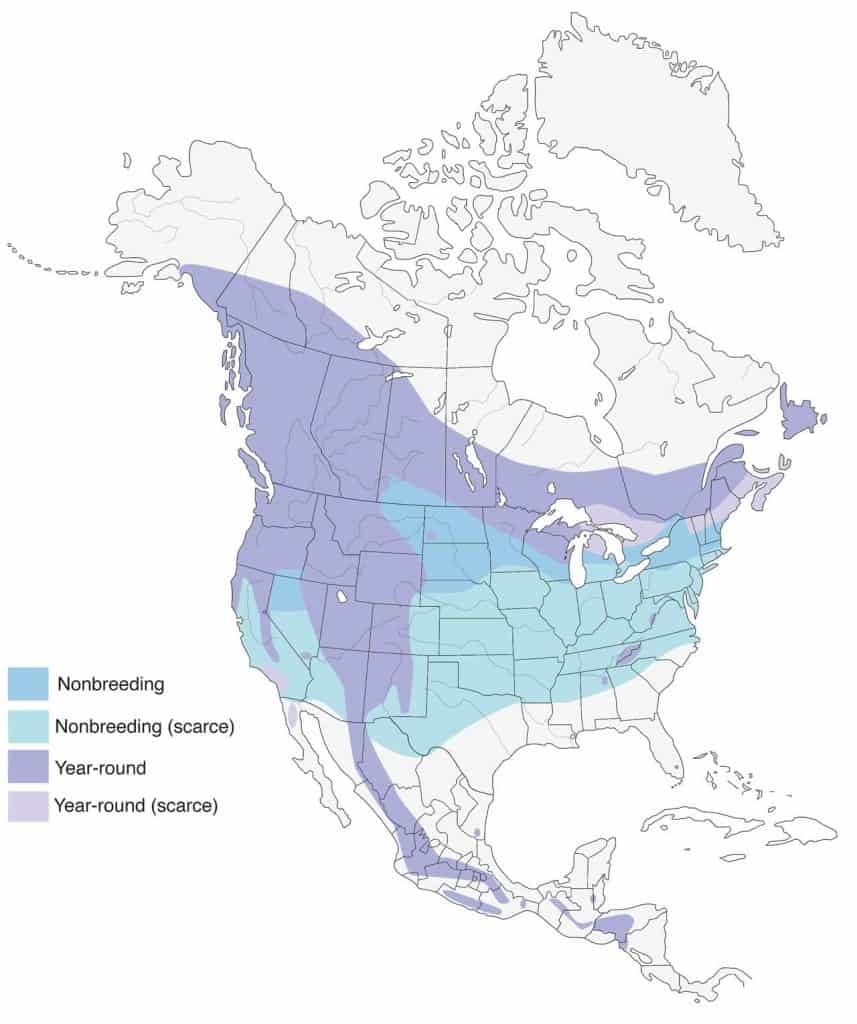
Red-Breasted Nuthatch
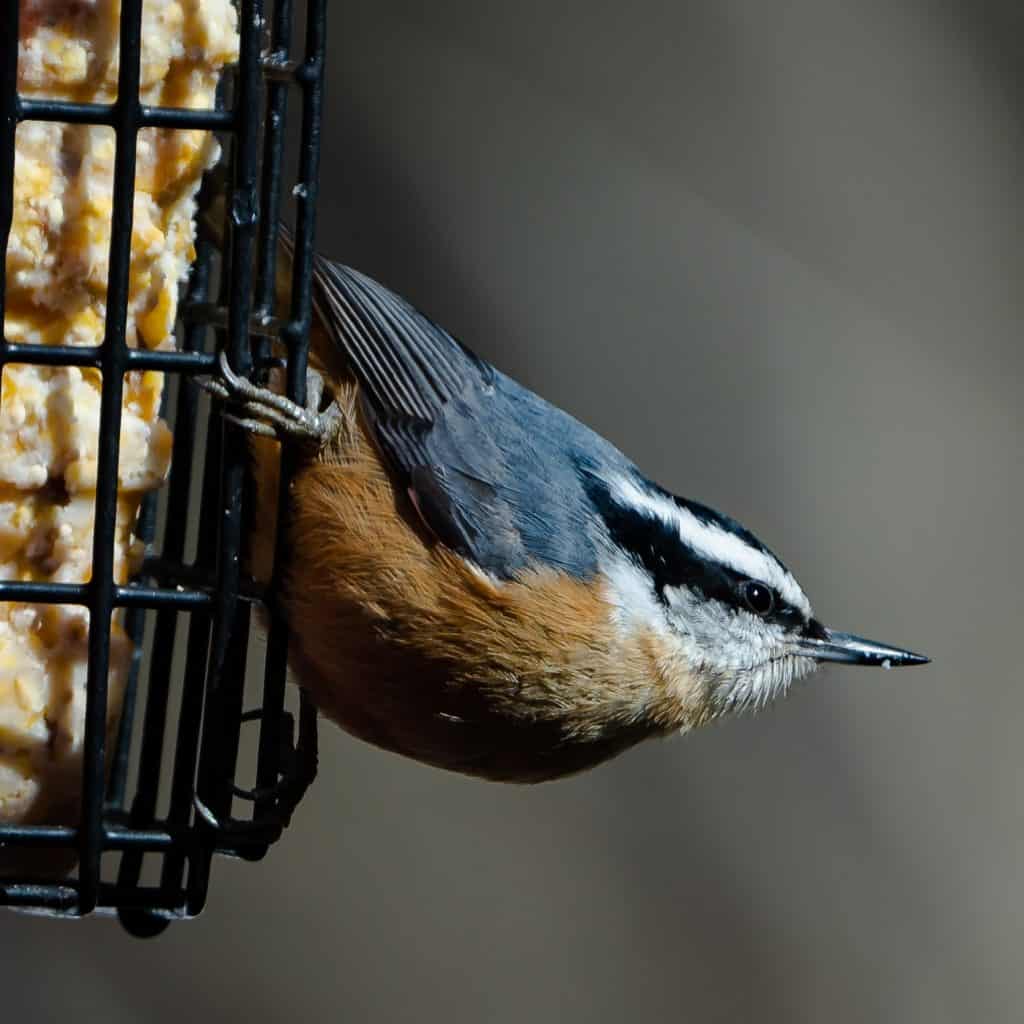
Appearance: The red-breasted nuthatch is a small bird about 4.5″ long, with gray/blue backs, a white head with black stripes running over either eye, orange-cinnamon-colored breast, and a pointy pick-like beak. The females look the same except their underside is a more faded color. Usually spotted climbing upside-down on a deciduous tree foraging for insects beneath the bark.
Diet: Insects, spiders, and other bugs.
Feeder food: Suet, sunflower seeds, shelled peanuts, fruit.
Habitat: Forested areas primarily comprised of coniferous trees (i.e. pines). Woodsy areas of deciduous trees in the east. Southern birds prefer mountainous regions until winter comes in which case they head to lower land.
Nesting: Red-breasted nuthatches are cavity nesters and they prefer to excavate their own holes. They have 1 brood/season, and 6 eggs/brood, eggs are white & speckled with red-brown.
Migration: Red-breasted nuthatches are partial migrators. While many remain in their year-round range, others migrate south for winter.
Year-round range: Southern Alaska, states in the western third of the US, northern Minnesota & Wisconsin, Michigan, Pennsylvania, and New England as well as all Canadian provinces except Nunavut.
Winter range: US states that are not part of the year-round range.
Range Map
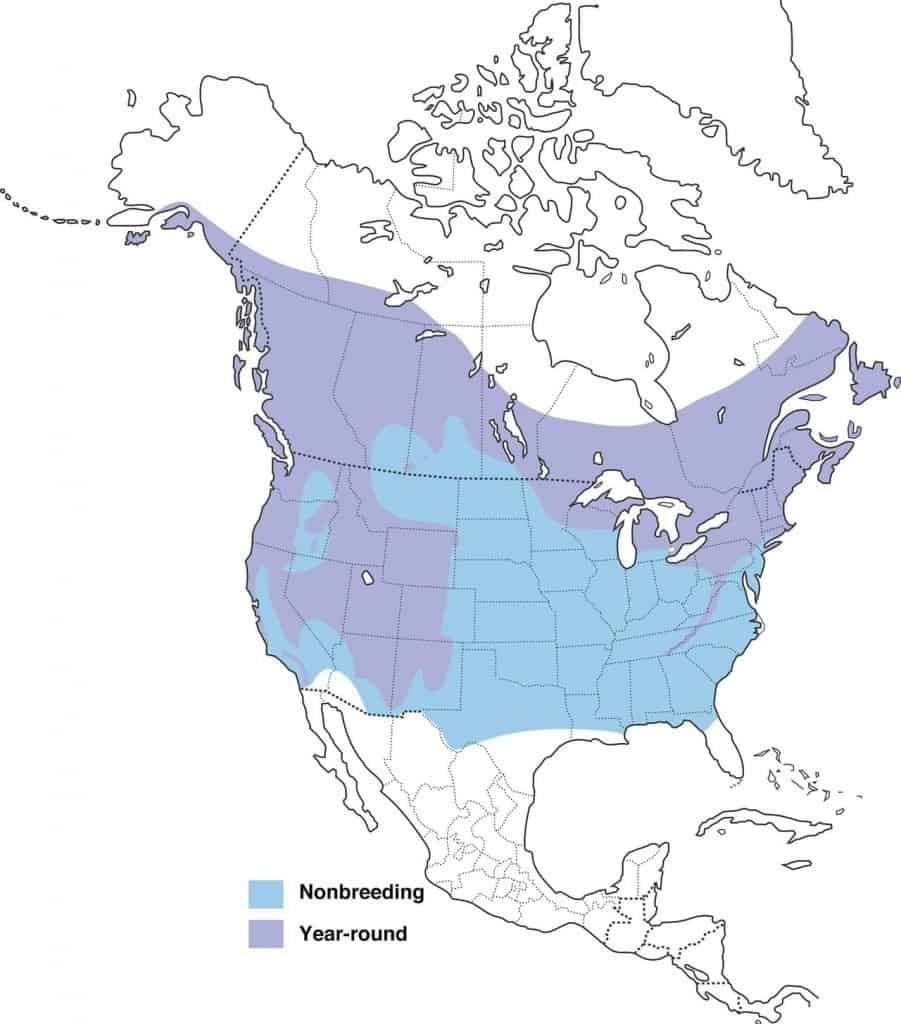
Red-Naped Sapsucker
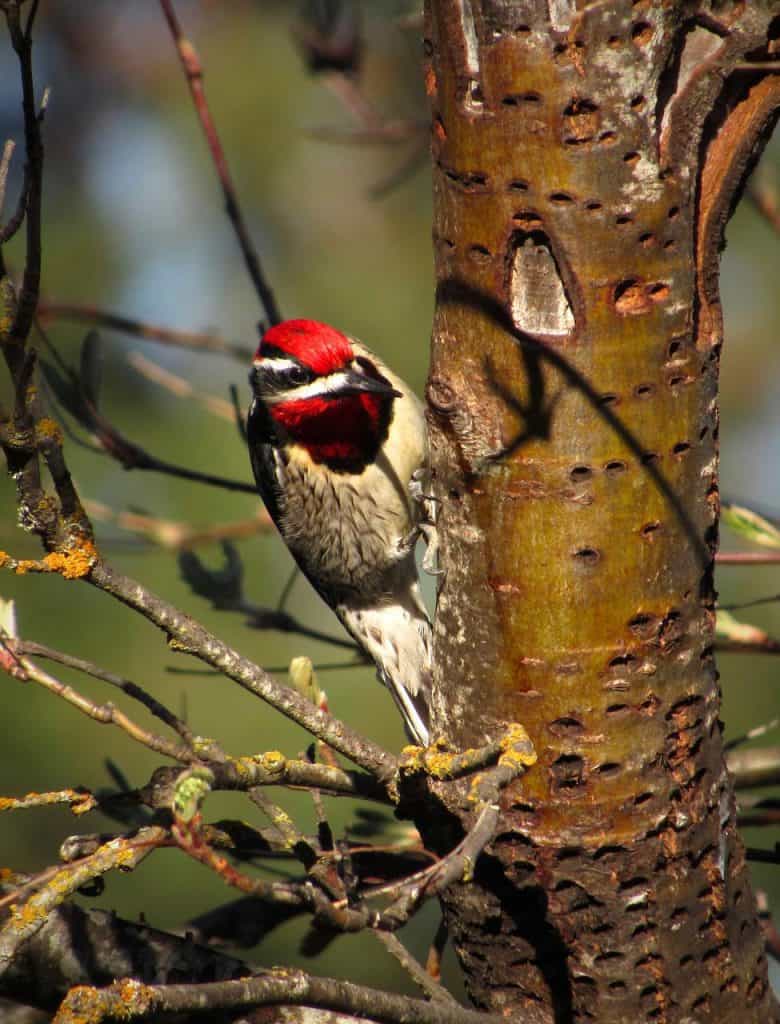
Appearance: Red-naped Sapsuckers’ heads are striped with black, white and bright red. Bright red also encompasses their cap, throat, and back of the neck. The belly is spotted black and white, with a dark yellow color. Females are the same except they have a white patch on their chin – males’ chins are red. Juveniles have a brown cap and a brown color on their belly and head.
Diet: Tree sap, arthropods (ants, caterpillars, mayflies, beetles, mothers), fruits, berries, and seeds.
Feeder food: Suet.
Habitat: Mixed forests of deciduous and coniferous trees, orchards, and wooded areas by streams.
Year-round range: Eastern California, southcentral Nevada, western Utah, Arizona, and New Mexico.
Breeding range: Their breeding range includes the Canadian provinces of British Columbia (southeastern) and Alberta (southern), as well as eastern Washington, northeast Oregon, Idaho (except southwestern), the western halves of Montana, Wyoming, & Colorado, and northern New Mexico, northeast California, northern Nevada, Utah, and northern New Mexico.
Winter range: Their year-round range plus southern California, Mexico, southern Arizona, southern New Mexico, and western Texas.
Nesting Behavior: Red-naped sapsuckers are cavity nesters. They excavate the holes themselves and seem to prefer aspens, larch, cottonwood, and many other varieties of conifers. They’ll use the previous year’s tree for the new nest site but excavate a new hole. They have 1 brood/season, 3-7 white eggs/brood, incubation lasts 8-12 days, and fledglings leave the nest after about 23-32 days.
Migration: Red-naped sapsuckers are short-range migrators. While a small population of this species remains in the year-round range all seasons, most migrate north into southern Canada for breeding, and as far south as Mexico for winter.
Range Map:
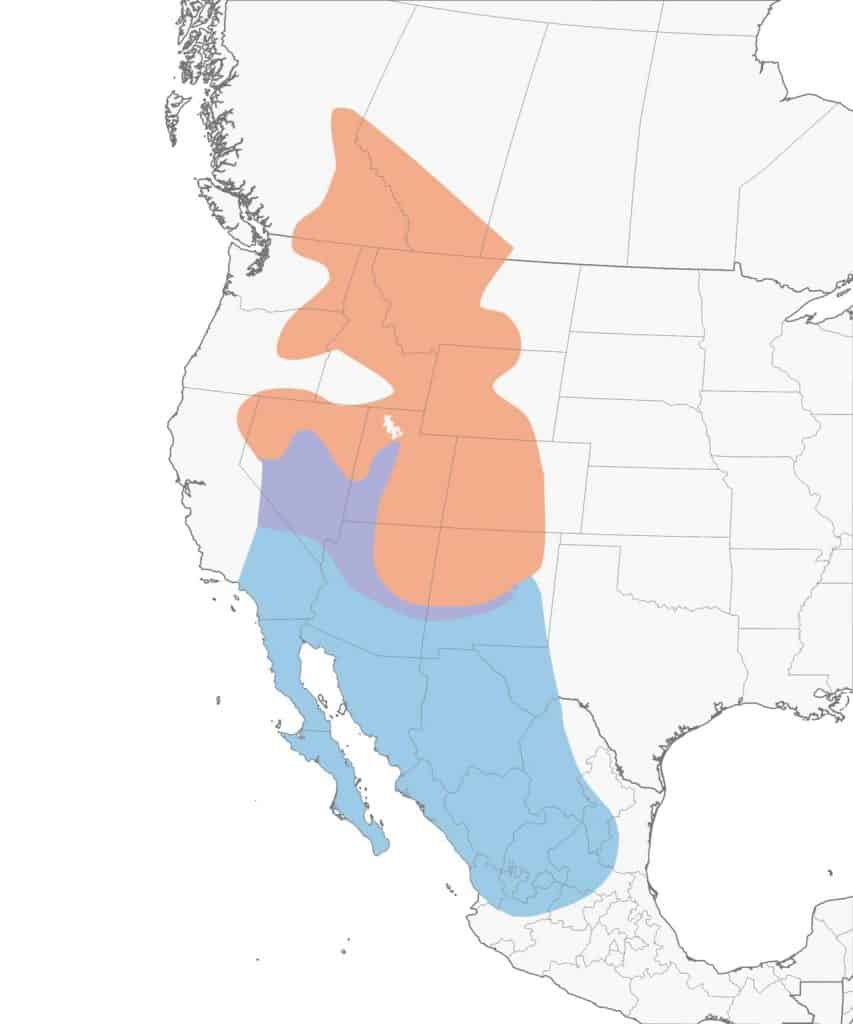
Ring-Billed Gull
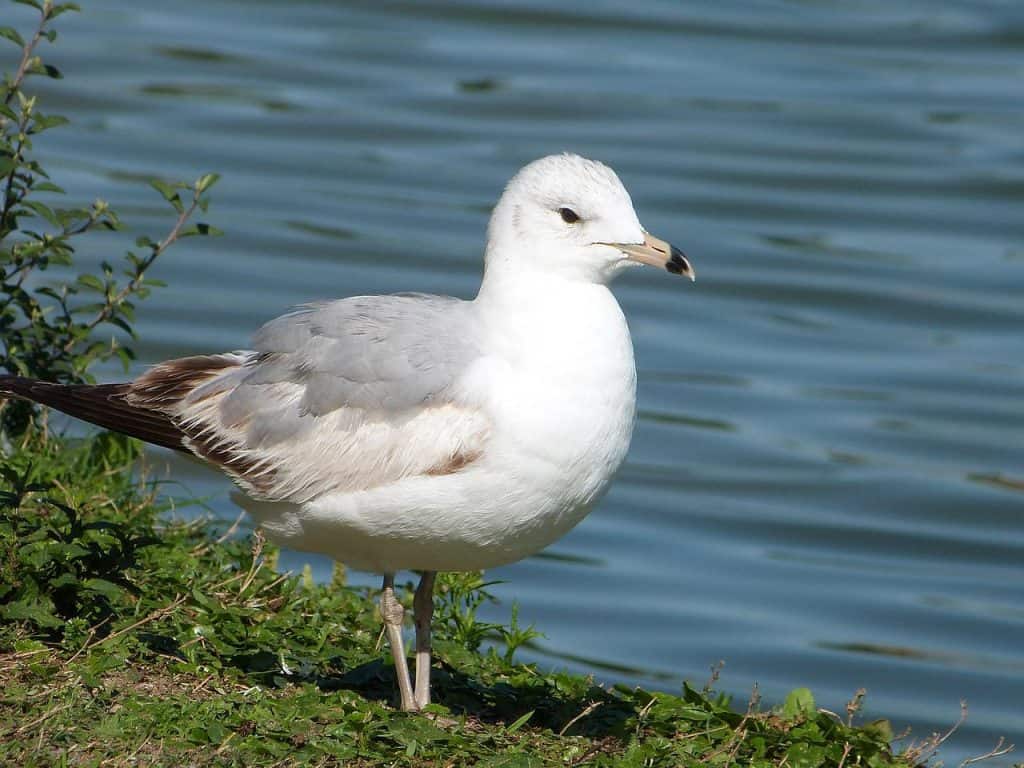
| Appearance | Ring-billed gulls are about 17 1/2″ long. They’re light gray above and white below. The bill is yellow with a black ring. Their legs and eyes are yellow. |
| Diet | Scavenges along water edges for garbage refuse, fish, insects, earthworms, and grains. |
| Feeder Food | They don’t visit feeders. |
| Habitat | In and around water. |
| Nesting | Ring-billed gulls are ground nesters. They have 1 brood/season and 2-4 eggs/brood. Incubation lasts 20-31 days and fledglings leave the nest after 4-5 days. |
Range Map
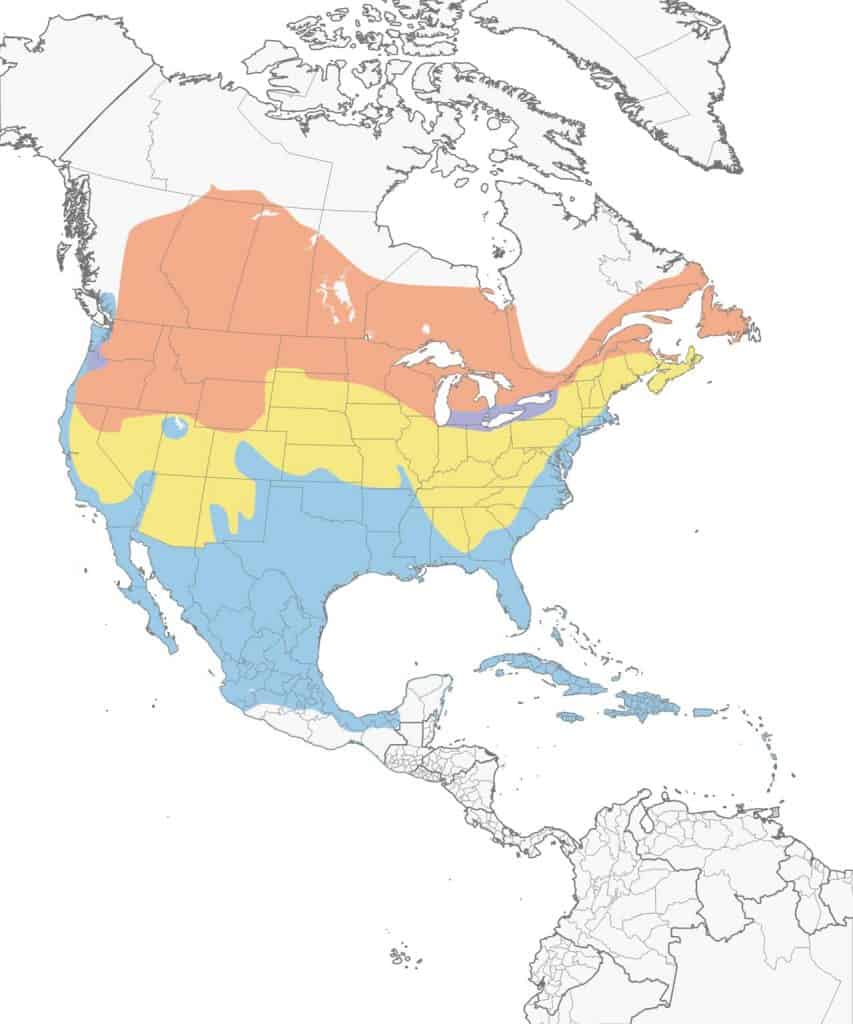
Rock Pigeon
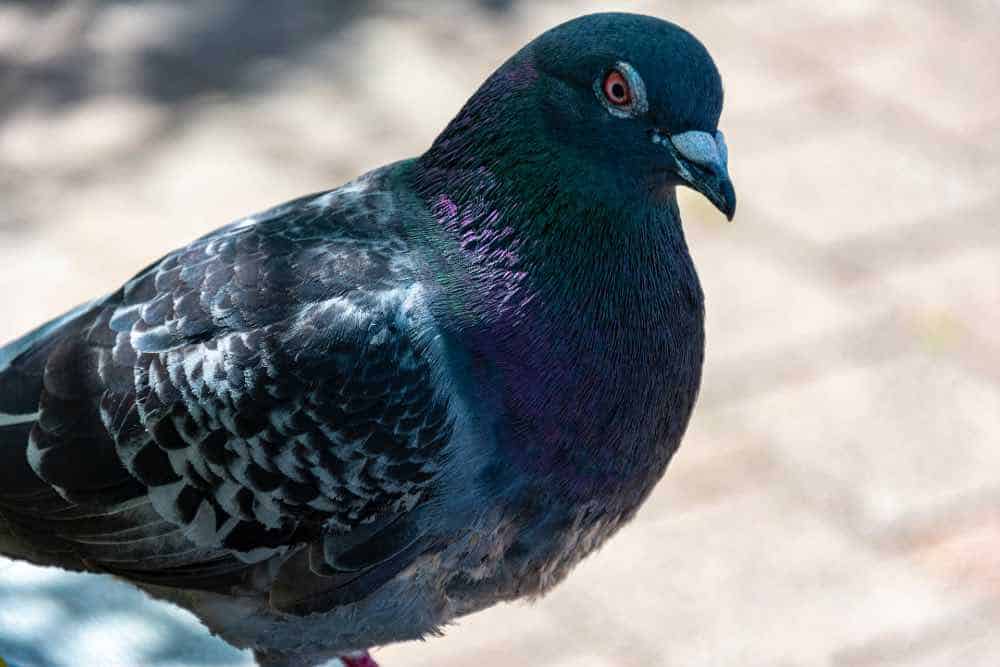
Appearance: Large bird 12-14″ long, chubby with blue/gray wings with black pointy tips, short red legs, black, round wide tail, and iridescent neck.
Diet: Grains, seeds, and fruit. Commonly seen scavenging trash cans for food.
Feeder food: Millet, cracked corn, black-oil sunflower seed, safflower, peanut hearts.
Habitat: Common around cities and towns as well as farmlands
Nesting: Rock pigeons build a large nest of sticks and grass wherever there’s a ledge (e.g. highway overpass, barns, bridges, tall buildings). 1-6 broods/year, 1-3 eggs/brood, eggs are white, incubation about 18 days and the young fledge at about 25-32 days.
Migration: Rock pigeons are not migrators. They remain in their year-round range all seasons of the year.
Year-round range: Every US state, the southernmost edges of Canada, and Mexico.
Range Map
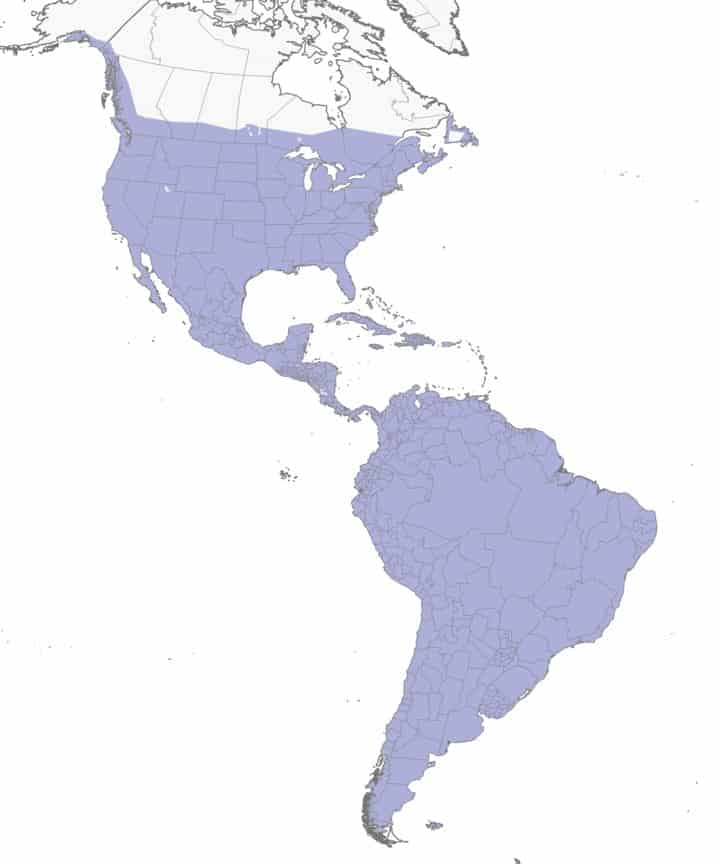
Rough-Legged Hawk
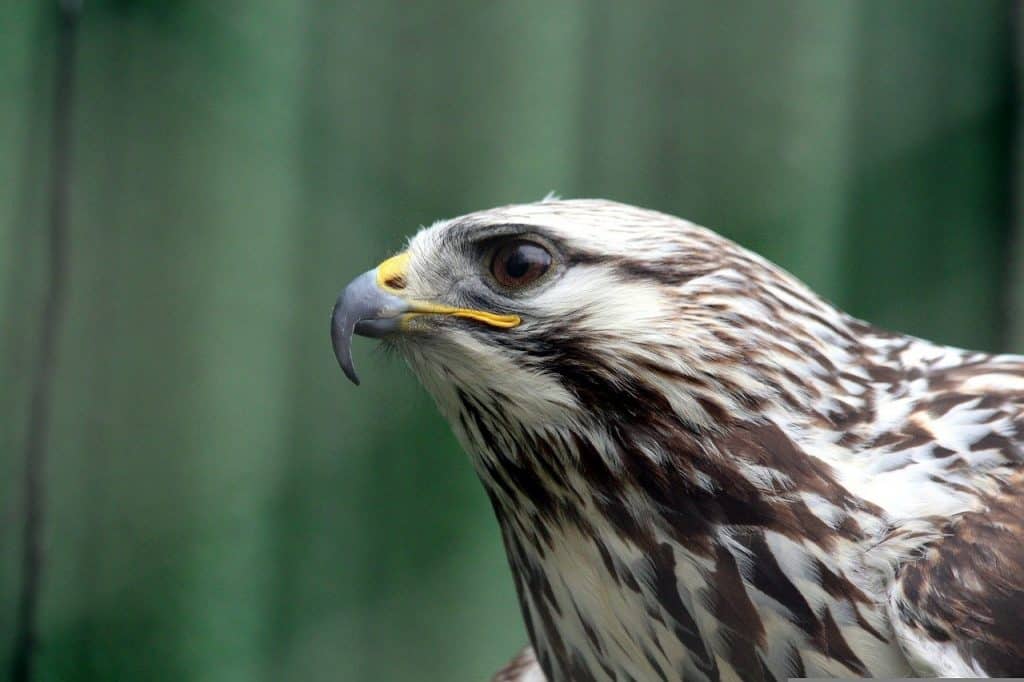
Appearance: The rough-legged hawk is about 19-21″ long and dark brown with white streaks throughout, a dark brown spotted belly and tails & wings have dark edges. The females are similar but have lighter heads and the belly patch is solid dark brown. There are 2 variations of this bird – a light and a dark.
Diet: Small & medium mammals (e.g. voles, rabbits, gophers) and birds.
Feeder food: They are not feeder birds.
Habitat: Open fields, deserts, and commercial areas with wide open spaces.
Nesting: They nest along cliffs and may build or reuse a nest from a prior brood. They have 1 brood/season, 1-7 green/blue pale eggs/brood, incubation is 30-38 days, and the fledglings leave the nest after about 30-45 days.
Migration: Rough-legged hawks are migrators. They migrate to north Canada in the spring to breed and raise their young. Then in the fall, they head south into the US for winter.
Breeding range: Western Alaska and the northern edge of Canada.
Winter range: All US states except Tennessee, South Carolina, Georgia, Mississippi, Alabama, Florida, and the southernmost edge of Canada.
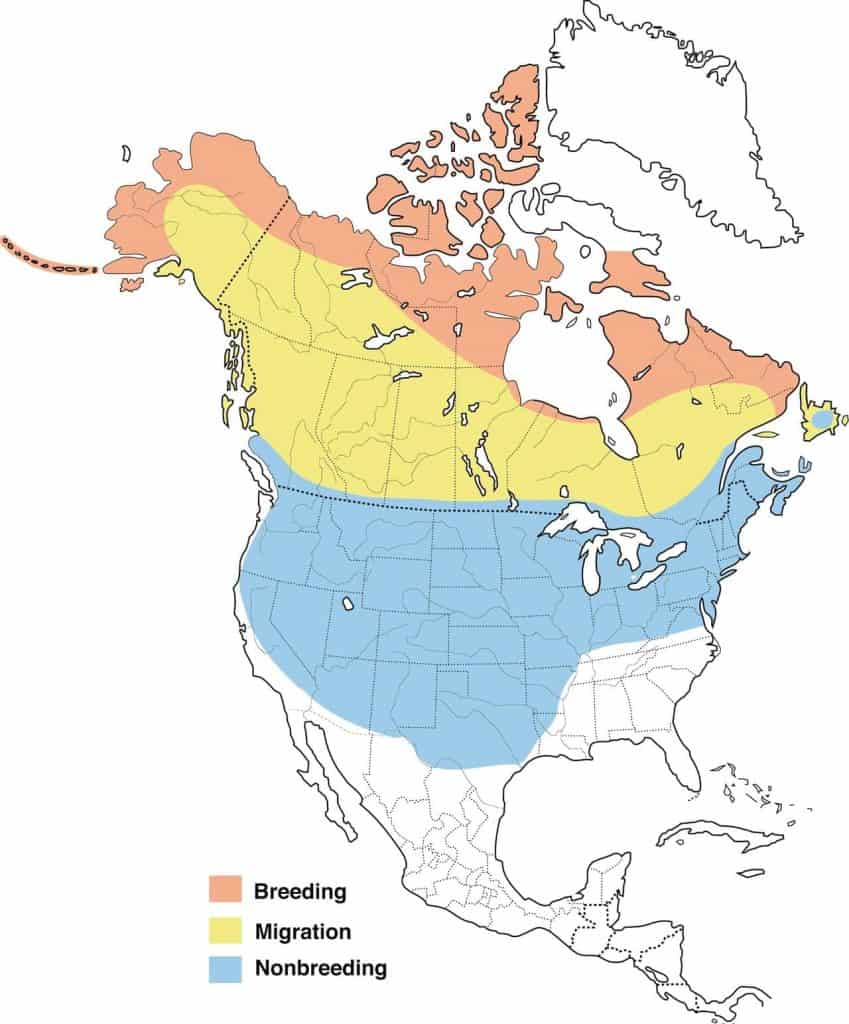
Ruffed Grouse
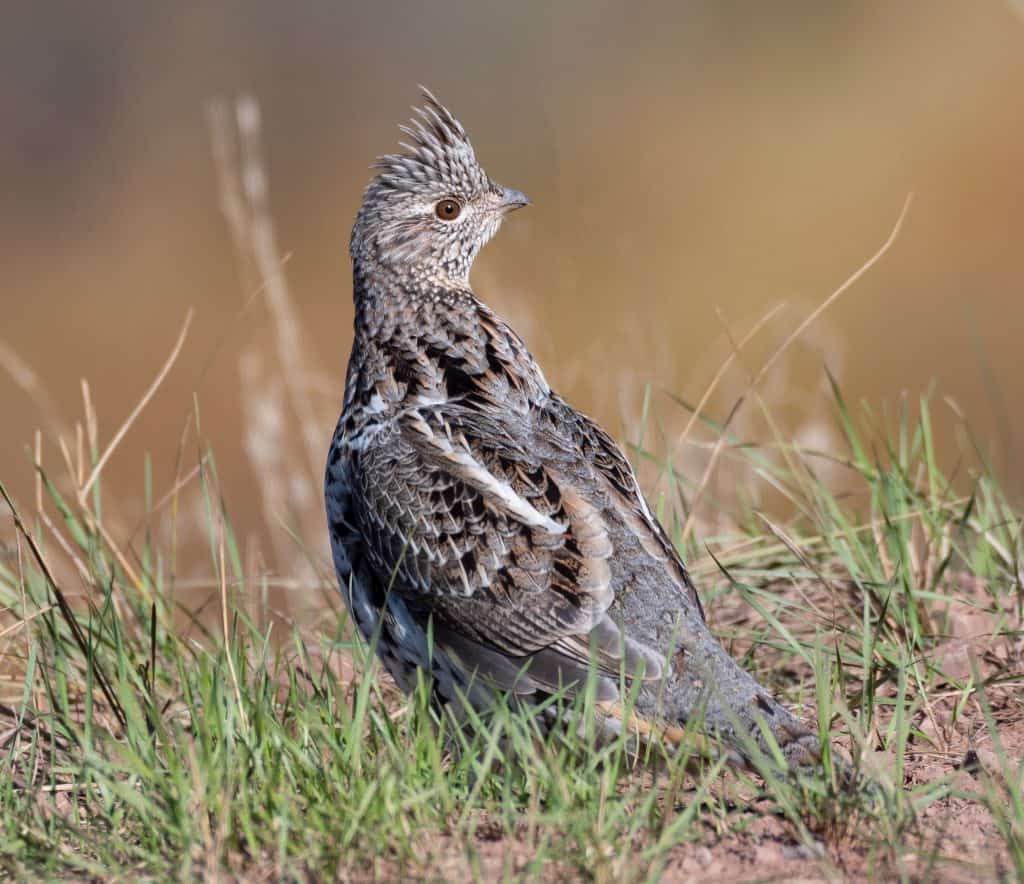
Appearance: The ruffed grouse is a medium-sized bird about 16-20″ long. They’re primarily brownish gray with a white chest/belly spotted with dark brown. They have a short crest, fanned out tail, short legs, and a short stubby beak. The females look the same.
Diet: Ruffed grouse are omnivores. They eat leaves, buds, fruits, shrubs and other vegetation. When in season, they’ll snack on fruit and acorns.
Feeder food: This bird is a ground forager that rarely visits a feeder.
Habitat: This bird prefers forested areas comprised of deciduous and coniferous trees as well as open clearings. They can commonly be found along streams.
Nesting: The ruffed grouse nest is placed on the ground and usually in a shallow depression. They have 9-14 pinky/buff eggs that are sometimes spotted brown. Incubation lasts 23-244 days. Chicks leave the nest after 24 hours as they can already move, walk, and feed themselves.
Migration: Ruffed grouse are not migrators. They remain in their year-round range all seasons of the year including Alaska, Canada, and northern U.S. states.
Range Map
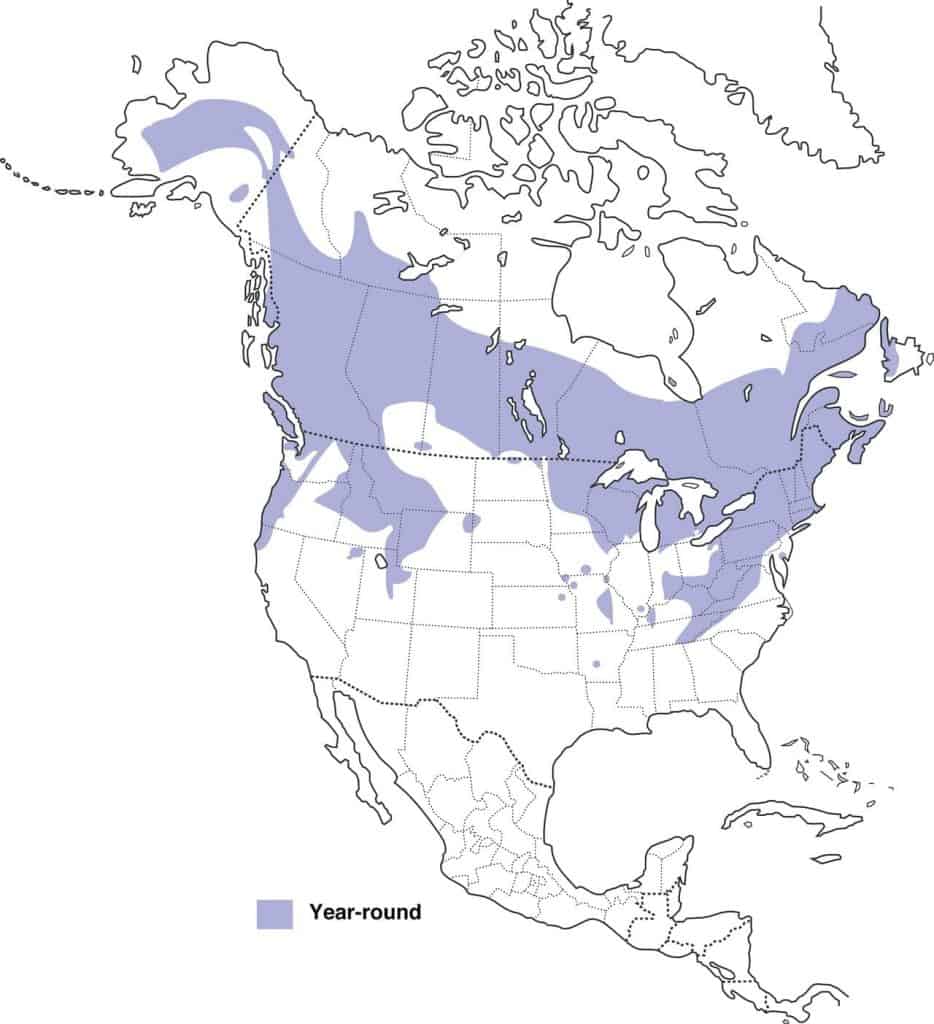
Short-Eared Owl
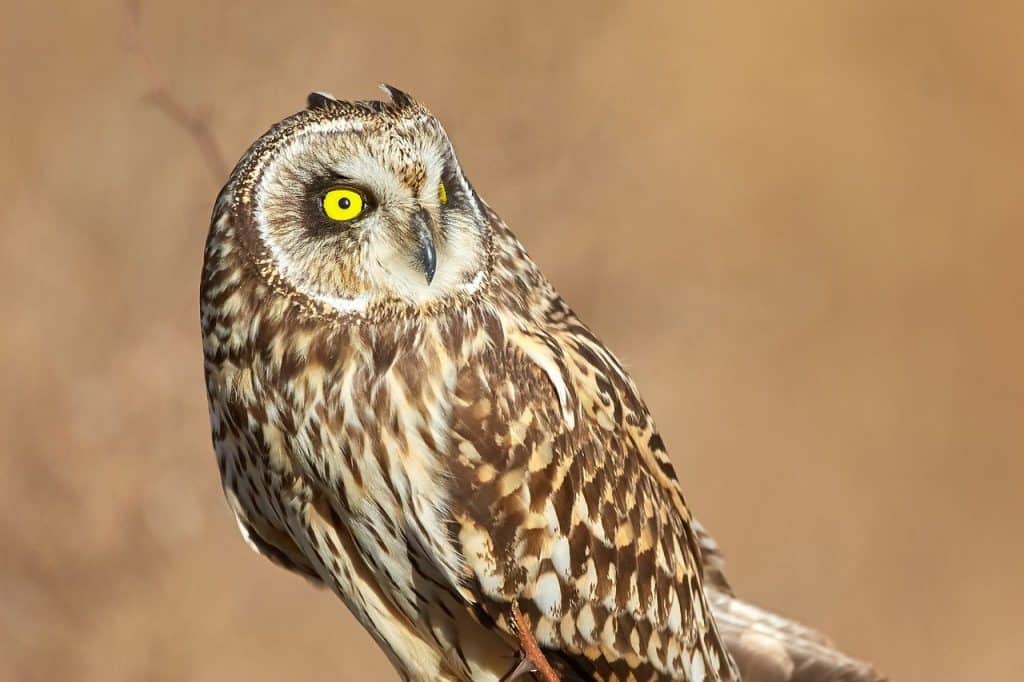
Appearance: Short-eared owls are medium-sized owls at about 14-17″ long. They’re brown spotted birds with tan, white, and ivory on the upper parts. The face is lighter and the eyes are yellow surrounded by black. As you would expect, their ears are so short they appear to be missing. Females are the same.
Diet: Small mammals such as shrews, moles, rabbits, gophers, bats, and rodents in which they first decapitate and then swallow the prey whole.
Feeder food: Short-eared owls do not visit feeders.
Habitat: Open grassland areas as they prefer to perch on the ground or low in trees.
Nesting: Short-eared owls nest on the ground in the grass with surrounding vegetation to hide it. They have 1-2 broods/season and 1-11 eggs/brood that are creamy white in color. Incubation lasts about 21-37 days and they fledge the nest after about 12-18 days.
Range Map
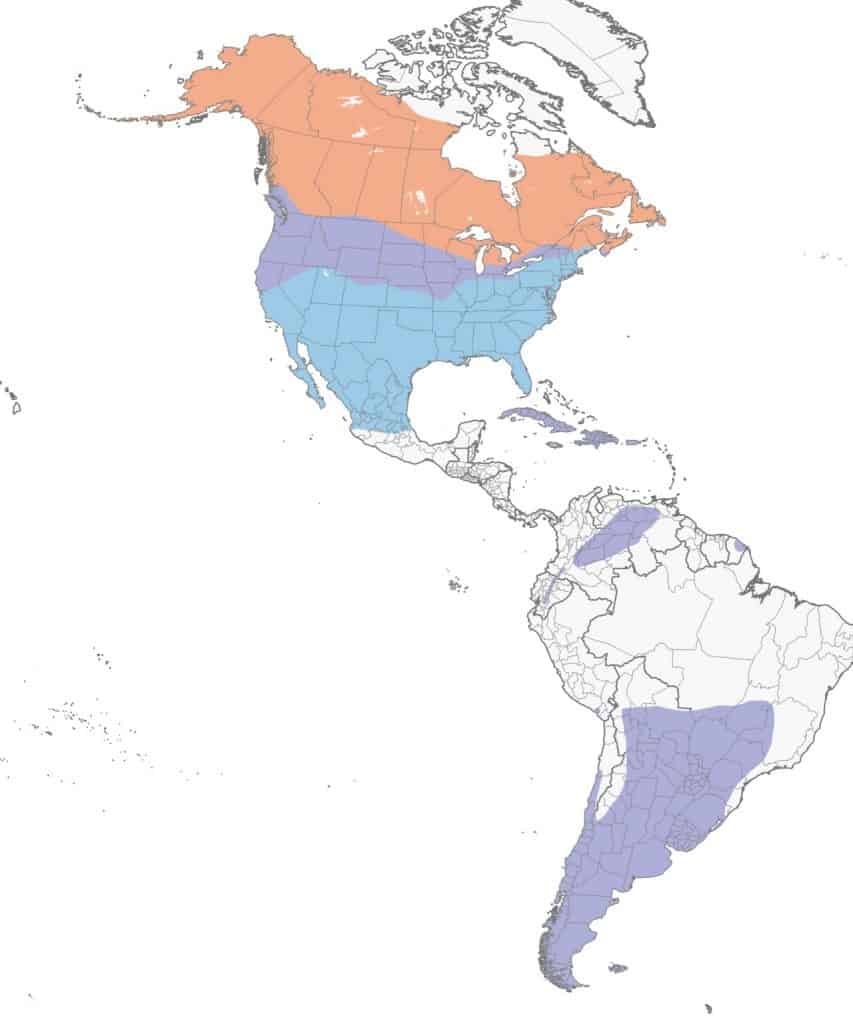
Snow Bunting
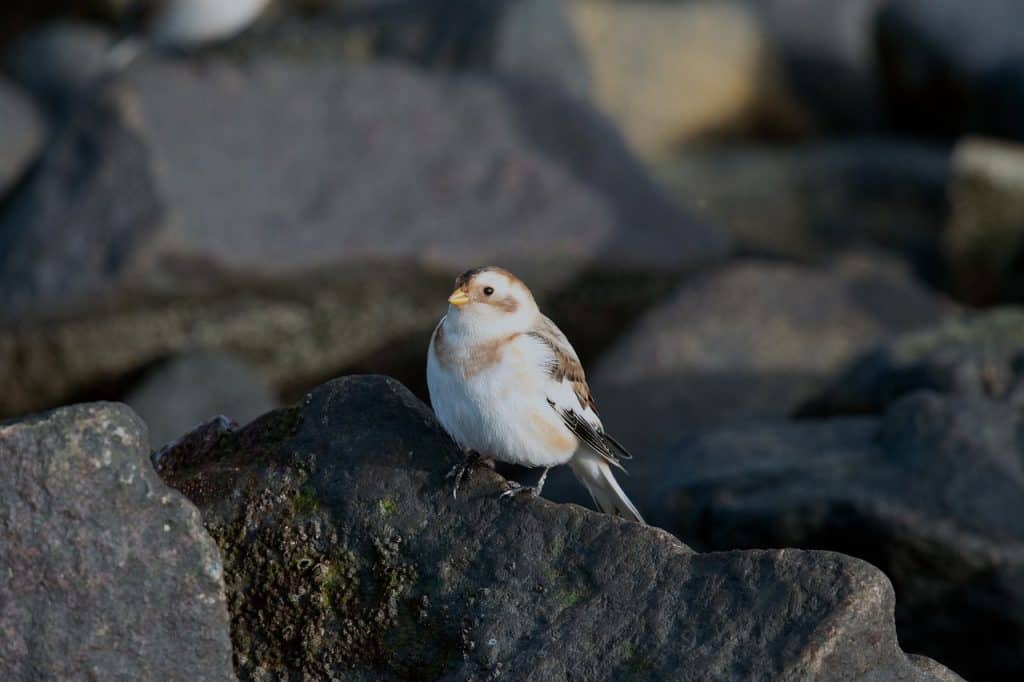
Appearance: Snow buntings are medium-sized birds about 6″ long. They’re all white with black wingtips and a black & white tail, and a short stubby bill. During the non-breeding season, they have rusty patches on the upper areas (crown, ear, and shoulder) as well as dark streaks along the back. Females are similar except their backs are brown and their heads are spotted brown. During the non-breeding season, the females have additional rusty spots on the ears and chest.
Diet: Grass, flower seeds, insects, and spiders.
Feeder food: They don’t visit feeders.
Habitat: Snow buntings prefer treeless regions in the cold, upper north region of North America. They prefer rocky areas, v=thick vegetation, and open fields.
Nesting: Snow buntings nest in rocky areas often in the crevice between or under rocks. They have 1 brood/season, 2-07 ivory white eggs with spots/brood, and incubation is for 10-15 days.
Migration: Snow buntings are migrators with a very minute year-round range in western Alaska.
Year-round range: Western coast of Alaska.
Breeding range: Alaska, Northern Canada provinces of the Yukon Territory, Northwest Territories, and Nunavut.
Winter range: US states in the northern half as well as Canada’s British Columbia, Alberta, Saskatchewan, Manitoba, southern Ontario, and southern Quebec.
Range Map
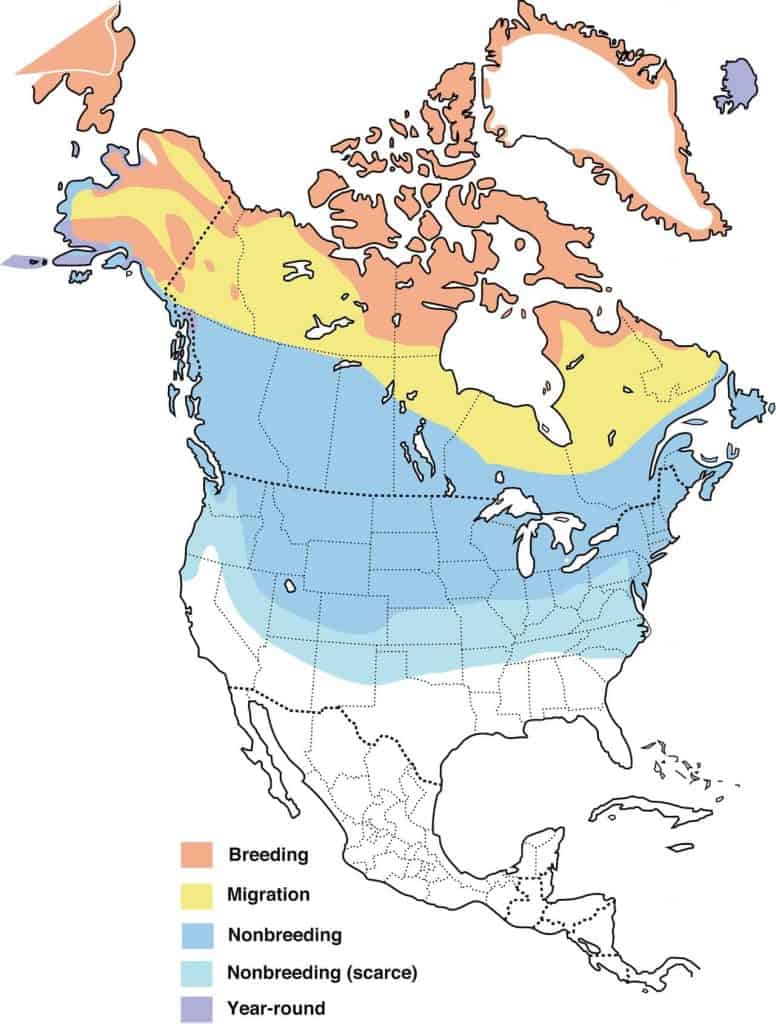
Snowy Owl
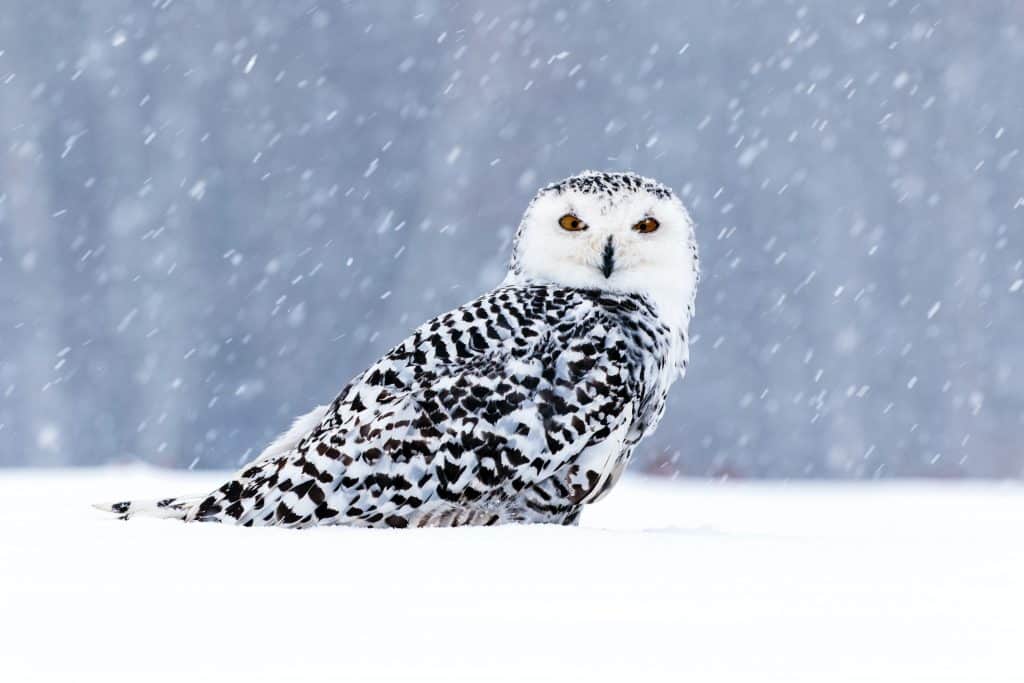
Appearance: The snowy owls are large owls about 20-30″ long with round heads, and thick feathering throughout their body. Although much of their body is white they also sport black and brown markings throughout. The males are much whiter than the females.
Diet: Snowy owls will eat a variety of food including lemmings, Arctic hares, mice, ducks, and seabirds. They’ll swallow the smaller prey whole.
Feeder food: They do not visit feeders.
Habitat: As their name implies, snowy owls prefer northern climates. They can be found near open areas with few trees. In Canada’s Northwest Territories and Greenland, where they also breed, they live in the tundra, but also inhabit grasslands and open fields. During winter they prefer to be near lake and ocean shorelines but are also seen in farmers’ fields.
Nesting: The nest is built on a shallow hollowed-out area on the ground. They have 1 brood/season, 3-11 eggs/brood, eggs are white and incubation lasts about 32 days. After 18-25 days the fledglings leave the nest.
Range Map
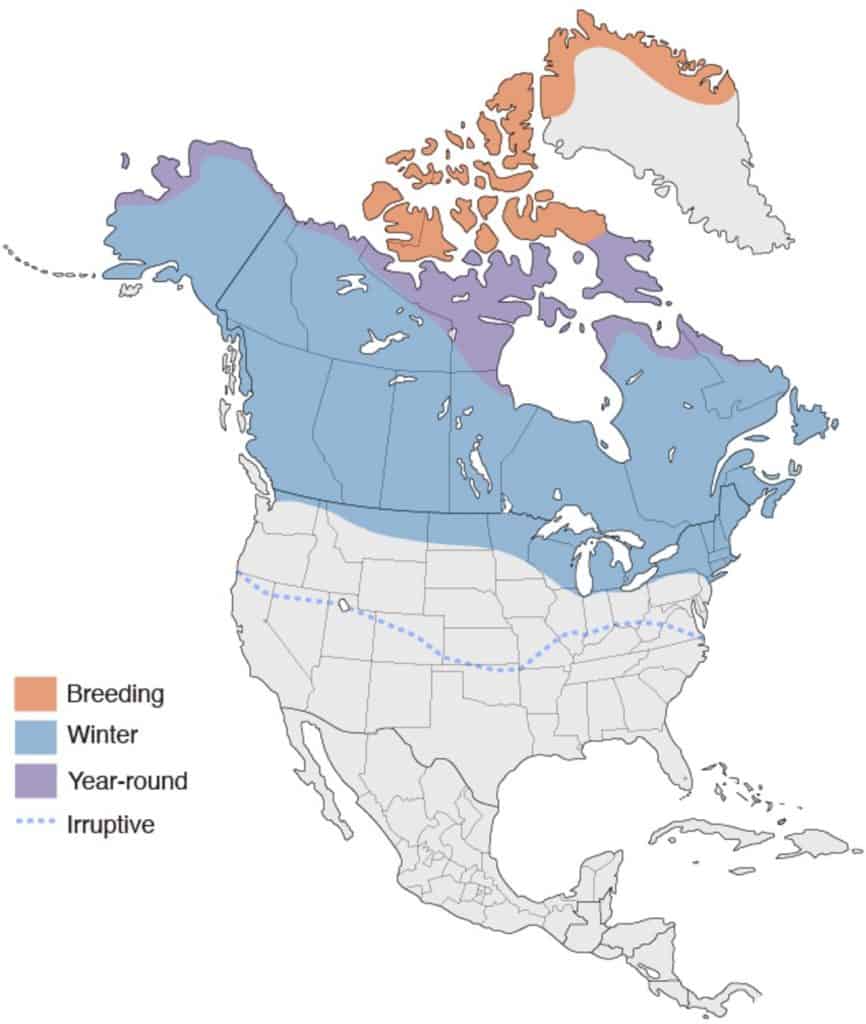
Steller’s Jay
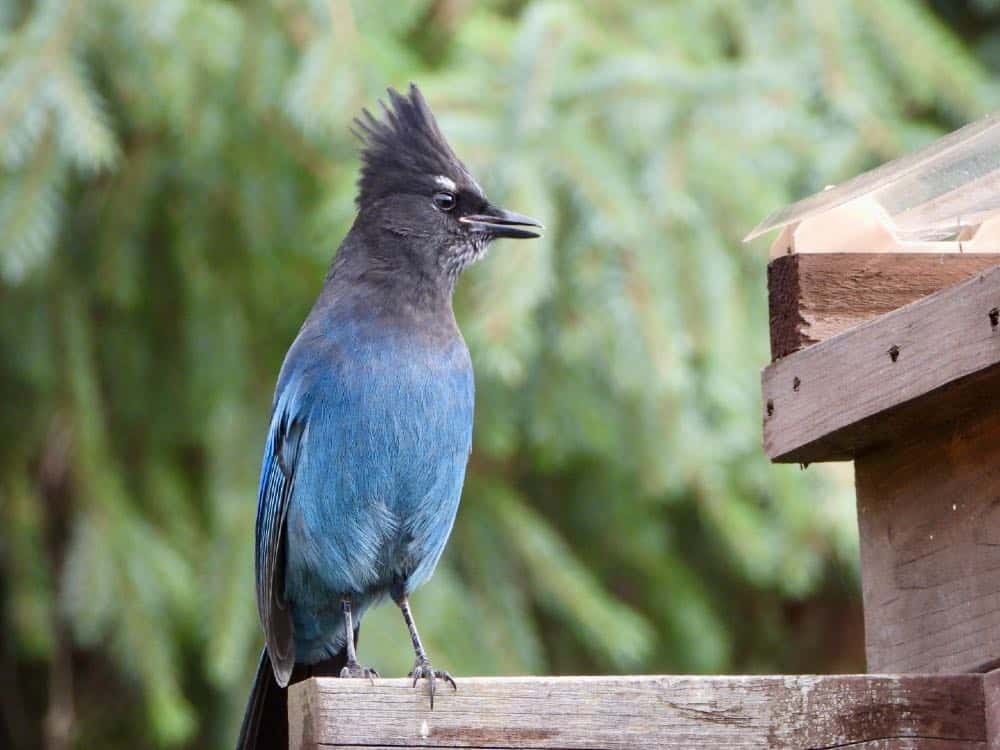
Appearance: Large bird 11.5″ long, dark blue body and crest, black head and crest with spots of blue. Females are similar.
Diet: Nuts, seeds, fruits, insects, other birds’ eggs and nestlings, and small animals.
Feeder Food: Whole peanuts, sunflower seeds, and suet.
Habitat: Typically found in forested areas of mixed tree types – coniferous and deciduous.
Nesting: Large open-cup nest of twigs, bark, and mud located high in a conifer tree. 1 brood/season, 4-5 eggs/brood, eggs are blue/green with dark brown/purple/olive spots, 16-18 days incubation, and the young fledge at about 16-18 days.
Range Map
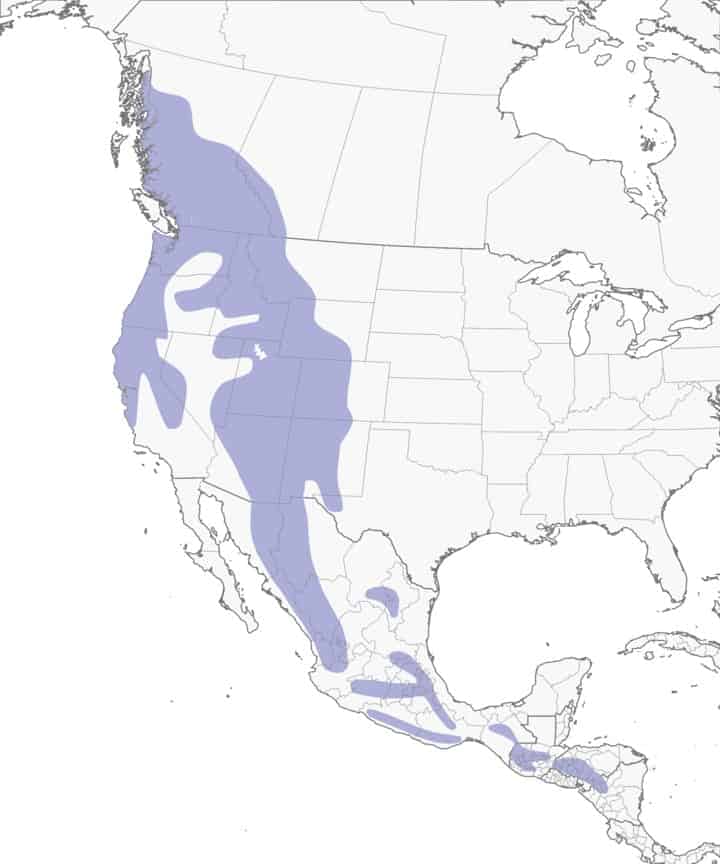
Swainson’s Thrush
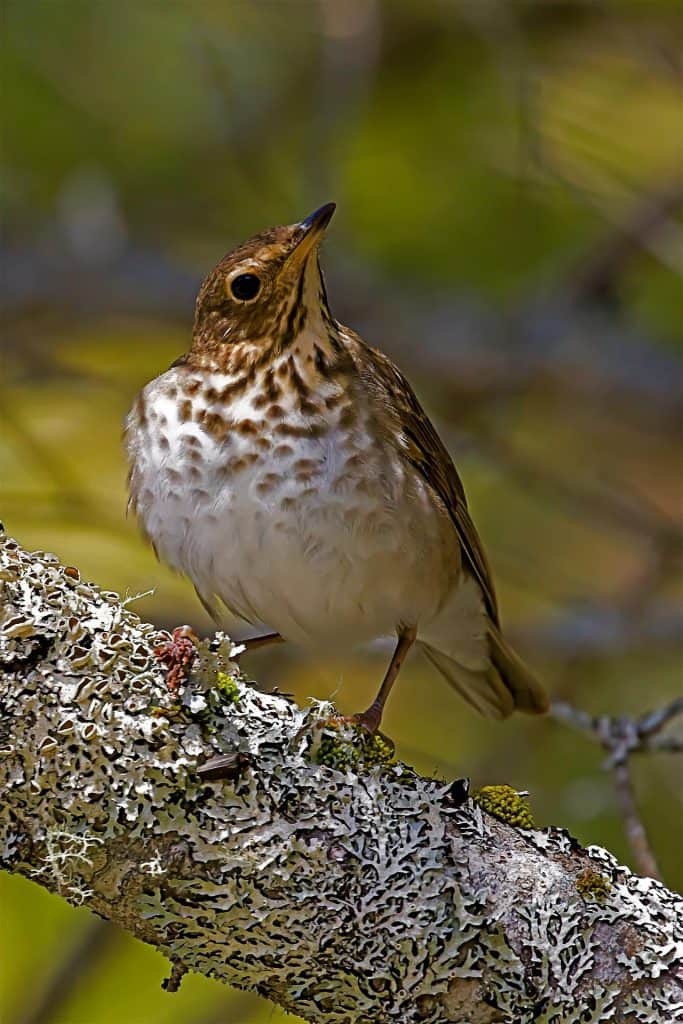
Appearance: Swainson’s thrush is about 7″ long. Their upper parts are brown and their underparts are white with spots. Their dark eyes have a buffy eye ring as well as flanks.
Diet: Insects and fruit.
Feeder food: Unlikely to visit a feeder.
Habitat: Forests.
Nesting:
- Nest: Swanson’s thrush builds a deep, compact cup-style nest and is placed in a small tree about 2-7′ up.
- Broods: They have 1 brood/season
- Clutch: 1-5 eggs/brood
- Egg color: Eggs are blue or greenish-blue with reddish-brown speckles
- Egg size: 0.8 – 1 inches by 0.6 – 0.7 inches
- Incubation: 10-14 days and fledglings leave the nest at about 14 days.
Migration: Swainson’s thrushes are migrators. They migrate north in the springtime to breed and raise their young. In the fall, they migrate far south into southern Mexico, Central America, and South America for the winter.
Breeding range: Alaska, west coasts of Washington, Oregon & California, Idaho, western Montana & Wyoming, northeast Nevada, central Utah, central Colorado, New England, and all Canadian provinces except Nunavut.
Winter range: Southern Mexico, Central America, and South America.
Range Map
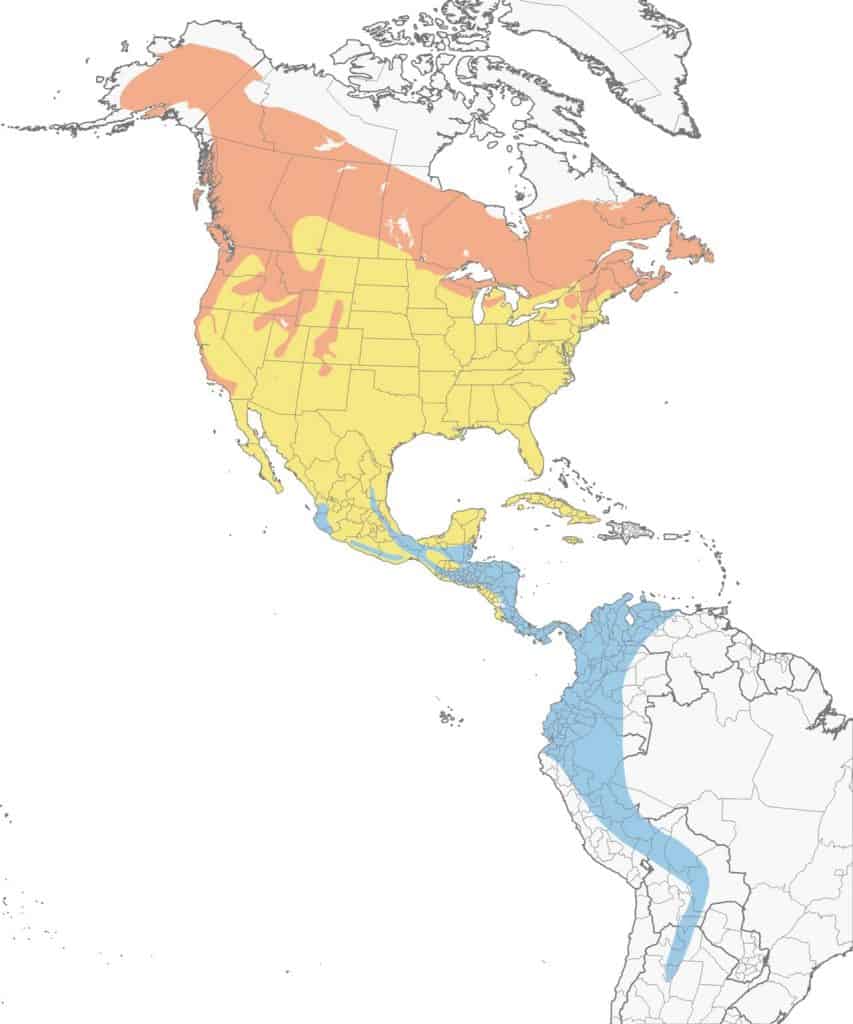
Swamp Sparrow
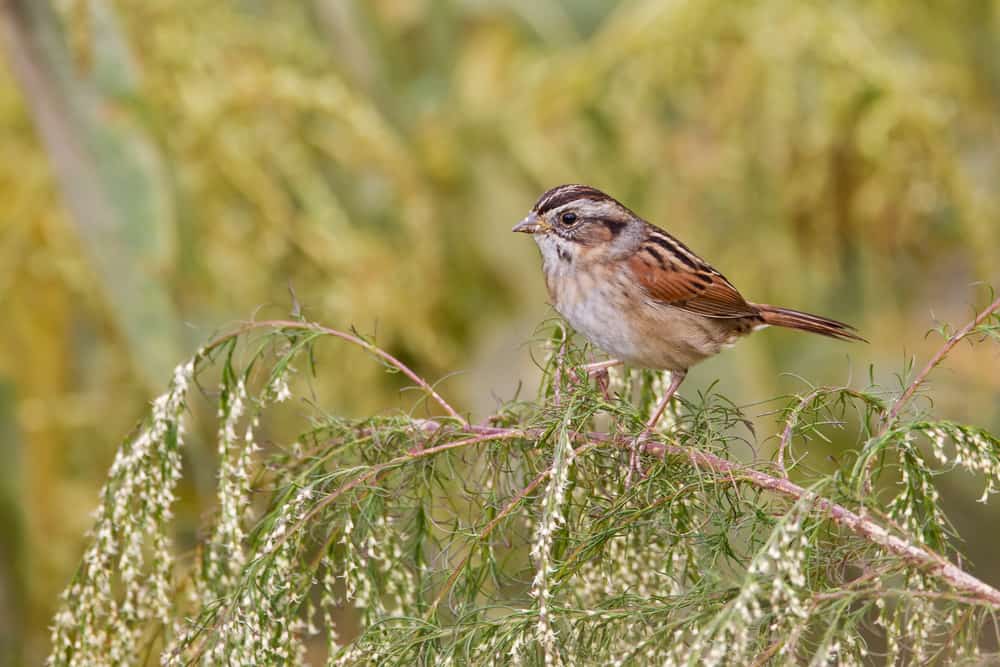
Appearance: Swamp sparrows are small birds about 5-6″ long. They sport an array of colors including blue/gray on its head with a rust-colored crown and a black stripe that connects to the cone-shaped bill. The tail is brown and points up – legs are relatively long for a sparrow. The female looks the same.
Diet: Seeds, fruits & invertebrates.
Feeder food: They don’t usually visit feeders.
Habitat: As their name implies they prefer to be near water as well as vegetation near water.
Nesting: Nest is built in a patch of grass or reeds less than 3′ off the ground. Using plant fibers, rootlets, grasses, sedges and plant down, the female constructs the cup-shaped nest which will end up being about 3″ tall x 4″ wide and 1.5″ deep. They have 1-2 broods/season, 1-6 eggs/brood, eggs are bluish/green with spots. Incubation lasts 12-14 days and fledglings leave the nest after 7-14 days.
Range Map
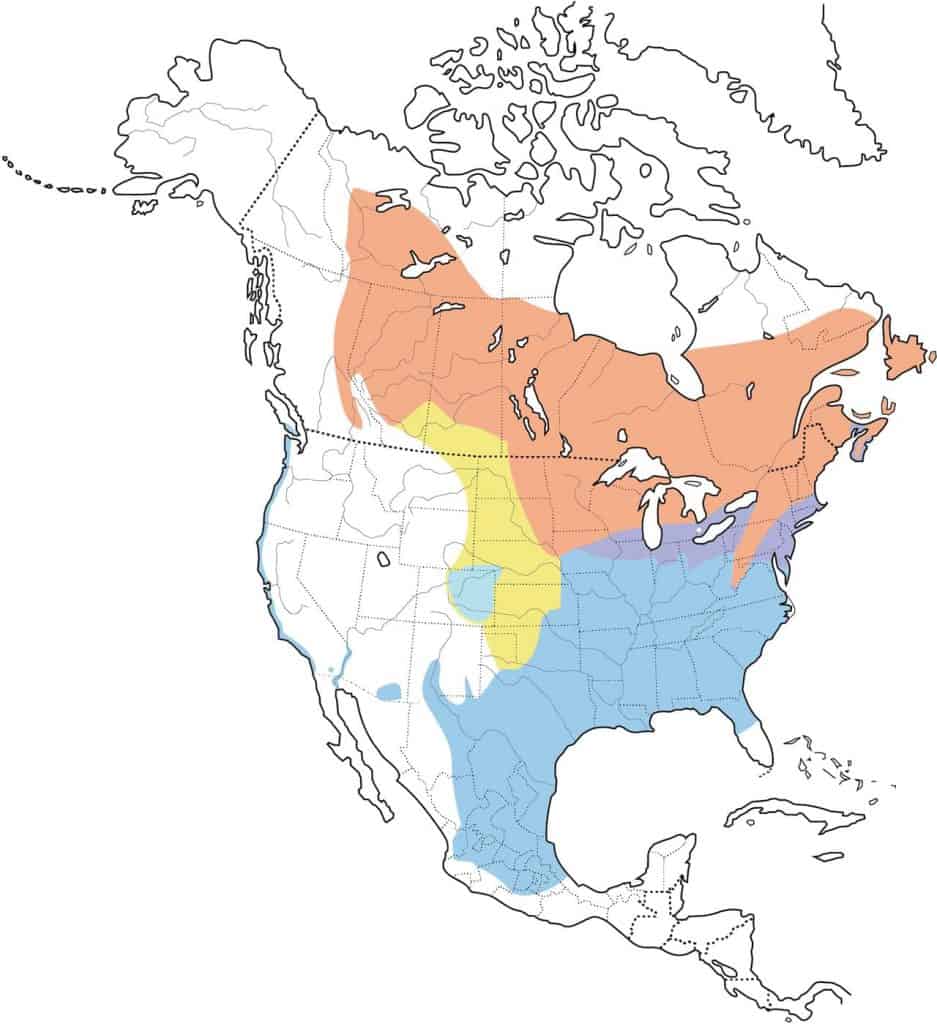
Townsend’s Warbler
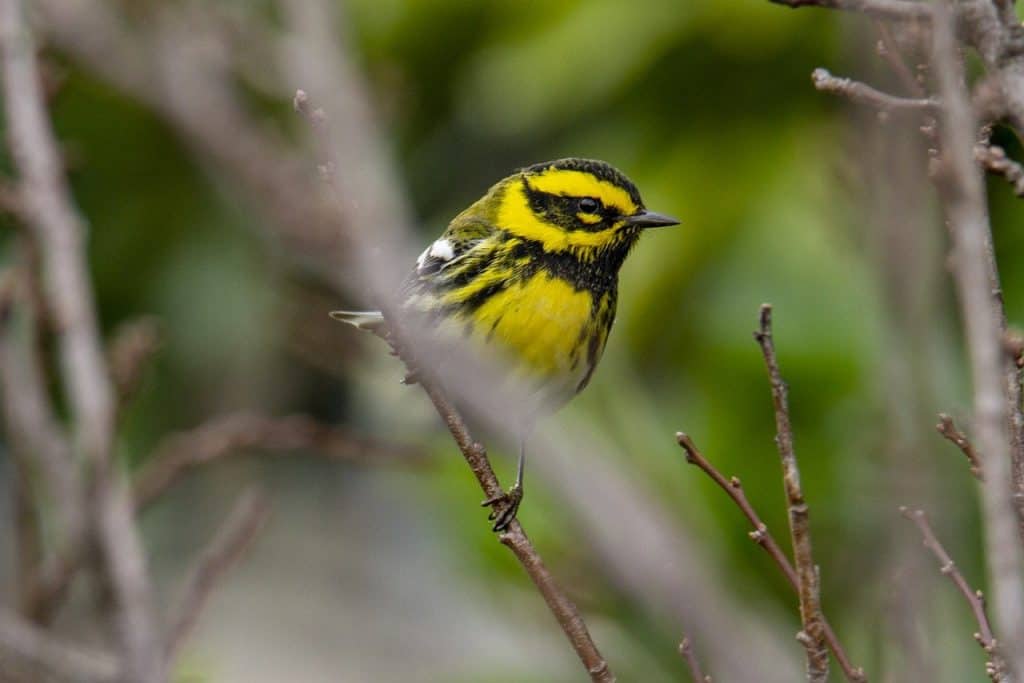
| Appearance | The Townsend’s warbler is a small bird about 5″ long with bright yellow on its face and chest and dark yellow on its back. Black on the crown, throat, and circle around and under each eye. They also have black wings and streaks of black on the white belly and chest. Females are the same except for more subtle markings. |
| Diet | Insects and their larvae. Occasionally spiders and seeds. |
| Feeder Food | Mealworms and suet. |
| Habitat | Wooded areas with tall, mature coniferous, and deciduous trees. |
| Nesting | They build a cup-shaped and place it in conifers about 3′ up. They have 1 brood/season, 3-7 eggs/brood, and incubate for 11-14 days. the eggs are with brown specks. |
Range Map
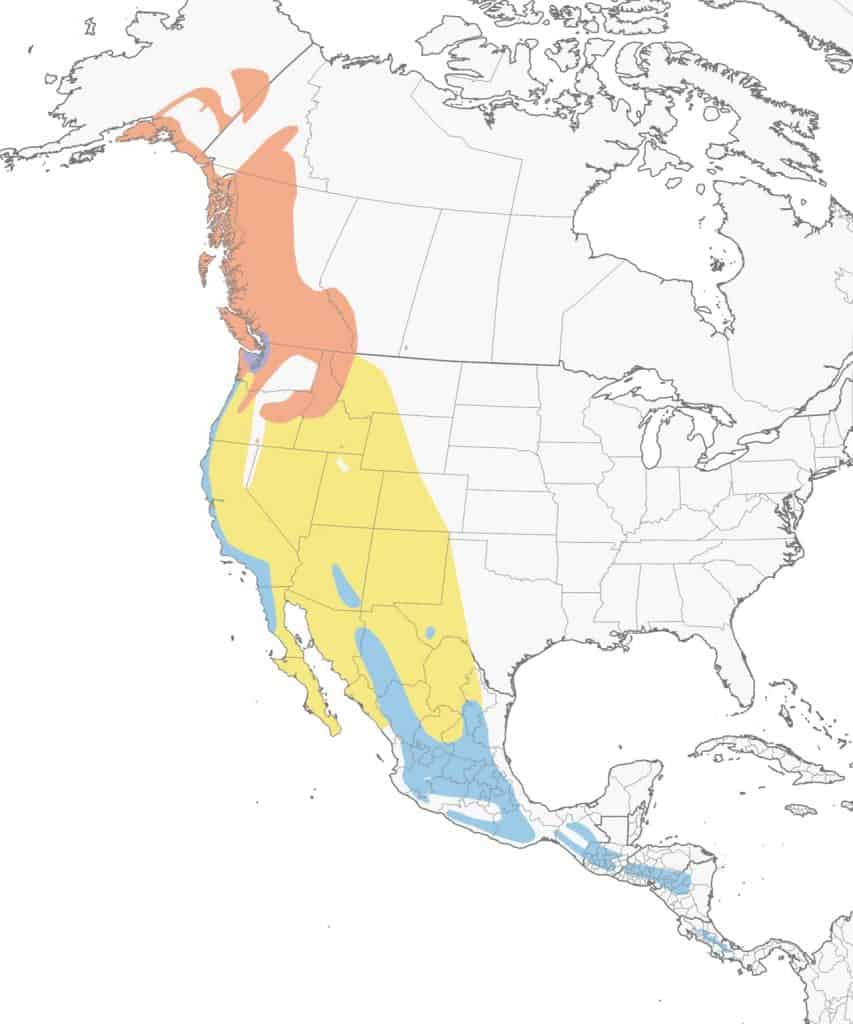
Tree Swallow
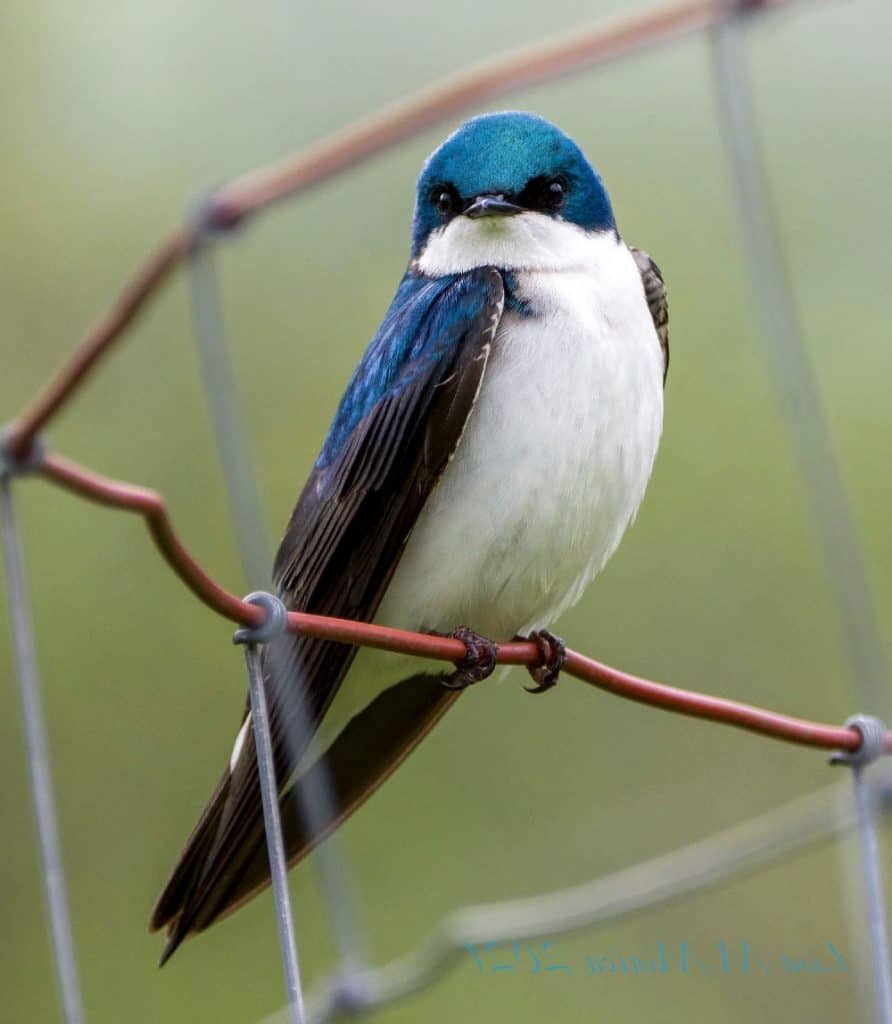
Appearance: 5-6″ long, dark metallic blue to blue/green with a white belly, notched tail, and pointed wing tips. Females have the same coloring but are a bit duller.
Diet: Insects and small fruits.
Feeder Food: Unlikely to visit a feeder.
Habitat: Open areas such as fields, large lawns, and marshes.
Nesting: Tree swallows are cavity nesters. They often take up residence in an old dead tree or existing hole left behind by other cavity nesters. They have 2-8 eggs, eggs are light pink then slowly fade to white. Incubation is 14-15 days and young fledge at about 18-22 days.
Range Map
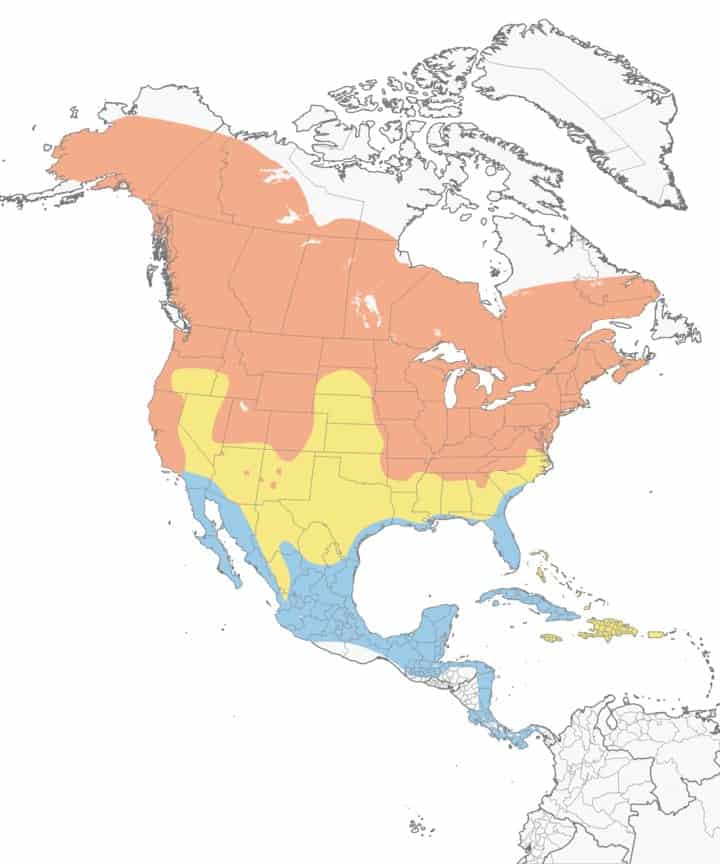
Turkey Vulture
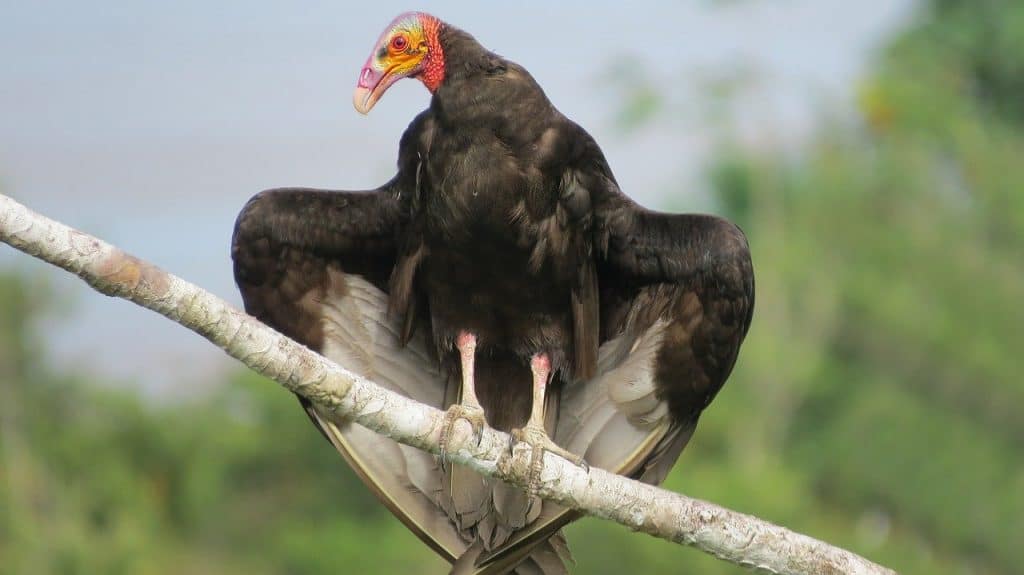
Appearance: The turkey vulture is a large bird about 27″ long, black/brown, with a red head of bare skin and pink legs.
Diet: Animal carcasses.
Feeder food: They don’t visit feeders.
Habitat: Wooded areas with open areas for foraging.
Nesting: They nest on the ground in a rocky crevice, cliff, or hollowed-out log. They have 1 brood/season, 1-3 eggs/brood that are creamy-white with gray/blue or green spots, and incubate for 38-41 days. Fledglings leave the nest 75-80 days after hatching.
Migration: While most turkey vultures migrate north in spring for breeding and raise young, many remain in their year-round range.
Year-round range: Western California, southern Arizona, southern Texas, southern Missouri, US states east and south of Missouri, as well as Mexico, Central American, and South America.
Breeding range: US states outside of the year-round range (above) as well as southern Canadian provinces of British Columbia, Alberta, Saskatchewan, Manitoba, and Ontario.
Range Map
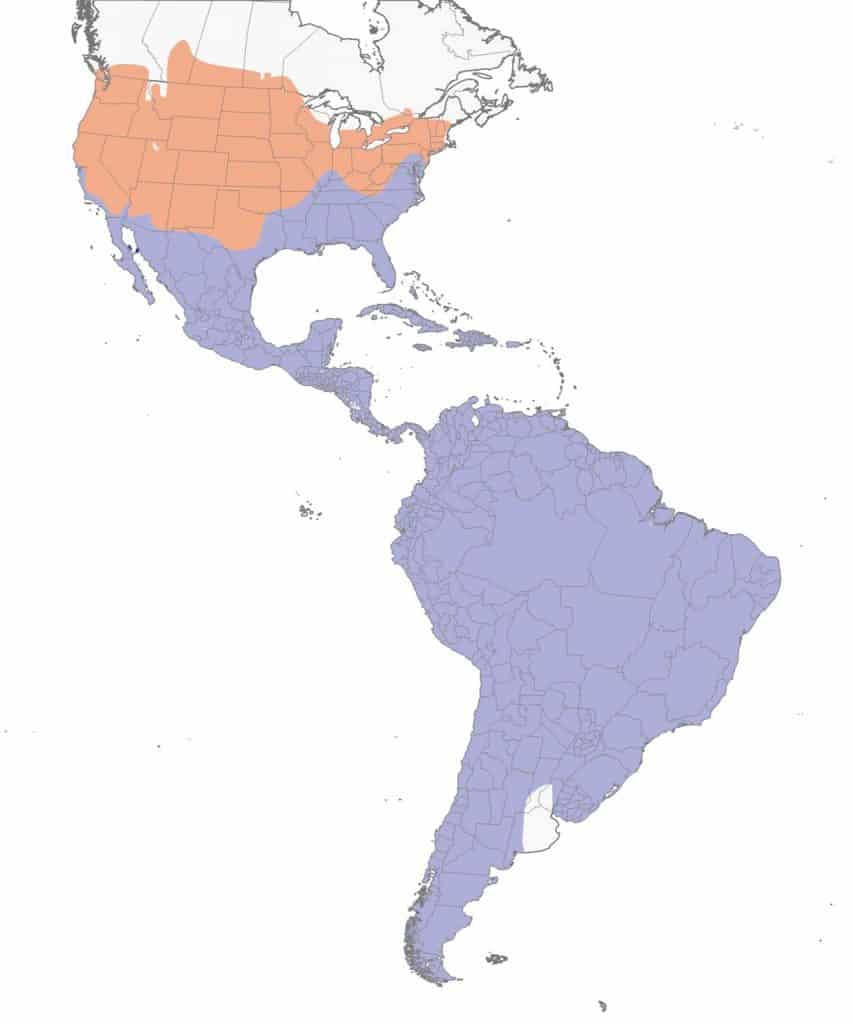
Western Bluebird
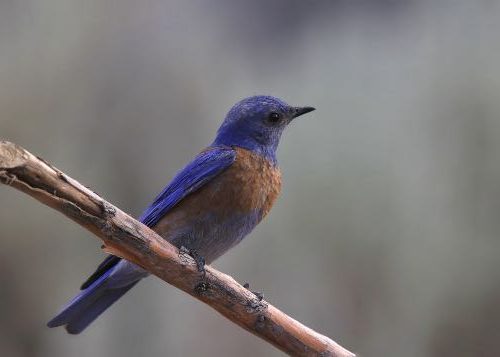
Appearance: Small bird 7″ long, deep blue underparts, orange-chestnut back and breast. Female gray/blue, light blue wings and tail, and pale chestnut breast.
Diet: Insects, fruits & berries.
Feeder Food: Mealworms
Habitat: Open woodlands especially those with pines and oaks, orchards, and farmland with some trees.
Nesting:
Nest: Cavity nesters – old woodpecker hold or manmade nesting box.
Brood: 2 broods/season
Clutch: 4-5 eggs/brood
Egg color: Pale blue without blemishes, although sometimes are white
Egg size: Length: 0.8-2.4″ x Width: .8″
Incubation: 12-18 days and young fledge at about 20 days.
Range Map

Western Tanager
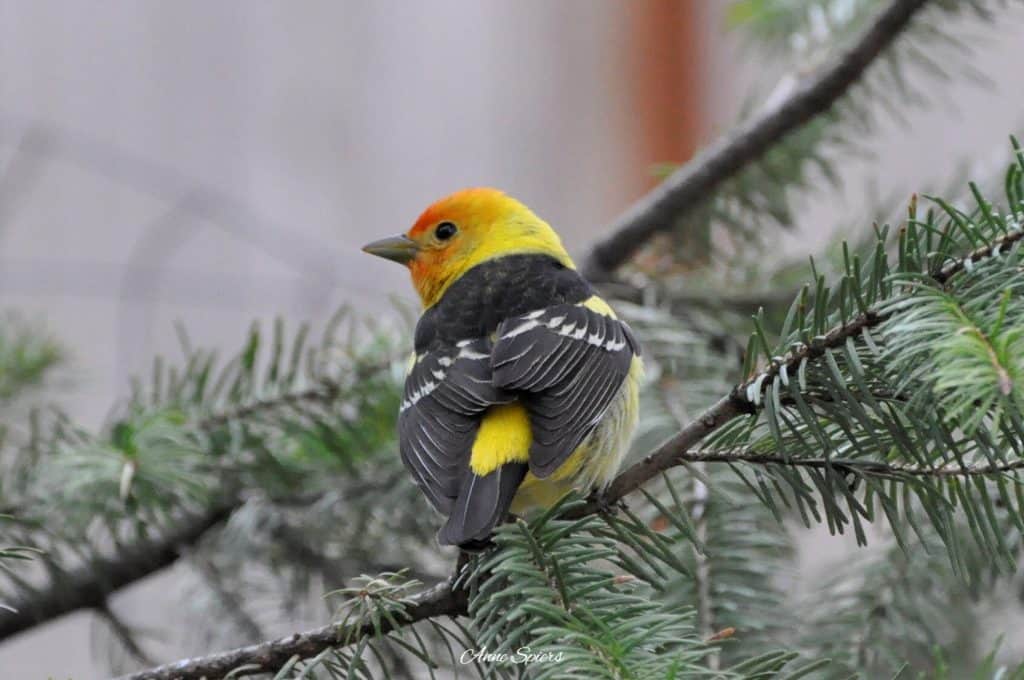
Appearance: The western tanager is a medium-sized bird about 7 1/4″ long with a bright red-orange head, black-and-yellow wings, and bright yellow chest. The female does not have a red-orange head. Instead, she’s an olive-yellow color throughout.
Diet: Insects and occasionally fruits and berries.
Feeder food: Western tanagers are unlikely feeder visitors but may be enticed with fruit or grape jelly.
Habitat: Open woodlands, especially when pine, oak, and conifers are present. Higher elevations are preferred.
Nesting: The cup-shaped nest is placed high in a conifer tree, up to 60′ up. They have 4 eggs/brood and incubate for about 13-14 days.
Migration: Western tanagers are migrators. In the spring they head north into Canada’s Yukon Territory, British Columbia, Alberta, and Saskatchewan as well as the U.S. states Washington, Idaho, Montana, Oregon, Wyoming, California, Nevada, Utah, Colorado, Arizona, and New Mexico. In the fall, they head back south to winter in Mexico.
Range Map
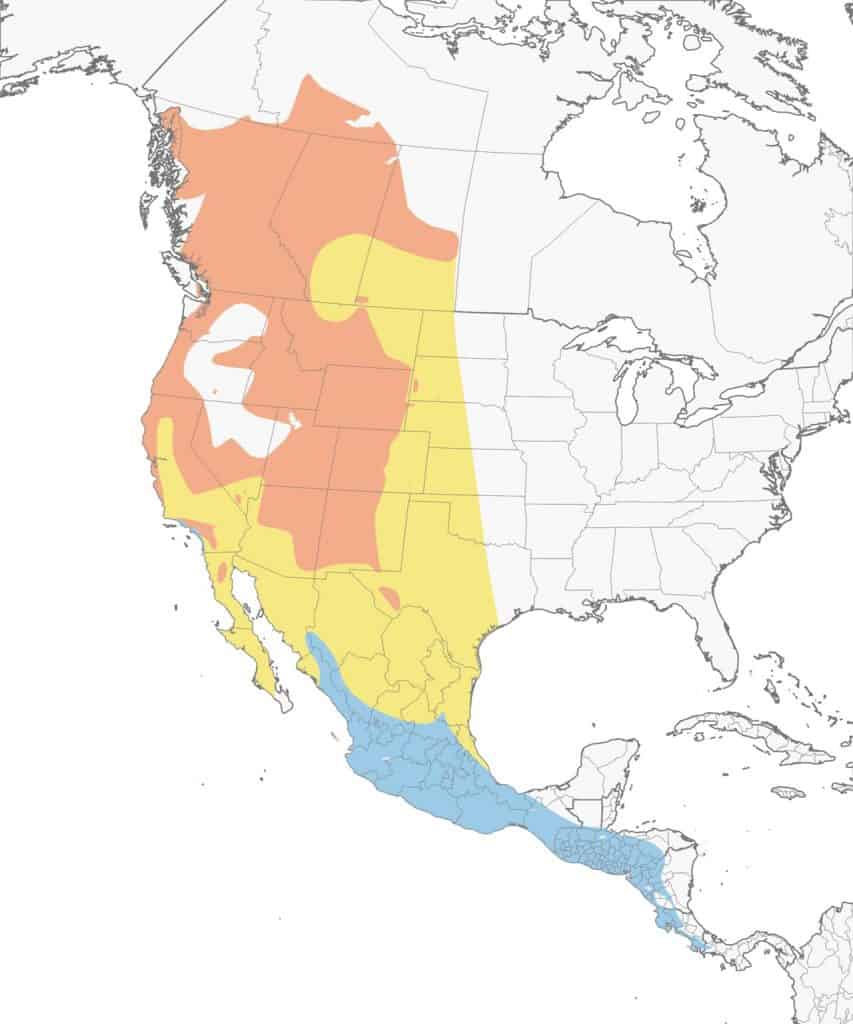
White-Breasted Nuthatch
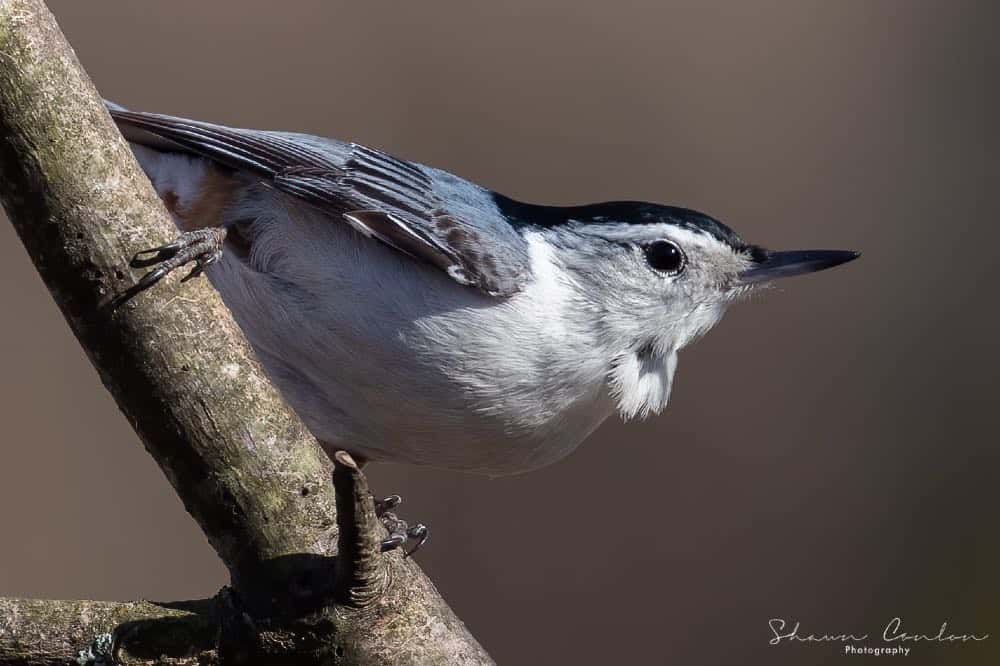
Appearance: 5-6″ long, gray/blue back, white head with a black cap, chestnut under the tail, and a long thin pick-like beak. Females look similar except their cap and neck are gray. Usually spotted climbing upside-down on a deciduous tree foraging for insects beneath the bark.
Diet: Insects & seeds.
Feeder food: Suet, sunflower seed, shelled peanuts.
Habitat: Near mature deciduous and mixed forests; wooded suburban areas such as orchards, parks, and backyards.
Nesting: White-breasted nuthatches are cavity nesters. They have 1 brood/season, 5-9 eggs/brood, eggs are white with brown markings, incubation is 11-12 days and young fledge at about 13-14 days.
Migration: White-breasted nuthatches are not migrators. They remain in their year-round range all seasons of the year. That said, a small part of the population may migrate to a strip in the southcentral US for the winter.
Year-round range: Every US state, Canada’s southern provinces, and Mexico.
Range Map
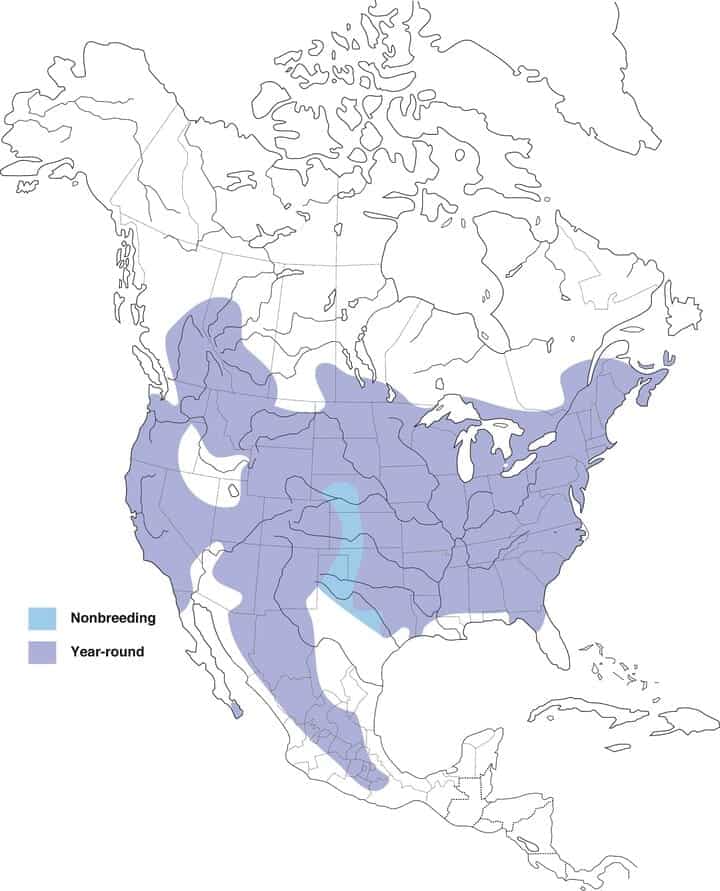
White-Winged Crossbill
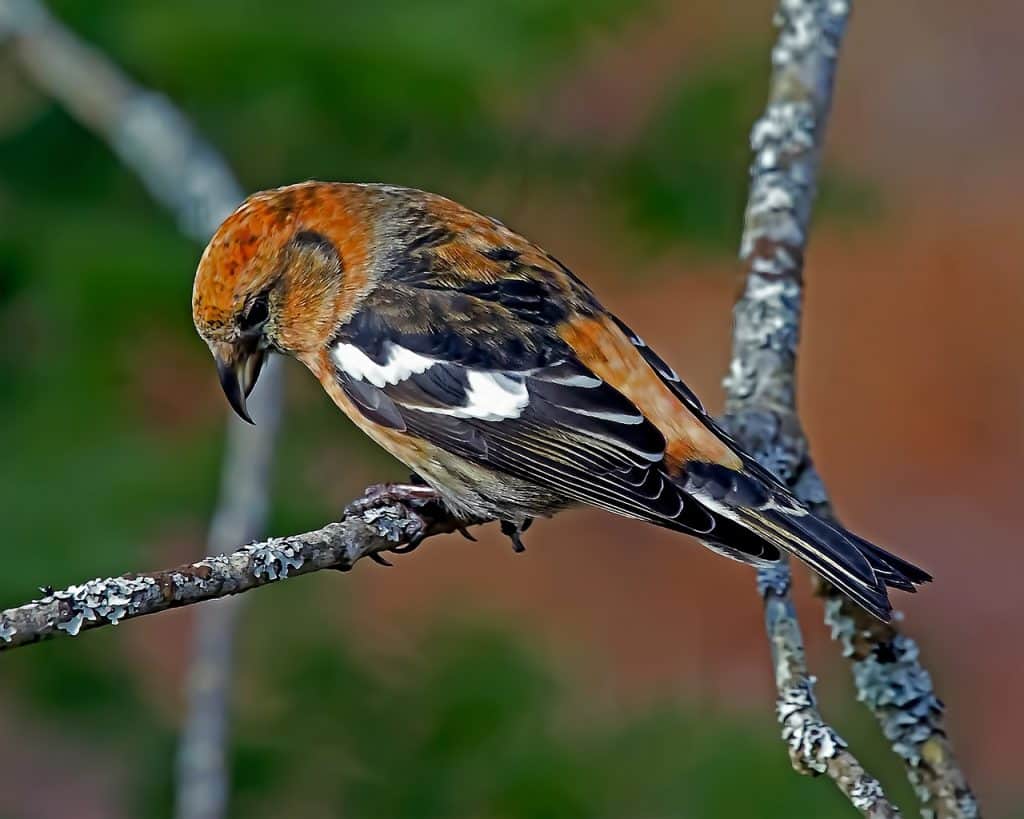
Appearance: The white-winged crossbill is a medium-sized bird about 6″ long with a rosy pink color, black wings & tail, and two white wingbars. The females are similar but they are more yellow rather than rosy-pink. Immature white-winged crossbills are browner and streaked underneath.
Diet: Seeds, especially from cones of spruce and tamarack trees (their crossbill is uniquely designed to pry open the cones) but they’ll also eat seeds from other trees including pines, hemlocks, cedar, birch, etc.
Feeder food: Unlikely to visit a feeder.
Habitat: White-winged crossbills prefer northern regions thickly forested with spruce, hemlocks, and tamarack trees.
Nesting: White-winged crossbills build nests made of conifer twits and barks of other trees, then line them with softer material such as rootlets, moss, lichen, and hair. Nests are placed in spruce trees around 10-15′ up near the trunk for added protection. They have 1 brood/year, 2-4 whitish to bluish/green eggs/brood, and incubation lasts14-16 days.
Migration: White-winged crossbills are not true migrators. While they remain year-round in their northern range that encompasses Alaska, northern Washington, Idaho, Montana, Minnesota, Wisconsin, Michigan & New England, and all of Canada, they will often winter further south (in the US) in search of cone seeds.
Year-round range: Alaska, northern Washington, Idaho, Montana, Minnesota, Wisconsin, Michigan & New England, and all Canadian provinces.
Winter range: The year-round range as well as northern Montana, North Dakota, south into Minnesota, Wisconsin, Michigan, and New England.
Range Map
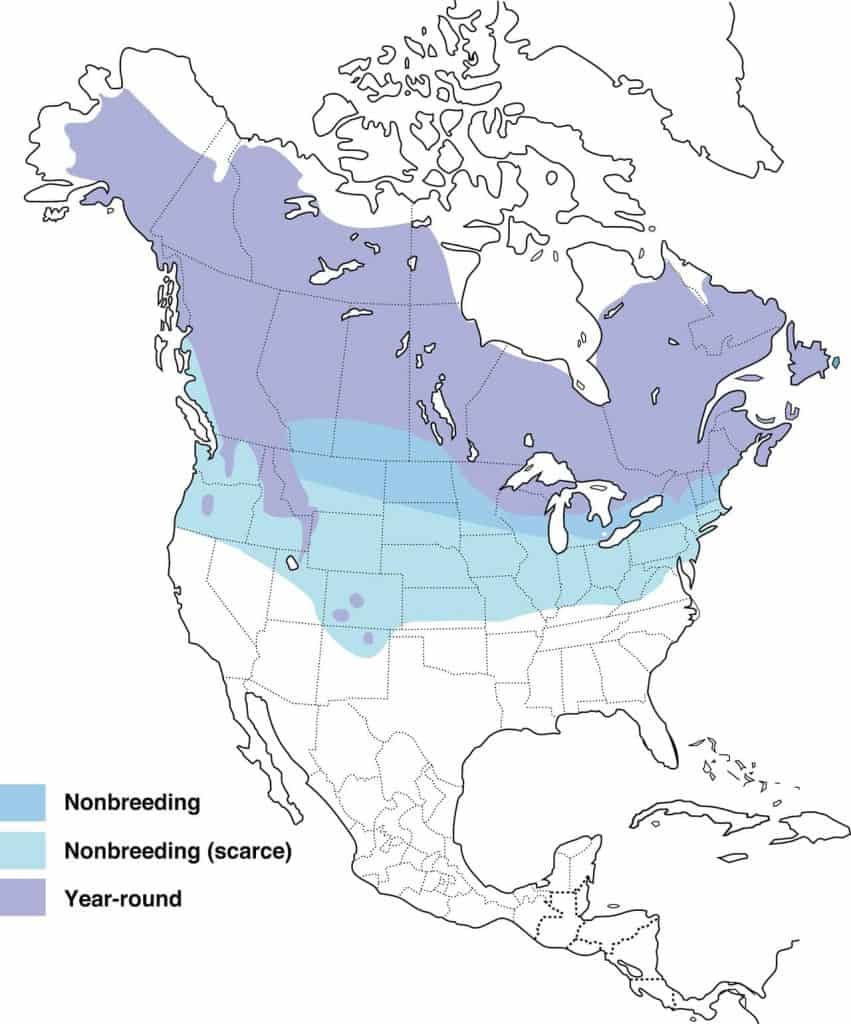
Wild Turkey
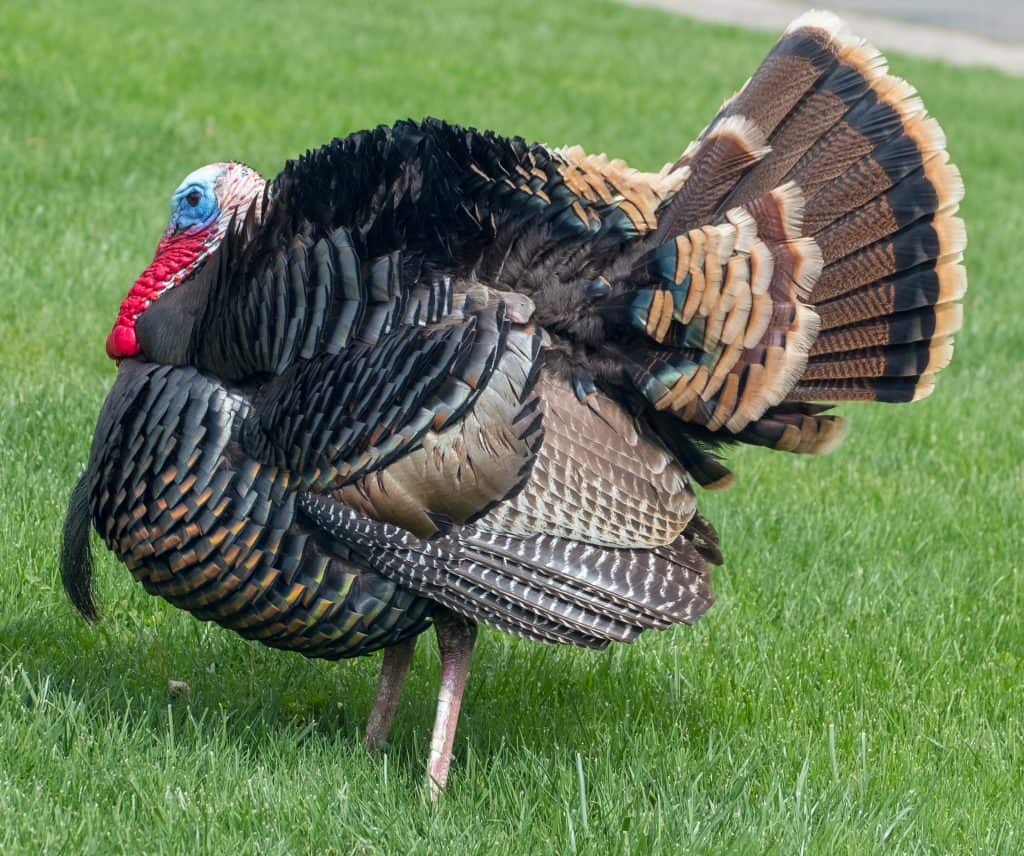
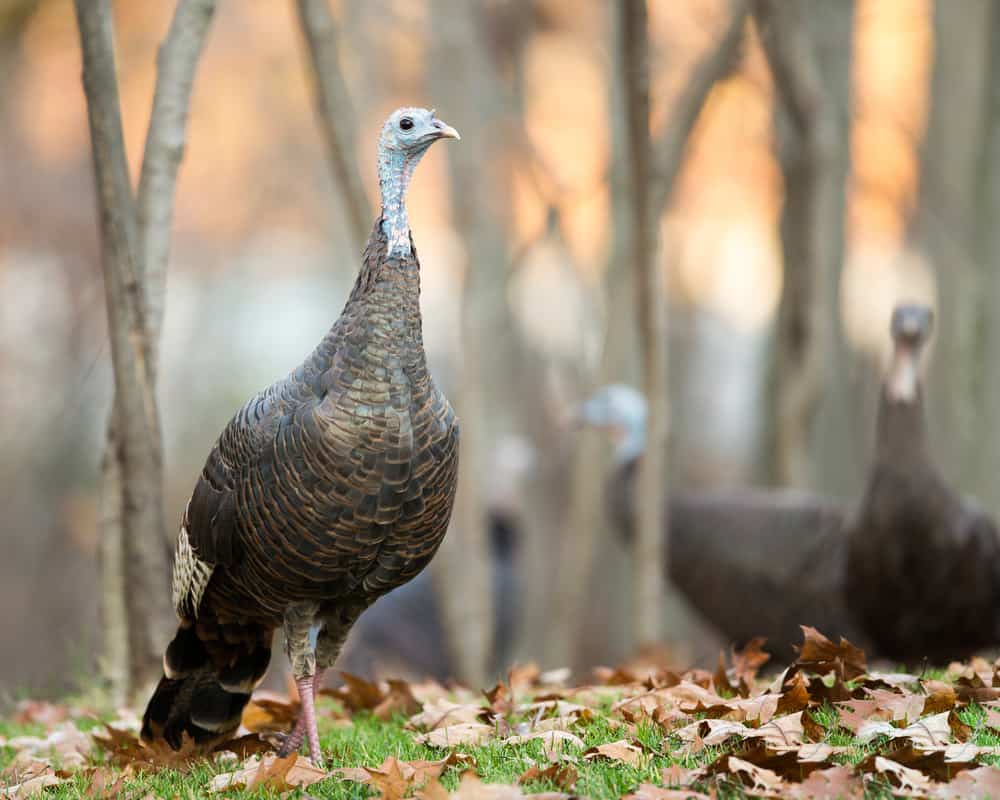
Appearance: Wild turkeys are enormous birds about 45″ long with long necks, large prominent red wattles, snoods (hanging skin from the neck), and a bronze-greenish iridescence to most of their feathers. The feathers also give the appearance of a variety of textures. Their wings are dark, with white bars and a fanned-out tail with rusty or white tips. Their head and neck show their skin with colors of red, blue, and gray. The red neck is unmistakable. The females are similar but lighter in color, they don’t fan their tail feathers, have subtle-looking wattle and snood, and don’t strut like the males.
Diet: Wild turkeys are ground foragers consuming seeds, nuts (acorns, beech nuts, pecans, hickory nuts), and berries.
Feeder food: Wild turkeys do not come to feeders.
Habitat: Wild turkeys are widespread throughout the US, southernmost parts of Canada, and Mexico. They prefer open forested areas, especially those with nut-producing trees. In the southwest, they can be found in open grassy savannahs.
Nesting: Wild turkeys are ground nesters. The female creates a shallow depression in the ground and fills it with leaves. The completed nest can be as large as 10″ x 12″. They have 1 brood/season, 4-17 eggs, eggs are 2-3″ long x 1.5-2″ wide. They’re a light yellow/tan color with red/brown or pink speckles and incubation lasts about 25-31 days.
Migration: Wild turkeys are not migrators. They remain in their year-round range every season of the year.
Year-round range: Every US state, Mexico, the southern portions of Canada’s British Columbia, Manitoba, Ontario, and Quebec.
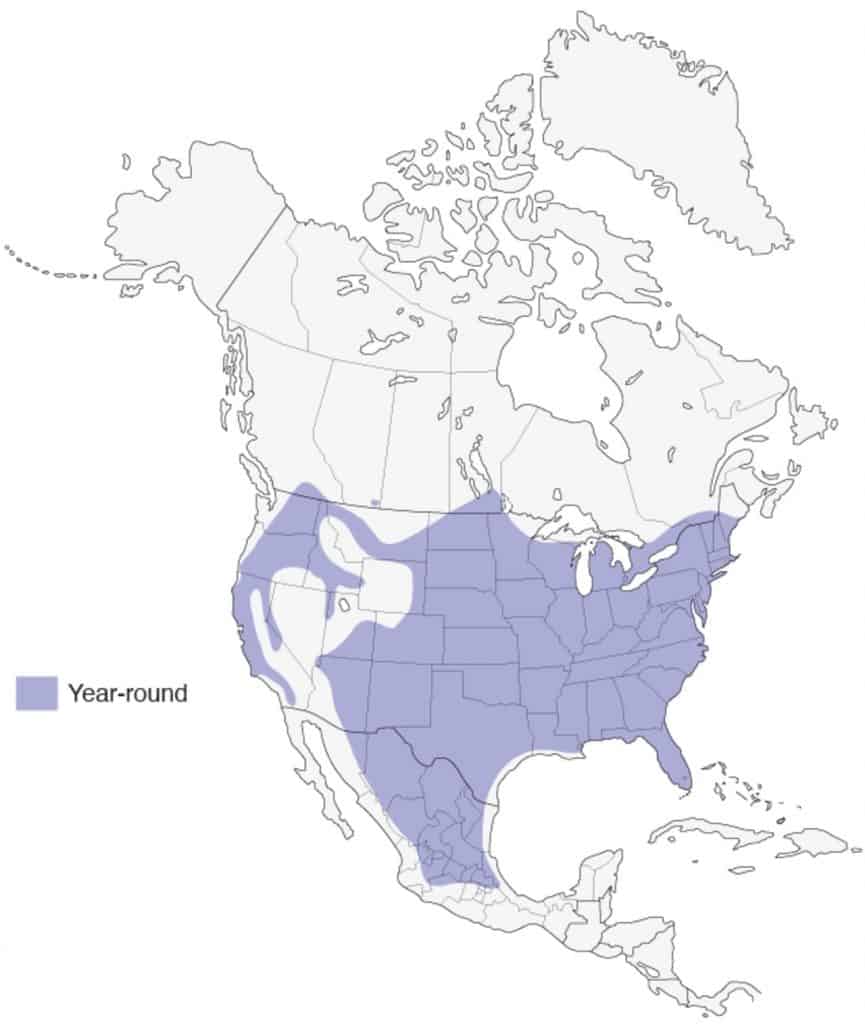
Wilson’s Warbler
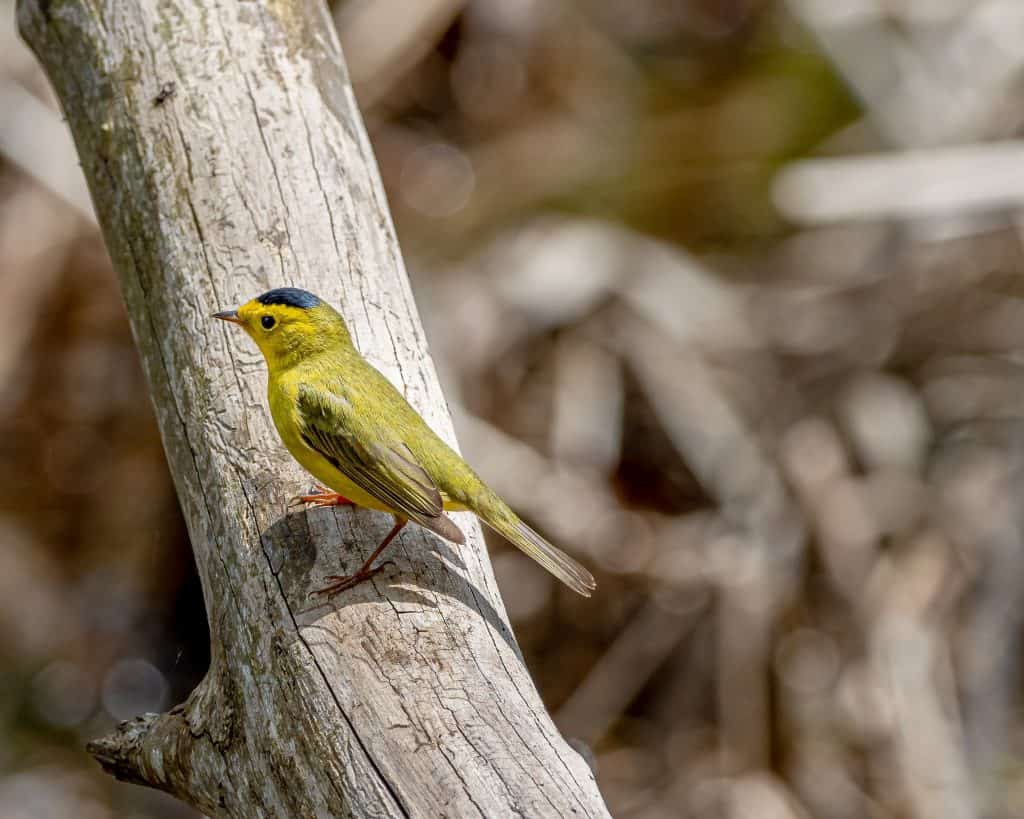
Appearance: Wilson’s warbler is a very small bird about 4-5″ long. They’re bright yellow with subdued tones of the olive-yellow outside of the face, a black cap (looks a bit like a toupe), and black wings with white stripes. Their bills are short and pointy, eyes dark black.
The female is the same except the cap is light charcoal.
Diet: Insects, especially larval insects, spiders, and the sugary liquid from scale insects (tiny insects that feed on plants).
Feeder food: Unlikely to visit a feeder.
Habitat: Forested edges, shrubby thickets, and often young conifer trees.
Nesting: Wilson’s warblers place their 3-4″ nest on the ground. Sometimes nests are in shrubs in which case they are a bit bigger. They have 1-2 broods/season and 2-7 eggs/brood that are white/ivory with reddish/brown specks. Incubation is for 10-13 days and juveniles leave the nest at about 9-11 days.
Migration: Wilson’s warblers are migrators. In the spring they migrate north to breed and raise their young. Then in the fall, they migrate back south for the winter.
Breeding range: Alaska, Washington, Oregon, Idaho, western Montana, northern and the coast of California, as well as irregular patches in Wyoming, Utah, Colorado, New England, and Canada’s provinces (except Nunavut).
Winter range: Southeast Texas, southern Louisiana, and Mexico.
Range Map
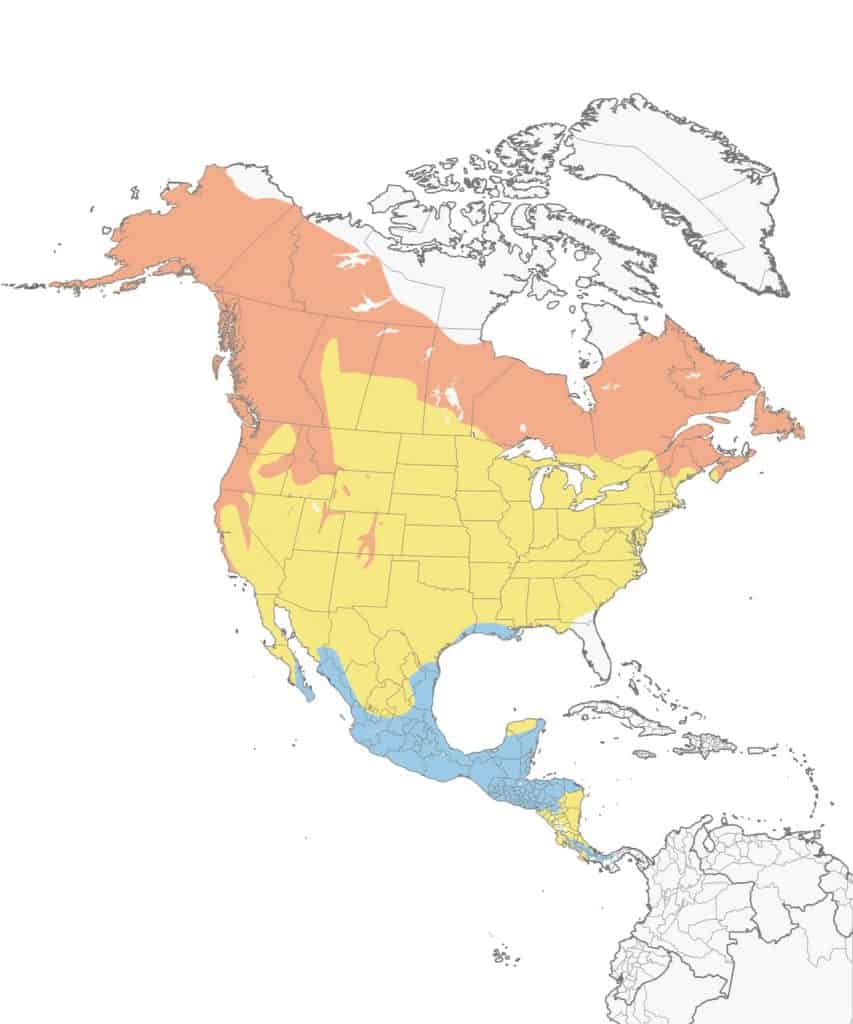
Wood Duck
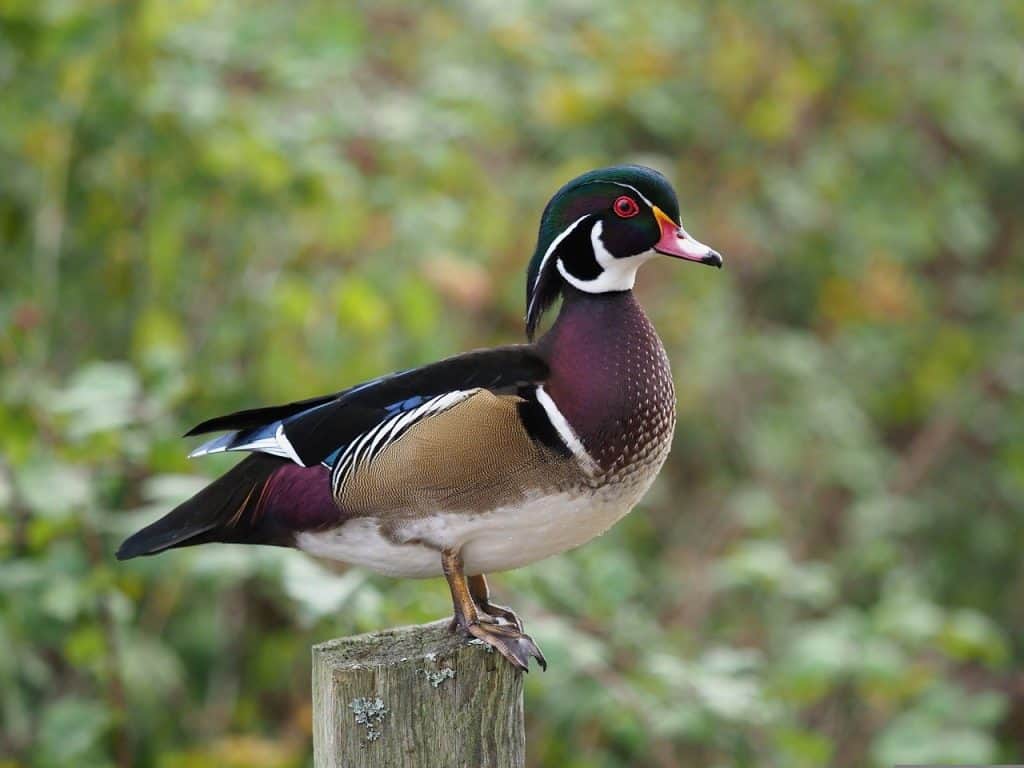
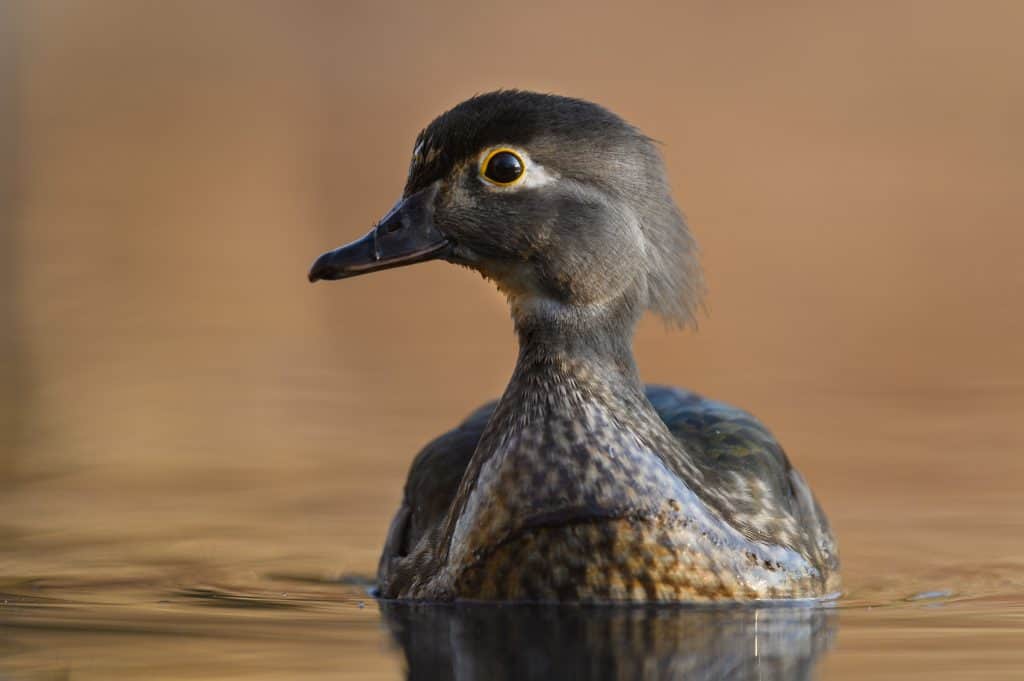
Appearance: The wood duck is a large bird about 19-22″ long and the male sports an array of colors. The male’s head and crest are metallic purplish-green, the sides of the face are black, a white stripe runs along the neck and a smaller one goes up each cheek. Their chest and the rump are dark red, and the sides are olive-yellow with black & white stripes on the edges, the belly is white, tail and back are black. The eyes are red, bill white with red on each side. The top of the bird’s head and crest are metallic purplish-green. The sides of the face are black, and a white stripe runs along the neck. A small white stripe also extends up each cheek. The chest and the rump are dark red, and the sides are a drab yellow with black and white stripes at the edges. The wood duck’s belly is white, its tail and back are black, and its wings are black and blue. The female looks vastly different. She is gray-brown with a white-speckled breast
Diet: The wood duck’s diet varies widely. They prefer water plants, seeds, fruits, and insects but will also eat nuts and grains.
Feeder food: They don’t visit feeders.
Habitat: Wet areas including swamps, marshes, streams & creeks as well as small lakes.
Nesting: Wood ducks are cavity nesters and will gladly move into your manmade nesting box is you put one up. When using a tree cavity, they opt for very large trees – 1-2′ in diameter. The cavity is anywhere from 2-60 feet in the air. They have 1-2 broods/season and 6-16 eggs/brood. Eggs are shiny cream white to light tan. Incubation is from 28-37 days and fledglings leave the nest at about 56-70 days.
Range Map
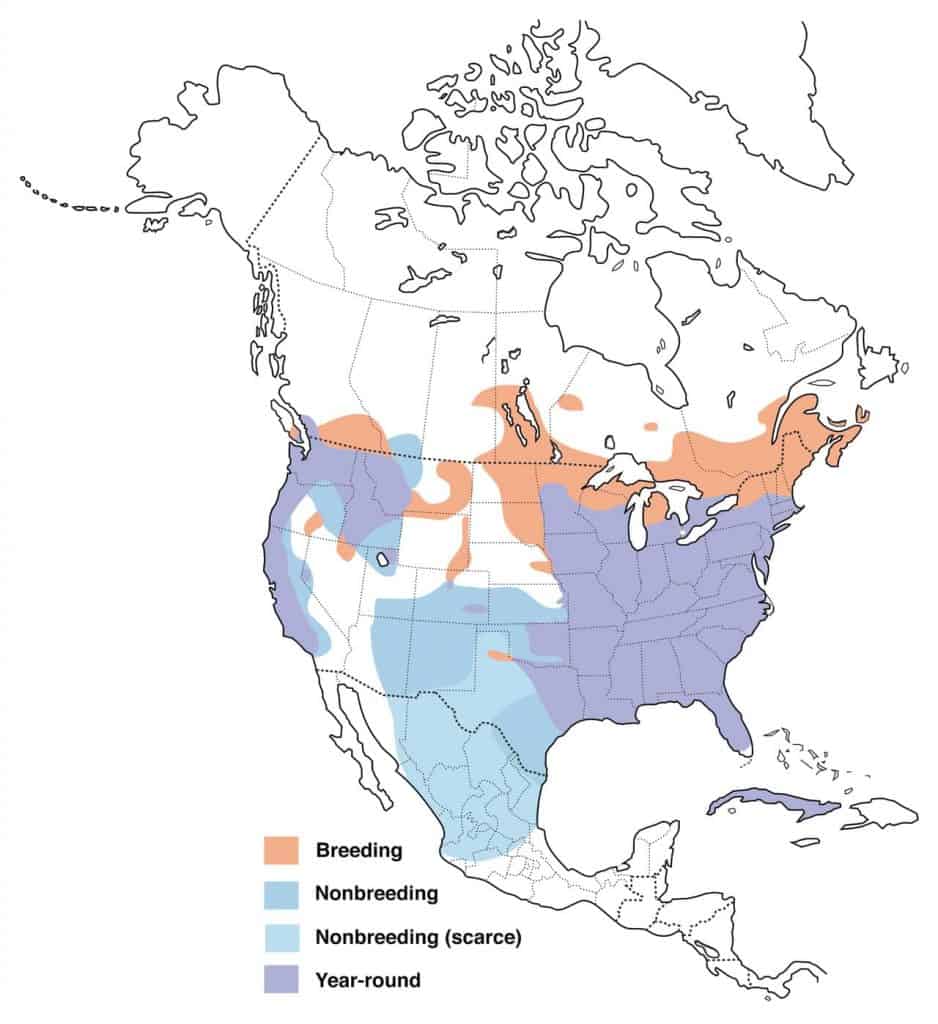
Yellow Warbler
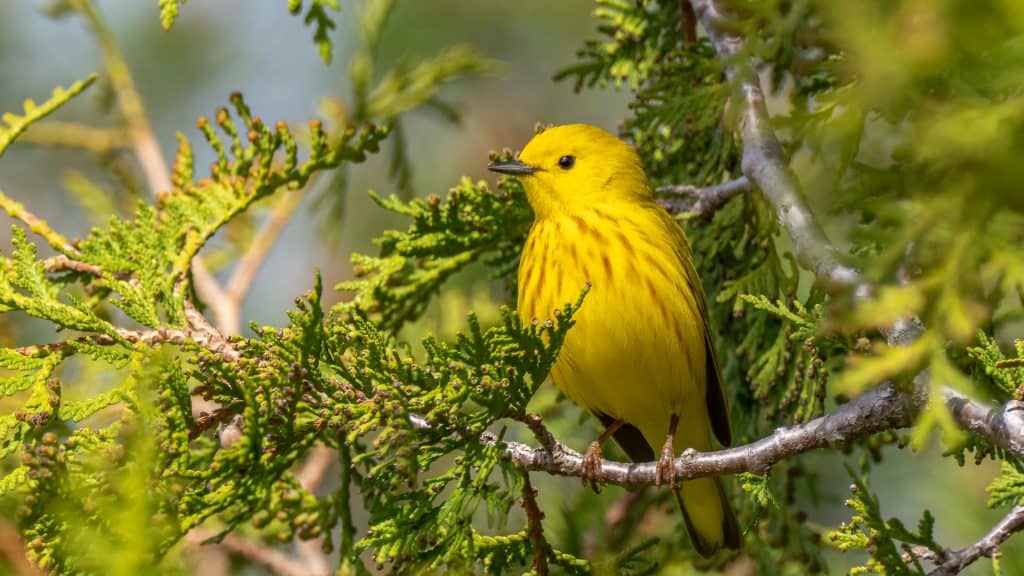
Appearance: The yellow warbler is a small bird about 5″ long primarily yellow with orange streaks on the chest and belly, and black-streaked wings. Bill is long, pointy, and gray. The Female is a muted olive-green version of the male without the orange chest.
Diet: Insects
Feeder food: Unlikely to visit a feeder.
Habitat: Shrubby areas and gardens, willows, wet thickets, and roadsides.
Nesting: Yellow warblers construct a cup-shaped nest to raise 1 brood/year. They have 4-5 eggs/brood that are white with brown markings. Incubation lasts 11-12 days.
Migration: Yellow warblers are migrators. In the spring, they migrate north to breed and raise their young. Then in the fall, they migrate back south for the winter.
Breeding range: All US states except Texas, Louisiana, Mississippi, and Florida. Also, all of Canada as well as central Mexico.
Winter range: Along the California and Arizona state lines, Pacific and Atlantic coasts of Mexico, Central America, and South America.
Range Map
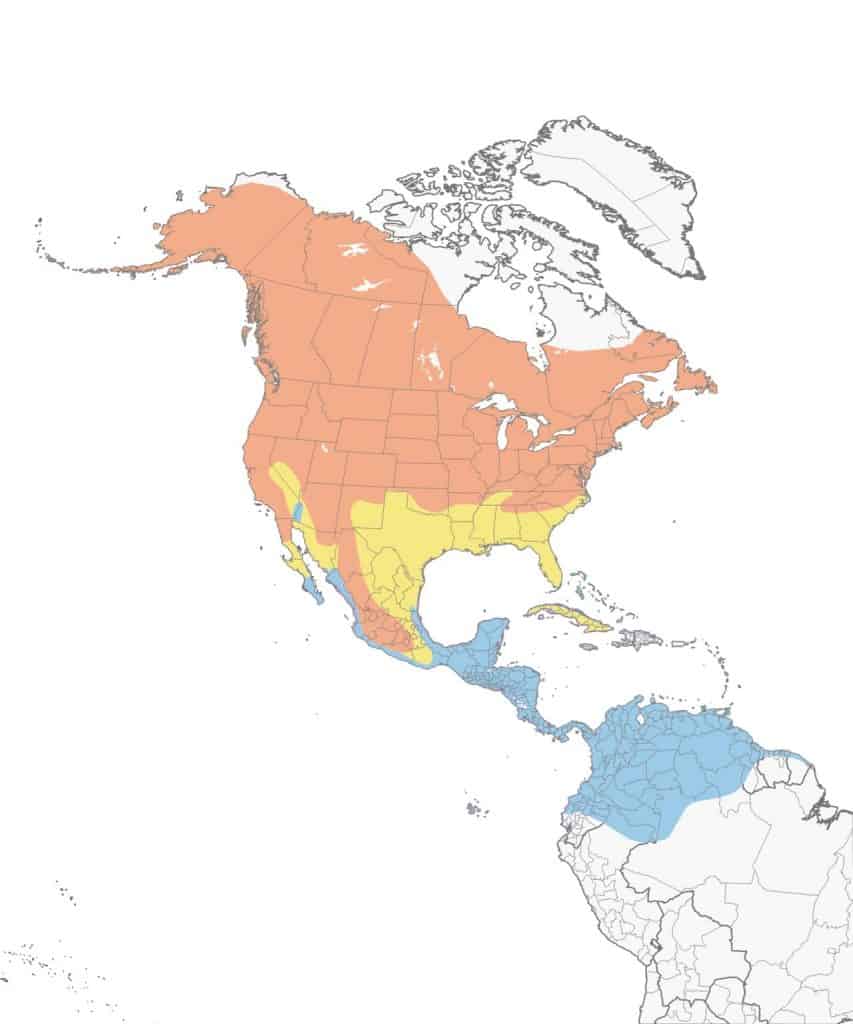
Yellow-Rumped Warbler
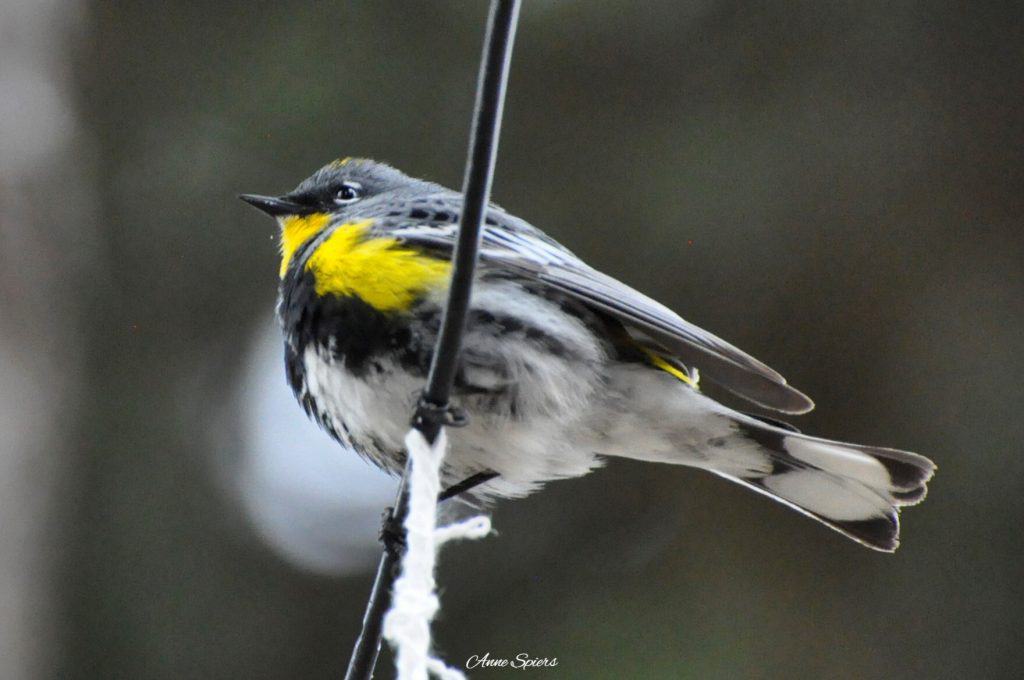
Appearance: The male yellow-rumped warbler is slate gray with a black mask and beak. Yellow patches on the sides of its lower belly, head, and rump. White and gray striped throughout chest and belly. The female is similar but duller in color and browner than she is slate gray.
Diet: Insects, berries.
Feeder food: Peanuts, mealworms, nectar, fruit, suet with peanut butter.
Habitat: Just about anywhere as they are very adaptable. Found in woods, bogs, forest and wooded edges, coniferous and deciduous trees, and wide-open areas.
Nesting: The female builds a cup-shaped nest in a tree, has 2 broods per year, 4-5 eggs per brood, and eggs are white with brown spots and incubated between 12-13 days.
Migration: Yellow-rumped warblers are migrators. In the spring, they migrate north and west to breed and raise their young. Then in the fall, they migrate south and east for the winter. A small population of yellow-rumped warblers remains in their tiny year-round range every season of the year.
Breeding range:
Winter range: Southeast corner of Washington & Oregon, southern California, western Arizona, eastern New Mexico, Texas, Oklahoma, Missouri, Illinois, and the remaining southeast US states. Also, Mexico and Central America.
Year-round range: Western Washington, eastern Oregon, western California, southeast Nevada, southeast Arizona, and southern New Mexico.
Range Map
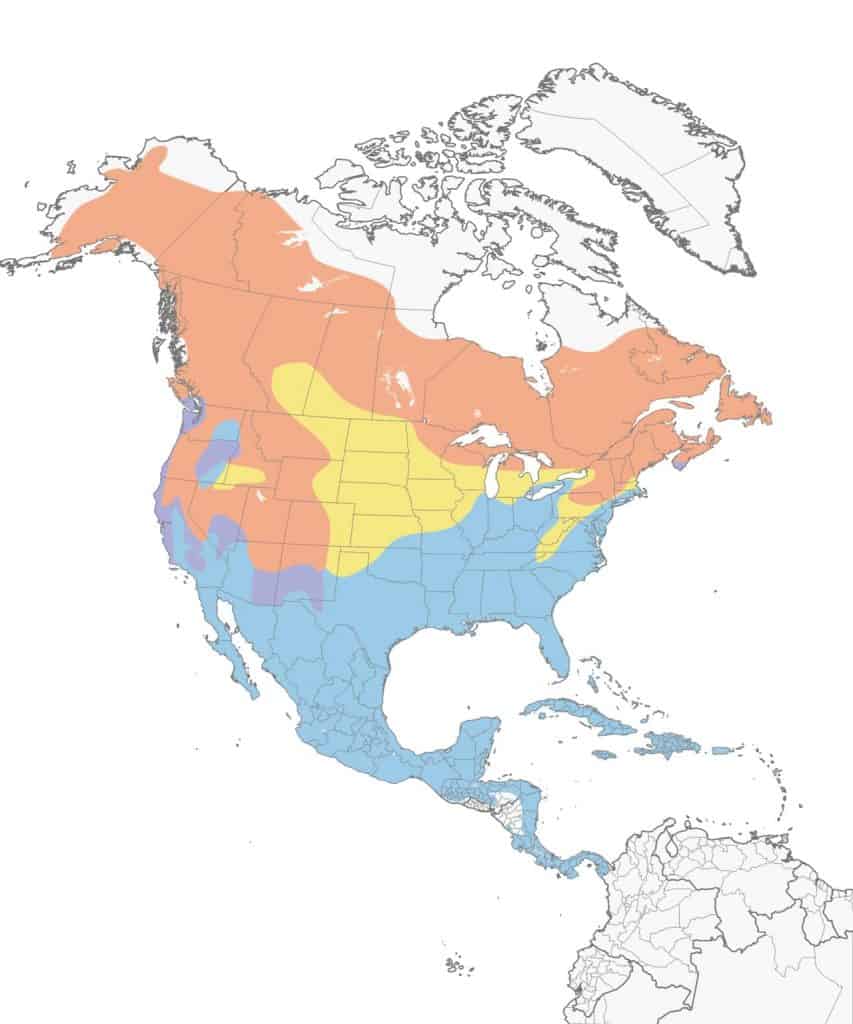
Montanans are lucky – they get to experience so many different species of birds that live there or are just passing through. Keep this article handy. When you see an amazing wild bird I guarantee you’ll want to know the species and details about it. Trust me!
Happy Birding!
Sources
All About Birds. The Cornell Lab of Ornithology. 2021
eBird. The Cornell Lab of Ornithology. 2021
Noah, Strycker, and Alderfer Jonathan. National Geographic Backyard Guide to the Birds of North America. 2nd ed., National Geographic, 2019.

